Vessels 19th century ships Stock Photos and Images
(1,005)See vessels 19th century ships stock video clipsQuick filters:
Vessels 19th century ships Stock Photos and Images
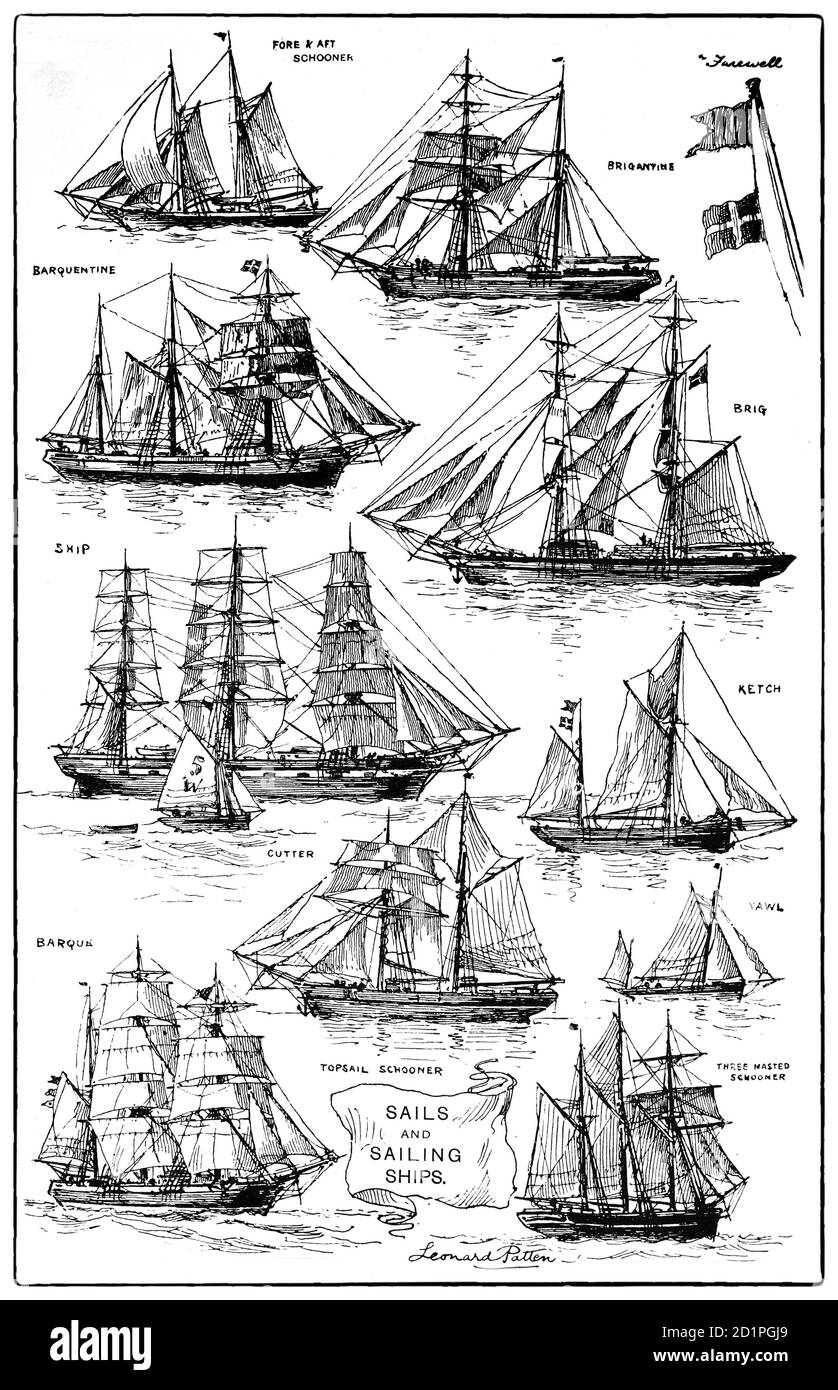 A late 19th Century chart illustrating types of sailing ships and their sail formations Stock Photohttps://www.alamy.com/image-license-details/?v=1https://www.alamy.com/a-late-19th-century-chart-illustrating-types-of-sailing-ships-and-their-sail-formations-image379738753.html
A late 19th Century chart illustrating types of sailing ships and their sail formations Stock Photohttps://www.alamy.com/image-license-details/?v=1https://www.alamy.com/a-late-19th-century-chart-illustrating-types-of-sailing-ships-and-their-sail-formations-image379738753.htmlRM2D1PGJ9–A late 19th Century chart illustrating types of sailing ships and their sail formations
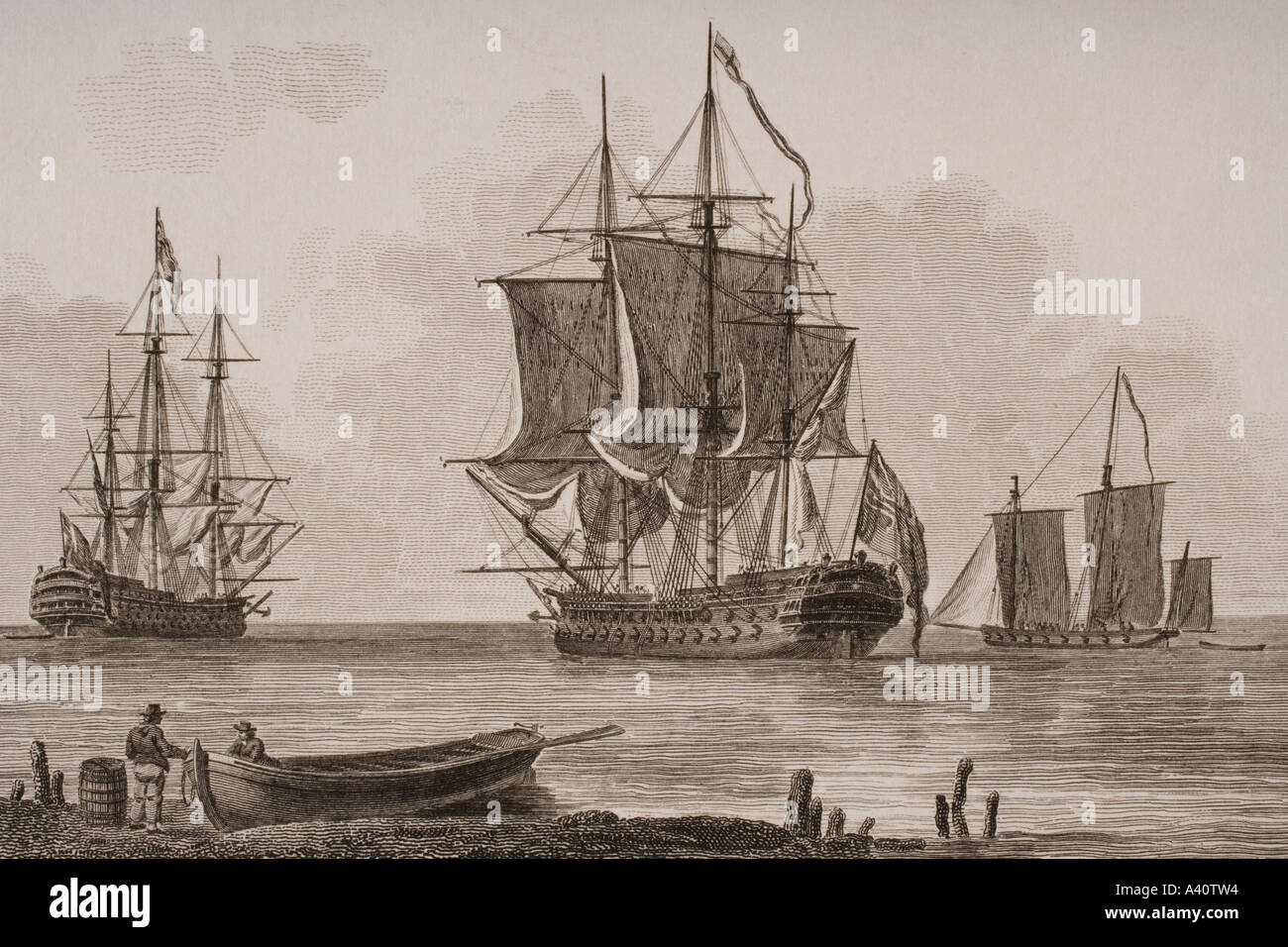 British navy vessels from the 18th and 19th century. From a print dated 1820 engraved by Milton Stock Photohttps://www.alamy.com/image-license-details/?v=1https://www.alamy.com/british-navy-vessels-from-the-18th-and-19th-century-from-a-print-dated-image6226579.html
British navy vessels from the 18th and 19th century. From a print dated 1820 engraved by Milton Stock Photohttps://www.alamy.com/image-license-details/?v=1https://www.alamy.com/british-navy-vessels-from-the-18th-and-19th-century-from-a-print-dated-image6226579.htmlRMA40TW4–British navy vessels from the 18th and 19th century. From a print dated 1820 engraved by Milton
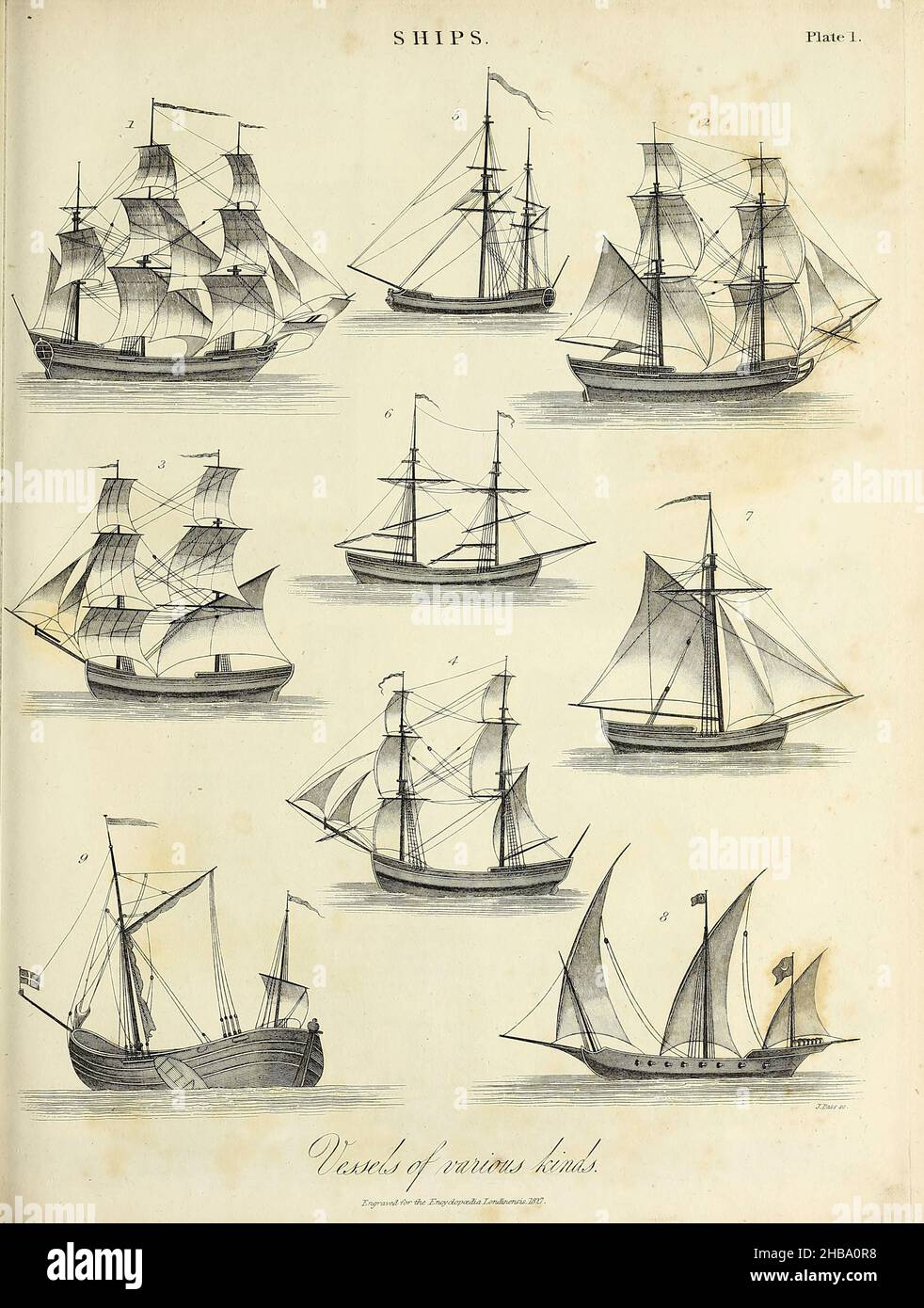 Illustration of ships and vessels of various kinds. Copperplate engraving from the 'Encyclopaedia Londinensis, or, Universal Dictionary of Arts, Sciences and Literature; Volume XXIII. Edited by John Wilkes. Published in London, Great, Britain, in 1828. Stock Photohttps://www.alamy.com/image-license-details/?v=1https://www.alamy.com/illustration-of-ships-and-vessels-of-various-kinds-copperplate-engraving-from-the-encyclopaedia-londinensis-or-universal-dictionary-of-arts-sciences-and-literature-volume-xxiii-edited-by-john-wilkes-published-in-london-great-britain-in-1828-image454450956.html
Illustration of ships and vessels of various kinds. Copperplate engraving from the 'Encyclopaedia Londinensis, or, Universal Dictionary of Arts, Sciences and Literature; Volume XXIII. Edited by John Wilkes. Published in London, Great, Britain, in 1828. Stock Photohttps://www.alamy.com/image-license-details/?v=1https://www.alamy.com/illustration-of-ships-and-vessels-of-various-kinds-copperplate-engraving-from-the-encyclopaedia-londinensis-or-universal-dictionary-of-arts-sciences-and-literature-volume-xxiii-edited-by-john-wilkes-published-in-london-great-britain-in-1828-image454450956.htmlRF2HBA0R8–Illustration of ships and vessels of various kinds. Copperplate engraving from the 'Encyclopaedia Londinensis, or, Universal Dictionary of Arts, Sciences and Literature; Volume XXIII. Edited by John Wilkes. Published in London, Great, Britain, in 1828.
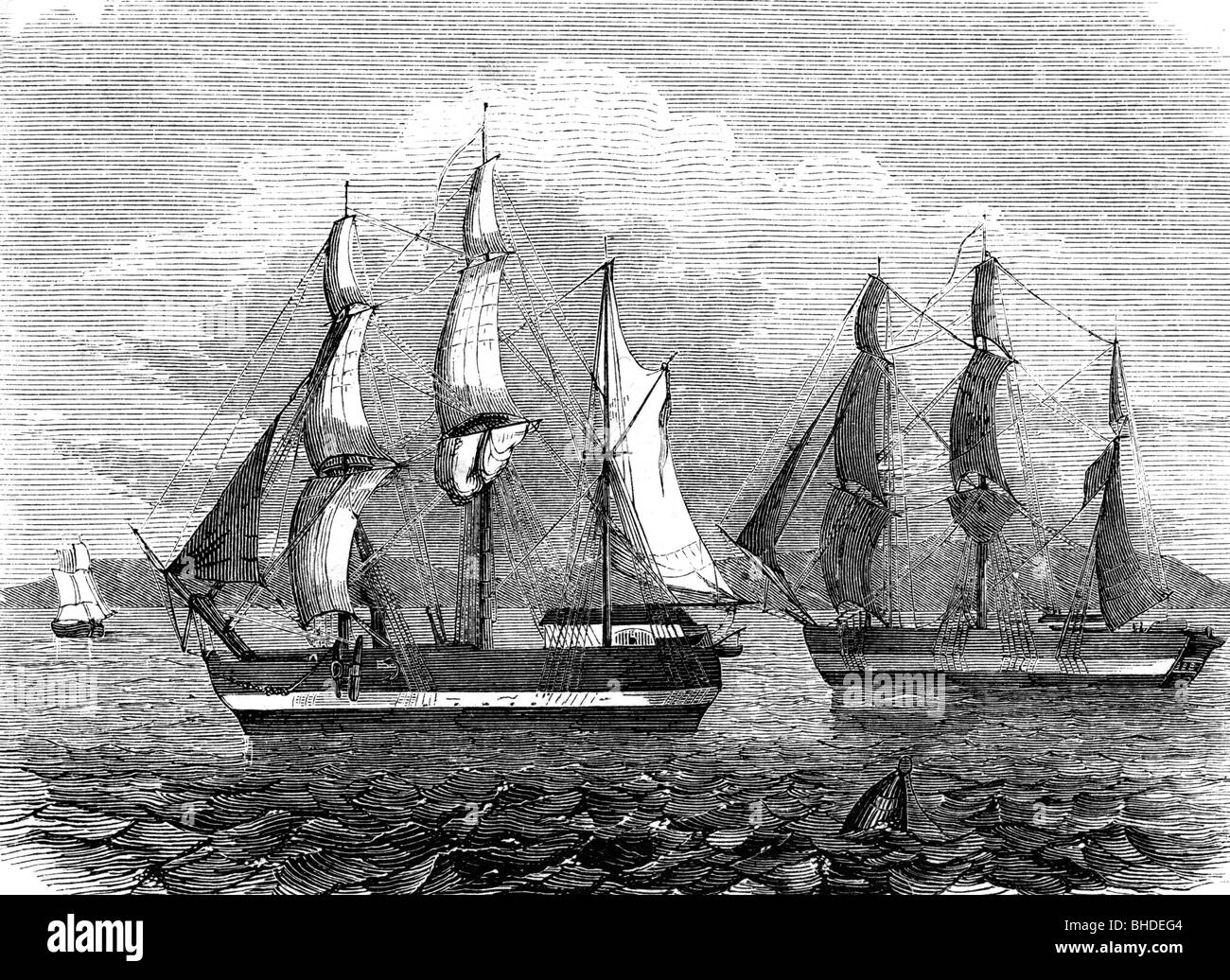 Franklin, John, 16.4.1786 - 11.6.1847, British Arctic explorer, expedition to the Arctic 1844 - 1846, vessels 'Erebus' and 'Terror', wood engraving, 19th century, Stock Photohttps://www.alamy.com/image-license-details/?v=1https://www.alamy.com/stock-photo-franklin-john-1641786-1161847-british-arctic-explorer-expedition-to-27956324.html
Franklin, John, 16.4.1786 - 11.6.1847, British Arctic explorer, expedition to the Arctic 1844 - 1846, vessels 'Erebus' and 'Terror', wood engraving, 19th century, Stock Photohttps://www.alamy.com/image-license-details/?v=1https://www.alamy.com/stock-photo-franklin-john-1641786-1161847-british-arctic-explorer-expedition-to-27956324.htmlRMBHDEG4–Franklin, John, 16.4.1786 - 11.6.1847, British Arctic explorer, expedition to the Arctic 1844 - 1846, vessels 'Erebus' and 'Terror', wood engraving, 19th century,
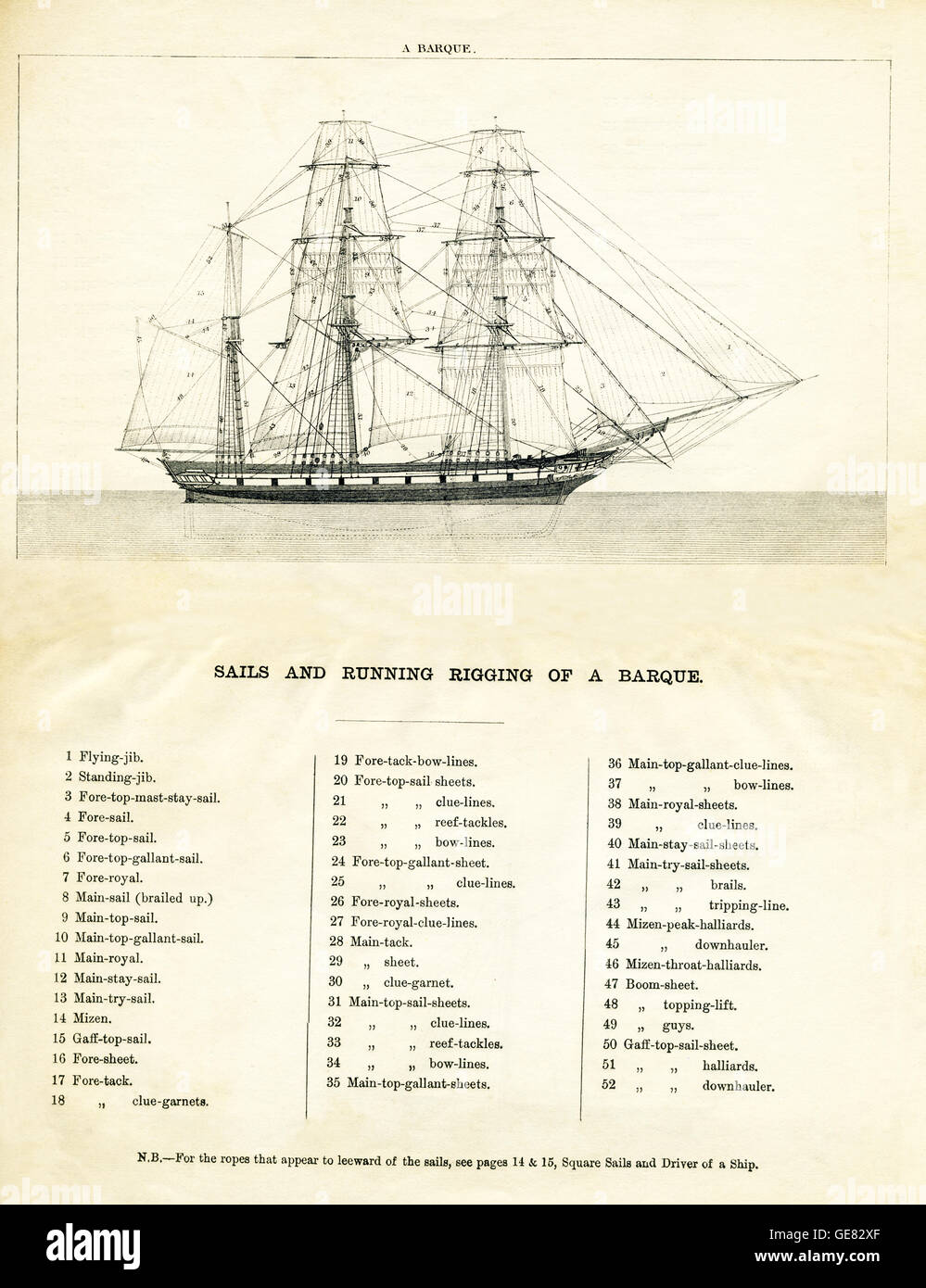 This 19th-century drawing shows the sails and running rig of a barque. Stock Photohttps://www.alamy.com/image-license-details/?v=1https://www.alamy.com/stock-photo-this-19th-century-drawing-shows-the-sails-and-running-rig-of-a-barque-112045319.html
This 19th-century drawing shows the sails and running rig of a barque. Stock Photohttps://www.alamy.com/image-license-details/?v=1https://www.alamy.com/stock-photo-this-19th-century-drawing-shows-the-sails-and-running-rig-of-a-barque-112045319.htmlRFGE82XF–This 19th-century drawing shows the sails and running rig of a barque.
 Vintage photo of a Canton junk. Illustration of Qing China, 1875 The term junk, applied by Europeans to all Chinese craft, whether trading vessels or ships of war, is probably derived from 'jung', the Javanese word for a large boat or vessel. Chinese ships vary in dimensions, model, and appearance, in the different parts of the Empire as much as do the sailing craft of Europe. The vessel under sail on the left of the photograph is a coasting trader of Kwang-tung build, and may be regarded as one of the clipper fleet of Southern China. It looks heavy and unhandy, but it will make good sailing w Stock Photohttps://www.alamy.com/image-license-details/?v=1https://www.alamy.com/vintage-photo-of-a-canton-junk-illustration-of-qing-china-1875-the-term-junk-applied-by-europeans-to-all-chinese-craft-whether-trading-vessels-or-ships-of-war-is-probably-derived-from-jung-the-javanese-word-for-a-large-boat-or-vessel-chinese-ships-vary-in-dimensions-model-and-appearance-in-the-different-parts-of-the-empire-as-much-as-do-the-sailing-craft-of-europe-the-vessel-under-sail-on-the-left-of-the-photograph-is-a-coasting-trader-of-kwang-tung-build-and-may-be-regarded-as-one-of-the-clipper-fleet-of-southern-china-it-looks-heavy-and-unhandy-but-it-will-make-good-sailing-w-image618362457.html
Vintage photo of a Canton junk. Illustration of Qing China, 1875 The term junk, applied by Europeans to all Chinese craft, whether trading vessels or ships of war, is probably derived from 'jung', the Javanese word for a large boat or vessel. Chinese ships vary in dimensions, model, and appearance, in the different parts of the Empire as much as do the sailing craft of Europe. The vessel under sail on the left of the photograph is a coasting trader of Kwang-tung build, and may be regarded as one of the clipper fleet of Southern China. It looks heavy and unhandy, but it will make good sailing w Stock Photohttps://www.alamy.com/image-license-details/?v=1https://www.alamy.com/vintage-photo-of-a-canton-junk-illustration-of-qing-china-1875-the-term-junk-applied-by-europeans-to-all-chinese-craft-whether-trading-vessels-or-ships-of-war-is-probably-derived-from-jung-the-javanese-word-for-a-large-boat-or-vessel-chinese-ships-vary-in-dimensions-model-and-appearance-in-the-different-parts-of-the-empire-as-much-as-do-the-sailing-craft-of-europe-the-vessel-under-sail-on-the-left-of-the-photograph-is-a-coasting-trader-of-kwang-tung-build-and-may-be-regarded-as-one-of-the-clipper-fleet-of-southern-china-it-looks-heavy-and-unhandy-but-it-will-make-good-sailing-w-image618362457.htmlRM2XX0RHD–Vintage photo of a Canton junk. Illustration of Qing China, 1875 The term junk, applied by Europeans to all Chinese craft, whether trading vessels or ships of war, is probably derived from 'jung', the Javanese word for a large boat or vessel. Chinese ships vary in dimensions, model, and appearance, in the different parts of the Empire as much as do the sailing craft of Europe. The vessel under sail on the left of the photograph is a coasting trader of Kwang-tung build, and may be regarded as one of the clipper fleet of Southern China. It looks heavy and unhandy, but it will make good sailing w
![[ 1890s Japan - Japanese Cargo Vessel under Sail ] — Cargo vessel under sail. 19th century vintage albumen photograph. Stock Photo [ 1890s Japan - Japanese Cargo Vessel under Sail ] — Cargo vessel under sail. 19th century vintage albumen photograph. Stock Photo](https://c8.alamy.com/comp/PH0ER6/1890s-japan-japanese-cargo-vessel-under-sail-cargo-vessel-under-sail-19th-century-vintage-albumen-photograph-PH0ER6.jpg) [ 1890s Japan - Japanese Cargo Vessel under Sail ] — Cargo vessel under sail. 19th century vintage albumen photograph. Stock Photohttps://www.alamy.com/image-license-details/?v=1https://www.alamy.com/1890s-japan-japanese-cargo-vessel-under-sail-cargo-vessel-under-sail-19th-century-vintage-albumen-photograph-image216985194.html
[ 1890s Japan - Japanese Cargo Vessel under Sail ] — Cargo vessel under sail. 19th century vintage albumen photograph. Stock Photohttps://www.alamy.com/image-license-details/?v=1https://www.alamy.com/1890s-japan-japanese-cargo-vessel-under-sail-cargo-vessel-under-sail-19th-century-vintage-albumen-photograph-image216985194.htmlRMPH0ER6–[ 1890s Japan - Japanese Cargo Vessel under Sail ] — Cargo vessel under sail. 19th century vintage albumen photograph.
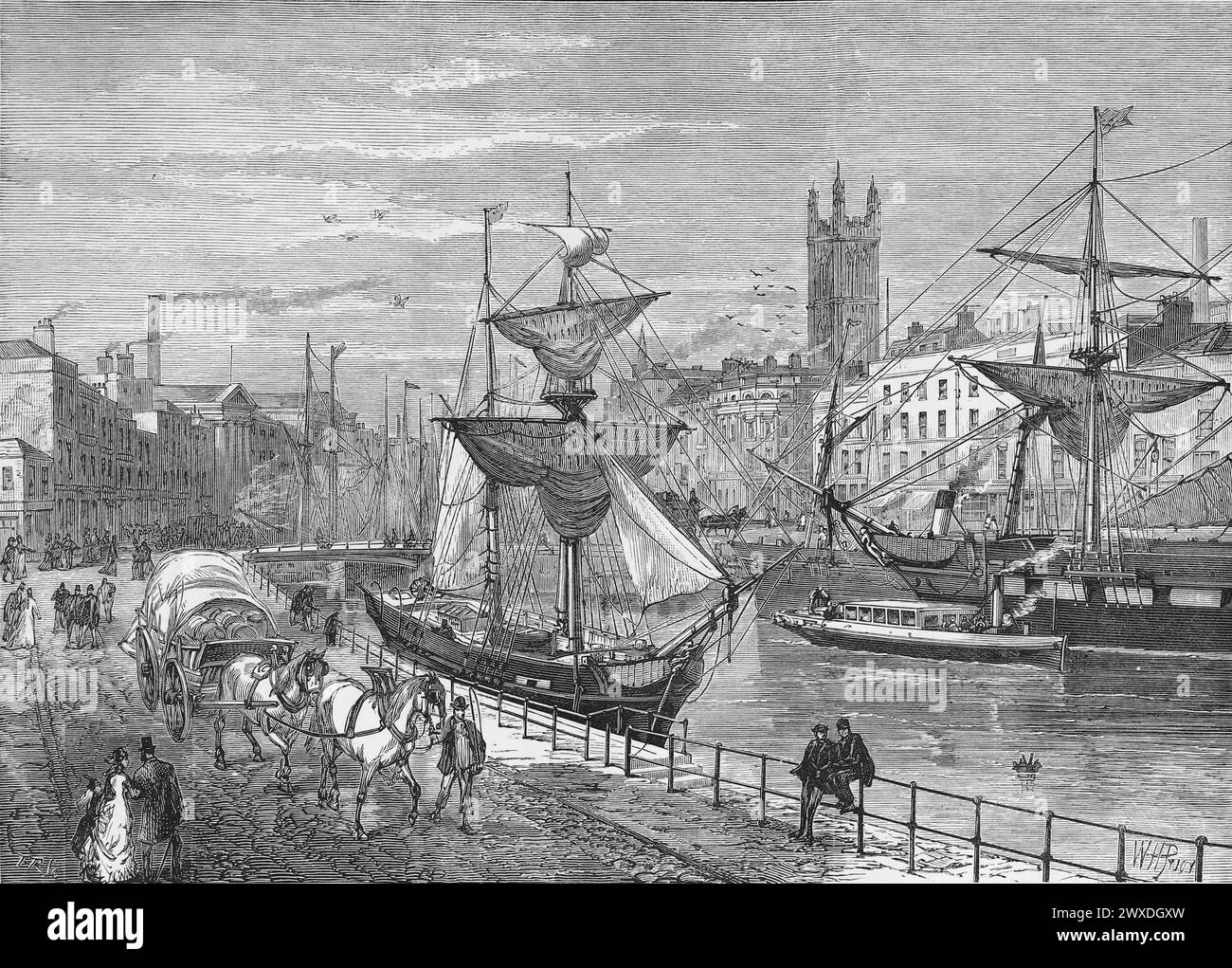 Bristol from St Augustine's Quay; Black and White Illustration from the 'Our Own Country' published by Cassell, Petter, Galpin & Co. Late 19th century. Stock Photohttps://www.alamy.com/image-license-details/?v=1https://www.alamy.com/bristol-from-st-augustines-quay-black-and-white-illustration-from-the-our-own-country-published-by-cassell-petter-galpin-co-late-19th-century-image601432241.html
Bristol from St Augustine's Quay; Black and White Illustration from the 'Our Own Country' published by Cassell, Petter, Galpin & Co. Late 19th century. Stock Photohttps://www.alamy.com/image-license-details/?v=1https://www.alamy.com/bristol-from-st-augustines-quay-black-and-white-illustration-from-the-our-own-country-published-by-cassell-petter-galpin-co-late-19th-century-image601432241.htmlRM2WXDGXW–Bristol from St Augustine's Quay; Black and White Illustration from the 'Our Own Country' published by Cassell, Petter, Galpin & Co. Late 19th century.
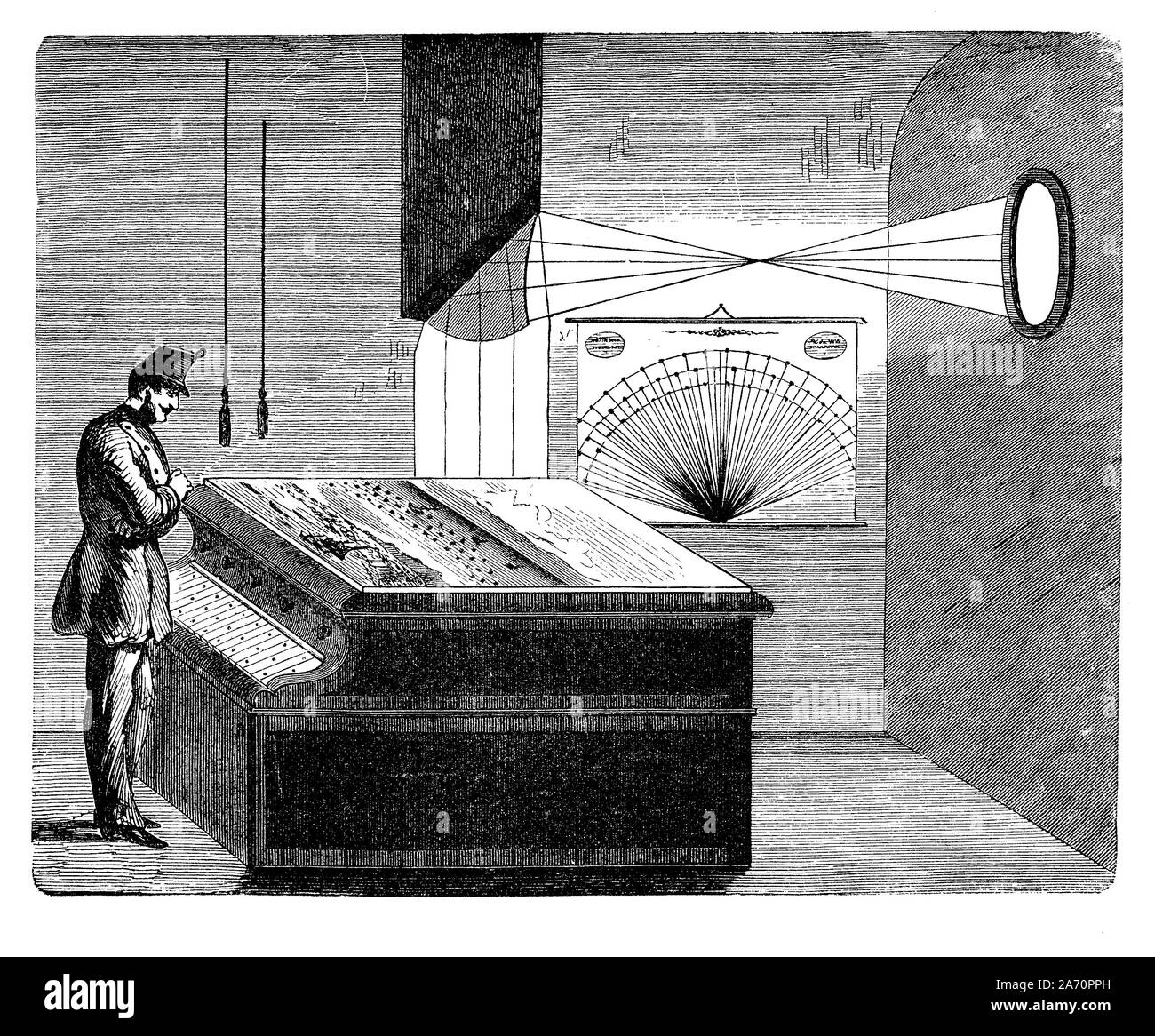 Defense monitor room of Trieste harbor in the 19th century: ingenious system with optics, mechanics and submarine electric wires combined to detect enemy ships or submarine vessels and their position Stock Photohttps://www.alamy.com/image-license-details/?v=1https://www.alamy.com/defense-monitor-room-of-trieste-harbor-in-the-19th-century-ingenious-system-with-optics-mechanics-and-submarine-electric-wires-combined-to-detect-enemy-ships-or-submarine-vessels-and-their-position-image331317465.html
Defense monitor room of Trieste harbor in the 19th century: ingenious system with optics, mechanics and submarine electric wires combined to detect enemy ships or submarine vessels and their position Stock Photohttps://www.alamy.com/image-license-details/?v=1https://www.alamy.com/defense-monitor-room-of-trieste-harbor-in-the-19th-century-ingenious-system-with-optics-mechanics-and-submarine-electric-wires-combined-to-detect-enemy-ships-or-submarine-vessels-and-their-position-image331317465.htmlRF2A70PPH–Defense monitor room of Trieste harbor in the 19th century: ingenious system with optics, mechanics and submarine electric wires combined to detect enemy ships or submarine vessels and their position
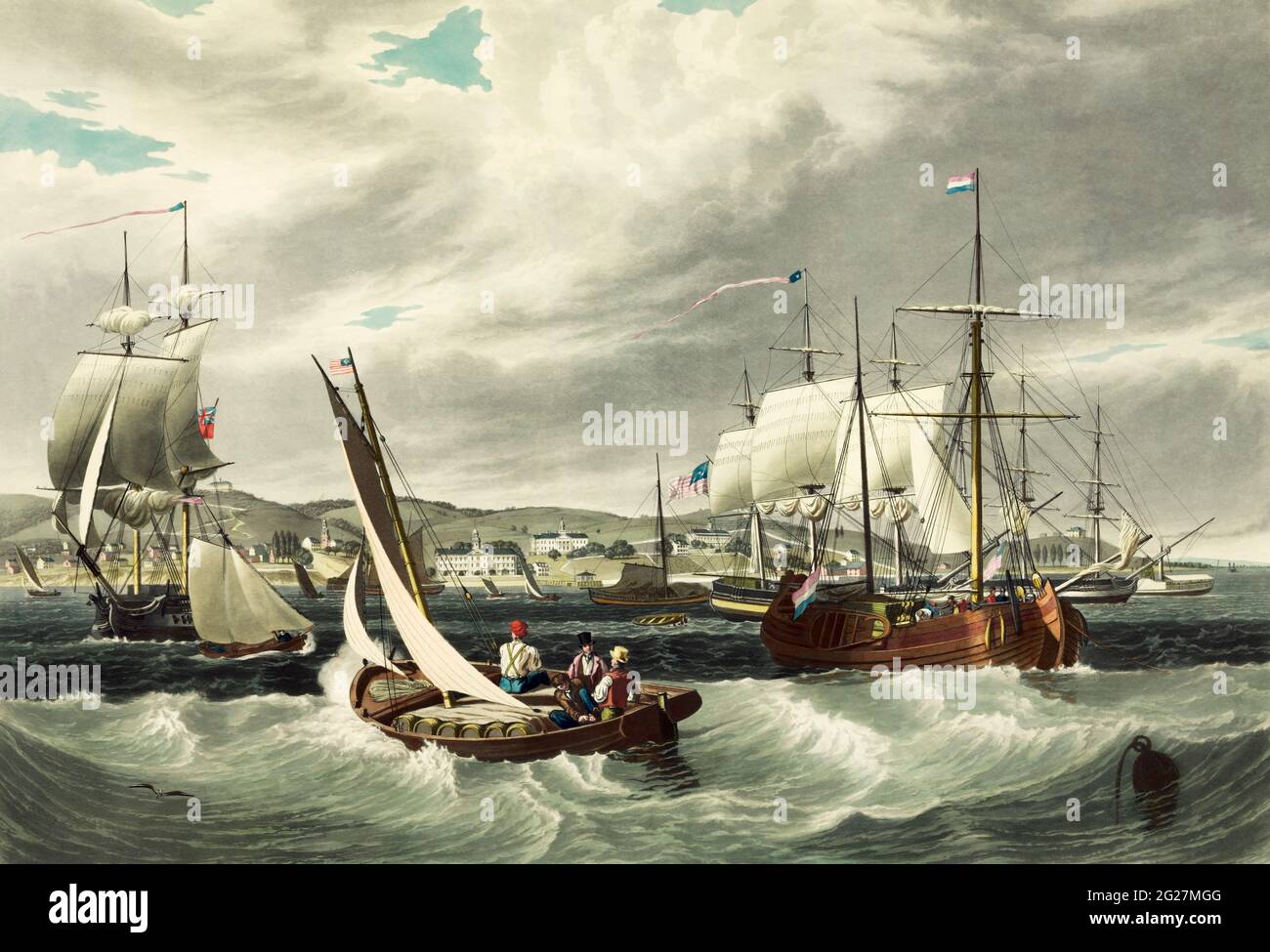 19th century artwork of ships and boats offshore of the New York quarantine station Swinburne Island. Stock Photohttps://www.alamy.com/image-license-details/?v=1https://www.alamy.com/19th-century-artwork-of-ships-and-boats-offshore-of-the-new-york-quarantine-station-swinburne-island-image431658320.html
19th century artwork of ships and boats offshore of the New York quarantine station Swinburne Island. Stock Photohttps://www.alamy.com/image-license-details/?v=1https://www.alamy.com/19th-century-artwork-of-ships-and-boats-offshore-of-the-new-york-quarantine-station-swinburne-island-image431658320.htmlRF2G27MGG–19th century artwork of ships and boats offshore of the New York quarantine station Swinburne Island.
 FOOD. Seed Fruit & Seed Vessels 1880 old antique vintage print picture Stock Photohttps://www.alamy.com/image-license-details/?v=1https://www.alamy.com/food-seed-fruit-seed-vessels-1880-old-antique-vintage-print-picture-image183049774.html
FOOD. Seed Fruit & Seed Vessels 1880 old antique vintage print picture Stock Photohttps://www.alamy.com/image-license-details/?v=1https://www.alamy.com/food-seed-fruit-seed-vessels-1880-old-antique-vintage-print-picture-image183049774.htmlRFMHPHRX–FOOD. Seed Fruit & Seed Vessels 1880 old antique vintage print picture
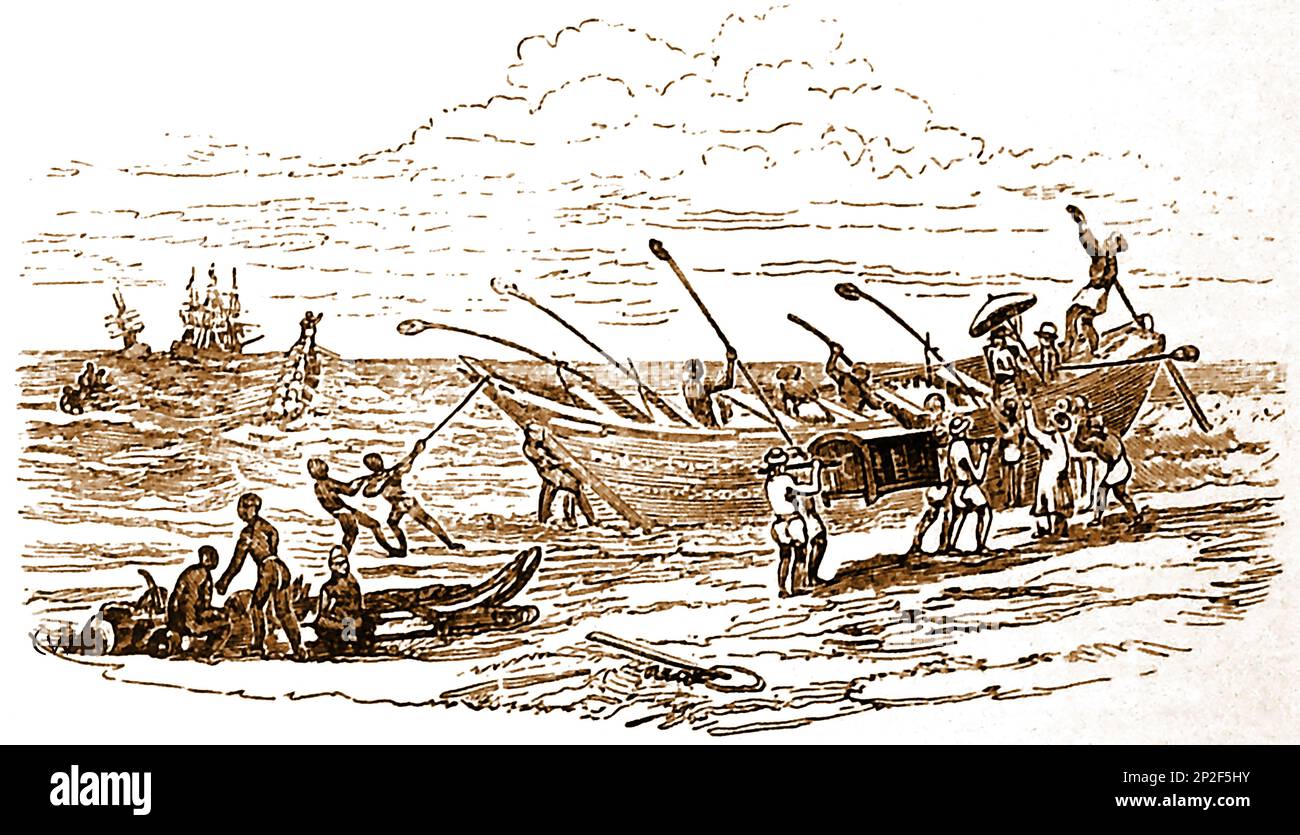 A 19th century illustration of an Indian Masoola boat used for transporting passengers and goods to shore from visiting sailing ships, Masoolas are traditionally made of planks sewed together with strands of coir and cross over a wadding and used at Madras and other places in India, 19 ஆம் நூற்றாண்டில் பாய்மரக் கப்பல்களில் இருந்து பயணிகளையும் பொருட்களையும் கரைக்கு கொண்டு செல்லப் பயன்படுத்தப்படும் இந்திய மசூலா படகின் எடுத்துக்காட்டு Stock Photohttps://www.alamy.com/image-license-details/?v=1https://www.alamy.com/a-19th-century-illustration-of-an-indian-masoola-boat-used-for-transporting-passengers-and-goods-to-shore-from-visiting-sailing-ships-masoolas-are-traditionally-made-of-planks-sewed-together-with-strands-of-coir-and-cross-over-a-wadding-and-used-at-madras-and-other-places-in-india-19-image535084423.html
A 19th century illustration of an Indian Masoola boat used for transporting passengers and goods to shore from visiting sailing ships, Masoolas are traditionally made of planks sewed together with strands of coir and cross over a wadding and used at Madras and other places in India, 19 ஆம் நூற்றாண்டில் பாய்மரக் கப்பல்களில் இருந்து பயணிகளையும் பொருட்களையும் கரைக்கு கொண்டு செல்லப் பயன்படுத்தப்படும் இந்திய மசூலா படகின் எடுத்துக்காட்டு Stock Photohttps://www.alamy.com/image-license-details/?v=1https://www.alamy.com/a-19th-century-illustration-of-an-indian-masoola-boat-used-for-transporting-passengers-and-goods-to-shore-from-visiting-sailing-ships-masoolas-are-traditionally-made-of-planks-sewed-together-with-strands-of-coir-and-cross-over-a-wadding-and-used-at-madras-and-other-places-in-india-19-image535084423.htmlRM2P2F5HY–A 19th century illustration of an Indian Masoola boat used for transporting passengers and goods to shore from visiting sailing ships, Masoolas are traditionally made of planks sewed together with strands of coir and cross over a wadding and used at Madras and other places in India, 19 ஆம் நூற்றாண்டில் பாய்மரக் கப்பல்களில் இருந்து பயணிகளையும் பொருட்களையும் கரைக்கு கொண்டு செல்லப் பயன்படுத்தப்படும் இந்திய மசூலா படகின் எடுத்துக்காட்டு
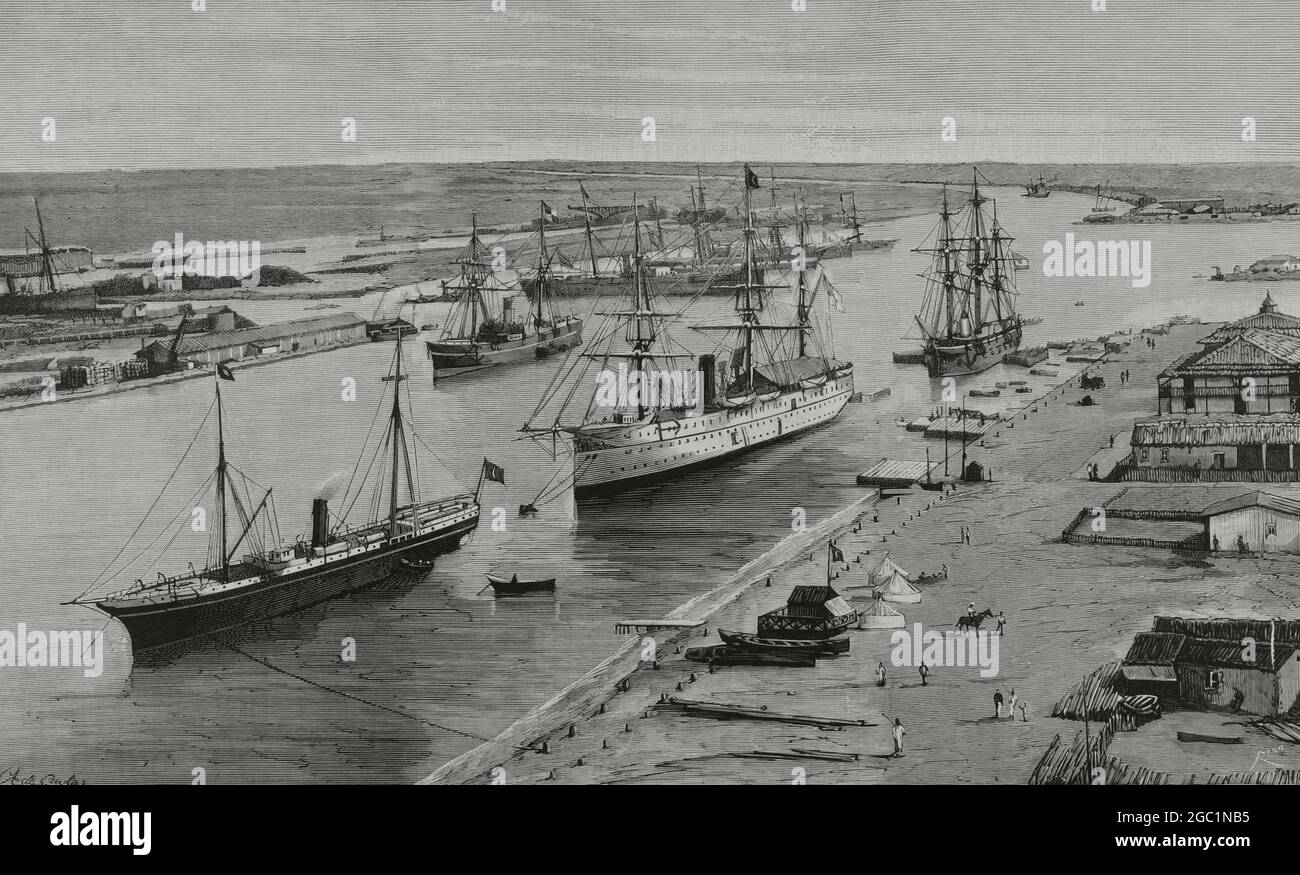 Egypt. Suez Canal near Port-Said. Drawing by Caula. Engraving by Rico. La Ilustración Española y Americana, 1882. Stock Photohttps://www.alamy.com/image-license-details/?v=1https://www.alamy.com/egypt-suez-canal-near-port-said-drawing-by-caula-engraving-by-rico-la-ilustracin-espaola-y-americana-1882-image437673801.html
Egypt. Suez Canal near Port-Said. Drawing by Caula. Engraving by Rico. La Ilustración Española y Americana, 1882. Stock Photohttps://www.alamy.com/image-license-details/?v=1https://www.alamy.com/egypt-suez-canal-near-port-said-drawing-by-caula-engraving-by-rico-la-ilustracin-espaola-y-americana-1882-image437673801.htmlRM2GC1NB5–Egypt. Suez Canal near Port-Said. Drawing by Caula. Engraving by Rico. La Ilustración Española y Americana, 1882.
 This vintage photograph captures a man in 19th-century attire, including a bowler hat, standing beside large gears and pipes on what appears to be the deck of a steamship. The maritime setting and his clothing suggest a late 1800s to early 1900s time frame, likely during the peak of steam-powered vessels. The image provides a rare glimpse into historical seafaring technology and life on ships, preserving a piece of the industrial and maritime history of the era. Stock Photohttps://www.alamy.com/image-license-details/?v=1https://www.alamy.com/this-vintage-photograph-captures-a-man-in-19th-century-attire-including-a-bowler-hat-standing-beside-large-gears-and-pipes-on-what-appears-to-be-the-deck-of-a-steamship-the-maritime-setting-and-his-clothing-suggest-a-late-1800s-to-early-1900s-time-frame-likely-during-the-peak-of-steam-powered-vessels-the-image-provides-a-rare-glimpse-into-historical-seafaring-technology-and-life-on-ships-preserving-a-piece-of-the-industrial-and-maritime-history-of-the-era-image629810479.html
This vintage photograph captures a man in 19th-century attire, including a bowler hat, standing beside large gears and pipes on what appears to be the deck of a steamship. The maritime setting and his clothing suggest a late 1800s to early 1900s time frame, likely during the peak of steam-powered vessels. The image provides a rare glimpse into historical seafaring technology and life on ships, preserving a piece of the industrial and maritime history of the era. Stock Photohttps://www.alamy.com/image-license-details/?v=1https://www.alamy.com/this-vintage-photograph-captures-a-man-in-19th-century-attire-including-a-bowler-hat-standing-beside-large-gears-and-pipes-on-what-appears-to-be-the-deck-of-a-steamship-the-maritime-setting-and-his-clothing-suggest-a-late-1800s-to-early-1900s-time-frame-likely-during-the-peak-of-steam-powered-vessels-the-image-provides-a-rare-glimpse-into-historical-seafaring-technology-and-life-on-ships-preserving-a-piece-of-the-industrial-and-maritime-history-of-the-era-image629810479.htmlRF2YGJ9KB–This vintage photograph captures a man in 19th-century attire, including a bowler hat, standing beside large gears and pipes on what appears to be the deck of a steamship. The maritime setting and his clothing suggest a late 1800s to early 1900s time frame, likely during the peak of steam-powered vessels. The image provides a rare glimpse into historical seafaring technology and life on ships, preserving a piece of the industrial and maritime history of the era.
 The Narrows, New York Harbour, including sailing vessels, from an engraving originally in Harper’s Magazine (signatures indistinct). From a nineteenth century travelogue of the United States of America, published in 1891, this is a photograph of one of a number of engravings (many by Edward Whymper) used to illustrate aspects of the social history, architecture, topography and geography of the USA. Stock Photohttps://www.alamy.com/image-license-details/?v=1https://www.alamy.com/the-narrows-new-york-harbour-including-sailing-vessels-from-an-engraving-originally-in-harpers-magazine-signatures-indistinct-from-a-nineteenth-century-travelogue-of-the-united-states-of-america-published-in-1891-this-is-a-photograph-of-one-of-a-number-of-engravings-many-by-edward-whymper-used-to-illustrate-aspects-of-the-social-history-architecture-topography-and-geography-of-the-usa-image629346447.html
The Narrows, New York Harbour, including sailing vessels, from an engraving originally in Harper’s Magazine (signatures indistinct). From a nineteenth century travelogue of the United States of America, published in 1891, this is a photograph of one of a number of engravings (many by Edward Whymper) used to illustrate aspects of the social history, architecture, topography and geography of the USA. Stock Photohttps://www.alamy.com/image-license-details/?v=1https://www.alamy.com/the-narrows-new-york-harbour-including-sailing-vessels-from-an-engraving-originally-in-harpers-magazine-signatures-indistinct-from-a-nineteenth-century-travelogue-of-the-united-states-of-america-published-in-1891-this-is-a-photograph-of-one-of-a-number-of-engravings-many-by-edward-whymper-used-to-illustrate-aspects-of-the-social-history-architecture-topography-and-geography-of-the-usa-image629346447.htmlRM2YFW5PR–The Narrows, New York Harbour, including sailing vessels, from an engraving originally in Harper’s Magazine (signatures indistinct). From a nineteenth century travelogue of the United States of America, published in 1891, this is a photograph of one of a number of engravings (many by Edward Whymper) used to illustrate aspects of the social history, architecture, topography and geography of the USA.
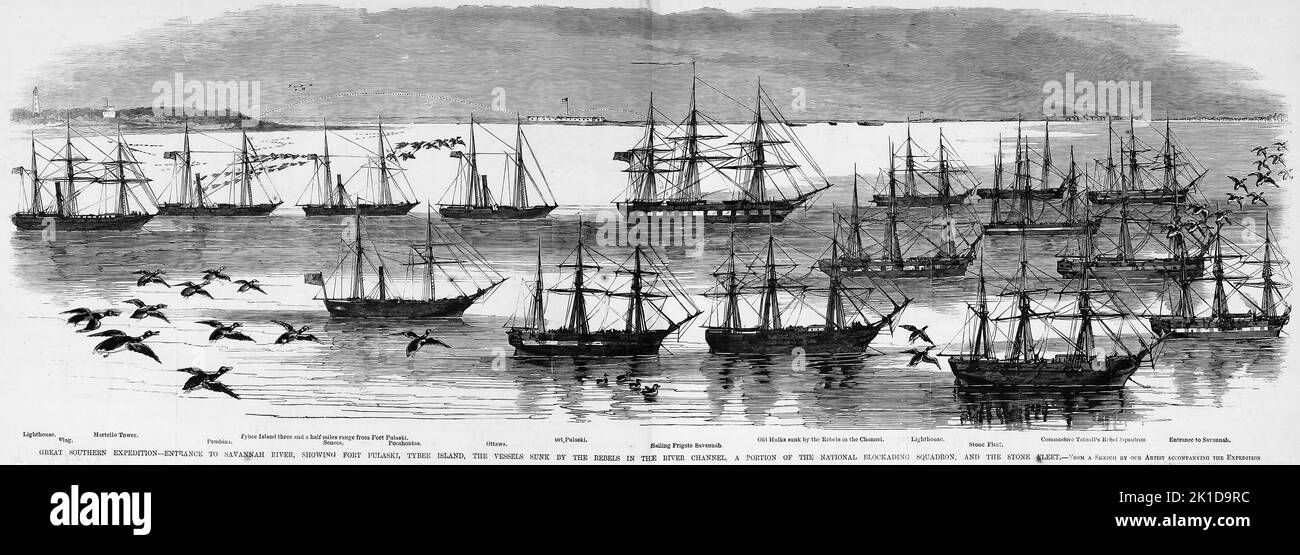 Great Southern Expedition - Entrance to Savannah River, showing Fort Pulaski, Tybee Island, Georgia, the vessels sunk by the Rebels in the river channel, a portion of the National Blockading Squadron, and the Stone Fleet - Ships Pembina, Seneca, Pocahontas, Ottawa, Savannah. December 1861. 19th century American Civil War illustration from Frank Leslie's Illustrated Newspaper Stock Photohttps://www.alamy.com/image-license-details/?v=1https://www.alamy.com/great-southern-expedition-entrance-to-savannah-river-showing-fort-pulaski-tybee-island-georgia-the-vessels-sunk-by-the-rebels-in-the-river-channel-a-portion-of-the-national-blockading-squadron-and-the-stone-fleet-ships-pembina-seneca-pocahontas-ottawa-savannah-december-1861-19th-century-american-civil-war-illustration-from-frank-leslies-illustrated-newspaper-image482798048.html
Great Southern Expedition - Entrance to Savannah River, showing Fort Pulaski, Tybee Island, Georgia, the vessels sunk by the Rebels in the river channel, a portion of the National Blockading Squadron, and the Stone Fleet - Ships Pembina, Seneca, Pocahontas, Ottawa, Savannah. December 1861. 19th century American Civil War illustration from Frank Leslie's Illustrated Newspaper Stock Photohttps://www.alamy.com/image-license-details/?v=1https://www.alamy.com/great-southern-expedition-entrance-to-savannah-river-showing-fort-pulaski-tybee-island-georgia-the-vessels-sunk-by-the-rebels-in-the-river-channel-a-portion-of-the-national-blockading-squadron-and-the-stone-fleet-ships-pembina-seneca-pocahontas-ottawa-savannah-december-1861-19th-century-american-civil-war-illustration-from-frank-leslies-illustrated-newspaper-image482798048.htmlRF2K1D9RC–Great Southern Expedition - Entrance to Savannah River, showing Fort Pulaski, Tybee Island, Georgia, the vessels sunk by the Rebels in the river channel, a portion of the National Blockading Squadron, and the Stone Fleet - Ships Pembina, Seneca, Pocahontas, Ottawa, Savannah. December 1861. 19th century American Civil War illustration from Frank Leslie's Illustrated Newspaper
 Tall ships at San Diego's waterfront Embarcadero Stock Photohttps://www.alamy.com/image-license-details/?v=1https://www.alamy.com/tall-ships-at-san-diegos-waterfront-embarcadero-image477754554.html
Tall ships at San Diego's waterfront Embarcadero Stock Photohttps://www.alamy.com/image-license-details/?v=1https://www.alamy.com/tall-ships-at-san-diegos-waterfront-embarcadero-image477754554.htmlRF2JN7GPJ–Tall ships at San Diego's waterfront Embarcadero
 The Battle of Copenhagen, 2 April 1801 . English: The Battle of Copenhagen, as painted by Nicholas Pocock. British bomb vessels are in the foreground in the lower left; to the right are the British and Danish ships in formations called 'line of battle', and the city of Copenhagen in the background. . early 19th century. 1010 PocockBattleOfCopenhagen Stock Photohttps://www.alamy.com/image-license-details/?v=1https://www.alamy.com/the-battle-of-copenhagen-2-april-1801-english-the-battle-of-copenhagen-as-painted-by-nicholas-pocock-british-bomb-vessels-are-in-the-foreground-in-the-lower-left-to-the-right-are-the-british-and-danish-ships-in-formations-called-line-of-battle-and-the-city-of-copenhagen-in-the-background-early-19th-century-1010-pocockbattleofcopenhagen-image185549706.html
The Battle of Copenhagen, 2 April 1801 . English: The Battle of Copenhagen, as painted by Nicholas Pocock. British bomb vessels are in the foreground in the lower left; to the right are the British and Danish ships in formations called 'line of battle', and the city of Copenhagen in the background. . early 19th century. 1010 PocockBattleOfCopenhagen Stock Photohttps://www.alamy.com/image-license-details/?v=1https://www.alamy.com/the-battle-of-copenhagen-2-april-1801-english-the-battle-of-copenhagen-as-painted-by-nicholas-pocock-british-bomb-vessels-are-in-the-foreground-in-the-lower-left-to-the-right-are-the-british-and-danish-ships-in-formations-called-line-of-battle-and-the-city-of-copenhagen-in-the-background-early-19th-century-1010-pocockbattleofcopenhagen-image185549706.htmlRMMNTEF6–The Battle of Copenhagen, 2 April 1801 . English: The Battle of Copenhagen, as painted by Nicholas Pocock. British bomb vessels are in the foreground in the lower left; to the right are the British and Danish ships in formations called 'line of battle', and the city of Copenhagen in the background. . early 19th century. 1010 PocockBattleOfCopenhagen
 Historical illustration, 19th Century, Different types of merchant ships, Stock Photohttps://www.alamy.com/image-license-details/?v=1https://www.alamy.com/historical-illustration-19th-century-different-types-of-merchant-ships-image67240683.html
Historical illustration, 19th Century, Different types of merchant ships, Stock Photohttps://www.alamy.com/image-license-details/?v=1https://www.alamy.com/historical-illustration-19th-century-different-types-of-merchant-ships-image67240683.htmlRMDWB24Y–Historical illustration, 19th Century, Different types of merchant ships,
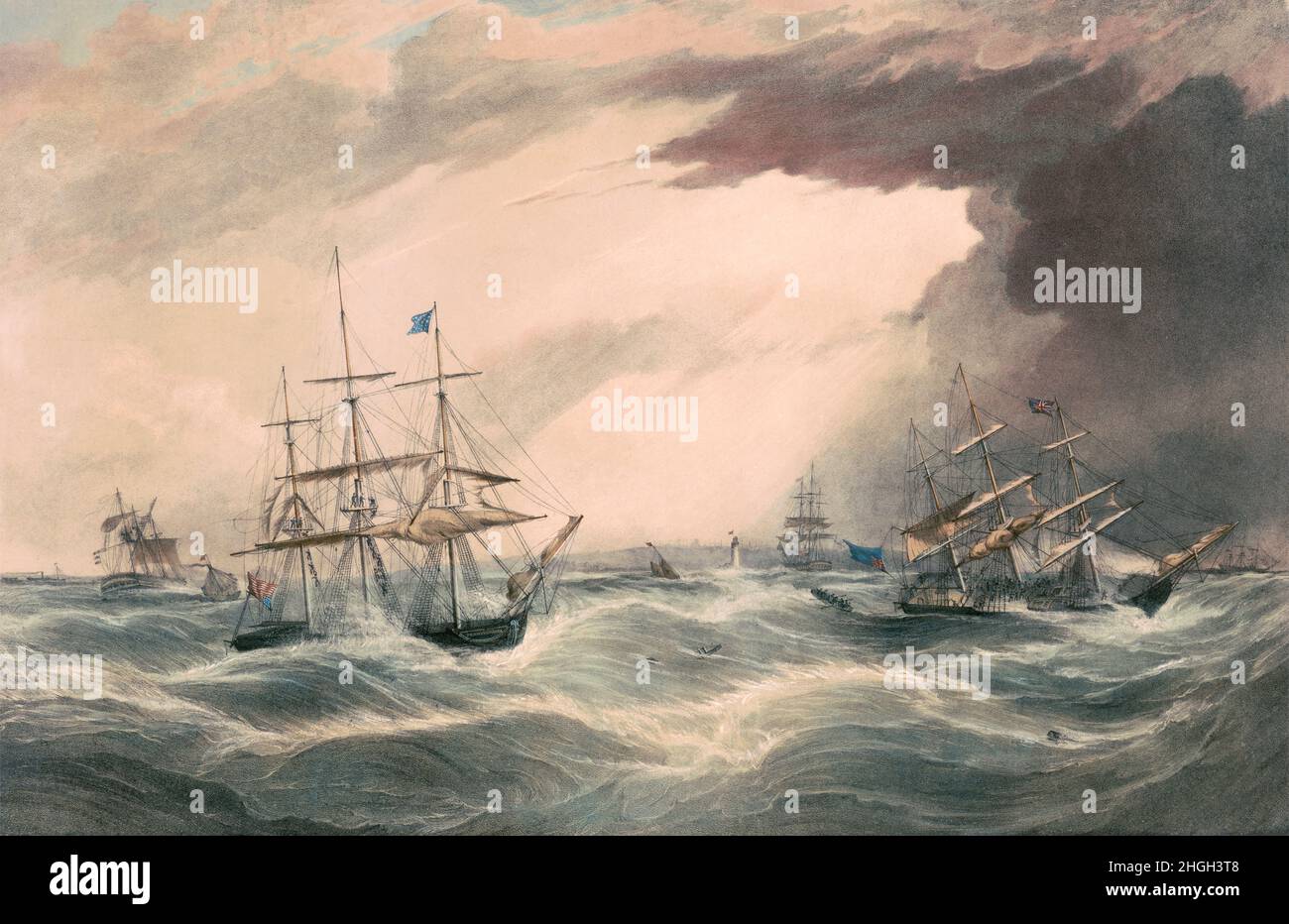 A 19th century artist's impression of the loss of the New York Packet Ship, 'Pennsylvania' (front left) and the 'Lockwood' Emigrant ship (front right) during a hurricane of January 7th and 8th, 1839 which resulted in the loss of several ships. The event occurred in estuary of the River Mersey, Liverpool, England and Leasowe Lighthouse and Bidston Hill can be seen in the centre backgound. Stock Photohttps://www.alamy.com/image-license-details/?v=1https://www.alamy.com/a-19th-century-artists-impression-of-the-loss-of-the-new-york-packet-ship-pennsylvania-front-left-and-the-lockwood-emigrant-ship-front-right-during-a-hurricane-of-january-7th-and-8th-1839-which-resulted-in-the-loss-of-several-ships-the-event-occurred-in-estuary-of-the-river-mersey-liverpool-england-and-leasowe-lighthouse-and-bidston-hill-can-be-seen-in-the-centre-backgound-image457680280.html
A 19th century artist's impression of the loss of the New York Packet Ship, 'Pennsylvania' (front left) and the 'Lockwood' Emigrant ship (front right) during a hurricane of January 7th and 8th, 1839 which resulted in the loss of several ships. The event occurred in estuary of the River Mersey, Liverpool, England and Leasowe Lighthouse and Bidston Hill can be seen in the centre backgound. Stock Photohttps://www.alamy.com/image-license-details/?v=1https://www.alamy.com/a-19th-century-artists-impression-of-the-loss-of-the-new-york-packet-ship-pennsylvania-front-left-and-the-lockwood-emigrant-ship-front-right-during-a-hurricane-of-january-7th-and-8th-1839-which-resulted-in-the-loss-of-several-ships-the-event-occurred-in-estuary-of-the-river-mersey-liverpool-england-and-leasowe-lighthouse-and-bidston-hill-can-be-seen-in-the-centre-backgound-image457680280.htmlRM2HGH3T8–A 19th century artist's impression of the loss of the New York Packet Ship, 'Pennsylvania' (front left) and the 'Lockwood' Emigrant ship (front right) during a hurricane of January 7th and 8th, 1839 which resulted in the loss of several ships. The event occurred in estuary of the River Mersey, Liverpool, England and Leasowe Lighthouse and Bidston Hill can be seen in the centre backgound.
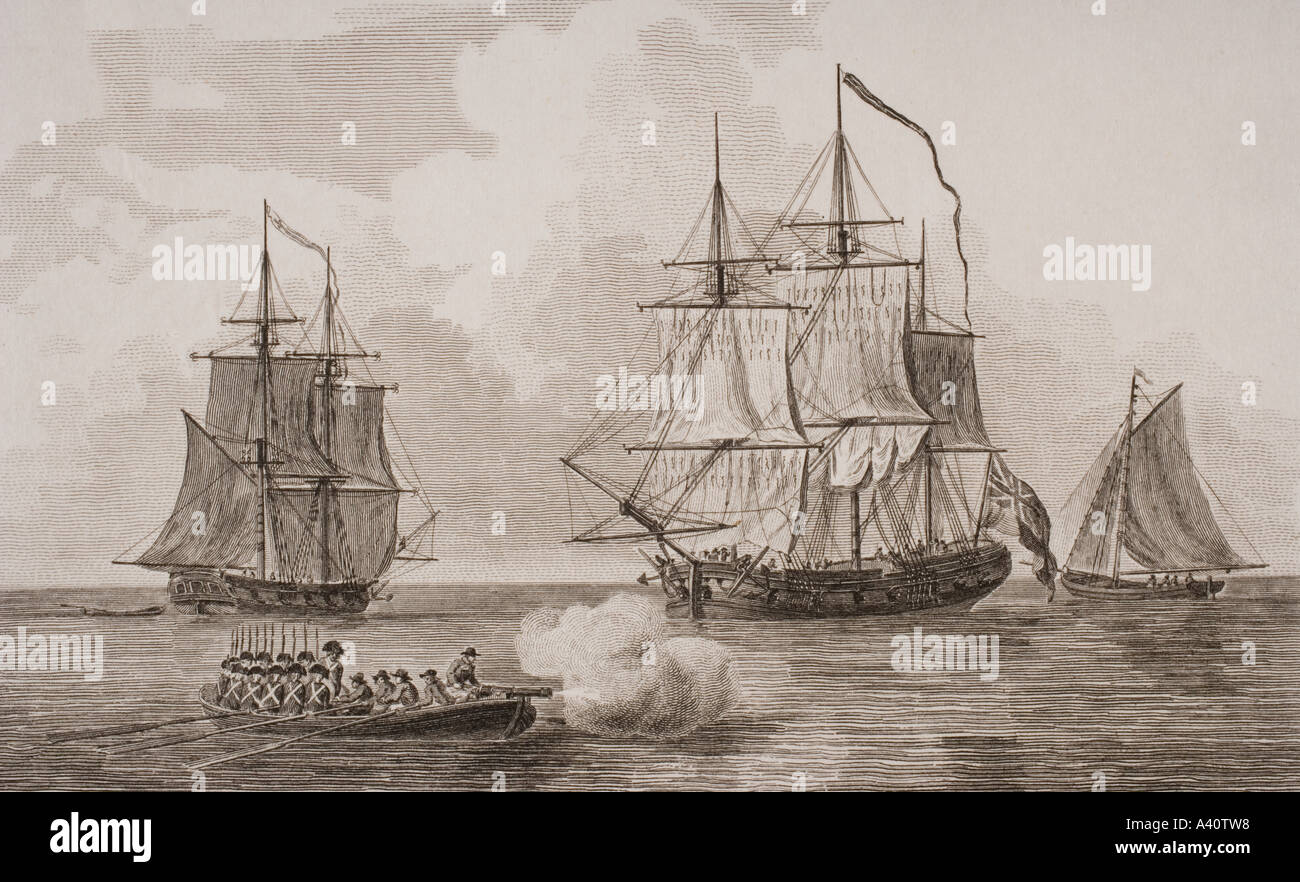 18th and 19th century British navy boats. From left, Fire Brig, Flat Bottomed Boat Gun Vessel, Man of War, Long Boat. Stock Photohttps://www.alamy.com/image-license-details/?v=1https://www.alamy.com/18th-and-19th-century-british-navy-boats-from-left-fire-brig-flat-image6226583.html
18th and 19th century British navy boats. From left, Fire Brig, Flat Bottomed Boat Gun Vessel, Man of War, Long Boat. Stock Photohttps://www.alamy.com/image-license-details/?v=1https://www.alamy.com/18th-and-19th-century-british-navy-boats-from-left-fire-brig-flat-image6226583.htmlRMA40TW8–18th and 19th century British navy boats. From left, Fire Brig, Flat Bottomed Boat Gun Vessel, Man of War, Long Boat.
 Illustration of ships and vessels of various kinds. Copperplate engraving from the 'Encyclopaedia Londinensis, or, Universal Dictionary of Arts, Sciences and Literature; Volume XXIII. Edited by John Wilkes. Published in London, Great, Britain, in 1828. Stock Photohttps://www.alamy.com/image-license-details/?v=1https://www.alamy.com/illustration-of-ships-and-vessels-of-various-kinds-copperplate-engraving-from-the-encyclopaedia-londinensis-or-universal-dictionary-of-arts-sciences-and-literature-volume-xxiii-edited-by-john-wilkes-published-in-london-great-britain-in-1828-image454450955.html
Illustration of ships and vessels of various kinds. Copperplate engraving from the 'Encyclopaedia Londinensis, or, Universal Dictionary of Arts, Sciences and Literature; Volume XXIII. Edited by John Wilkes. Published in London, Great, Britain, in 1828. Stock Photohttps://www.alamy.com/image-license-details/?v=1https://www.alamy.com/illustration-of-ships-and-vessels-of-various-kinds-copperplate-engraving-from-the-encyclopaedia-londinensis-or-universal-dictionary-of-arts-sciences-and-literature-volume-xxiii-edited-by-john-wilkes-published-in-london-great-britain-in-1828-image454450955.htmlRF2HBA0R7–Illustration of ships and vessels of various kinds. Copperplate engraving from the 'Encyclopaedia Londinensis, or, Universal Dictionary of Arts, Sciences and Literature; Volume XXIII. Edited by John Wilkes. Published in London, Great, Britain, in 1828.
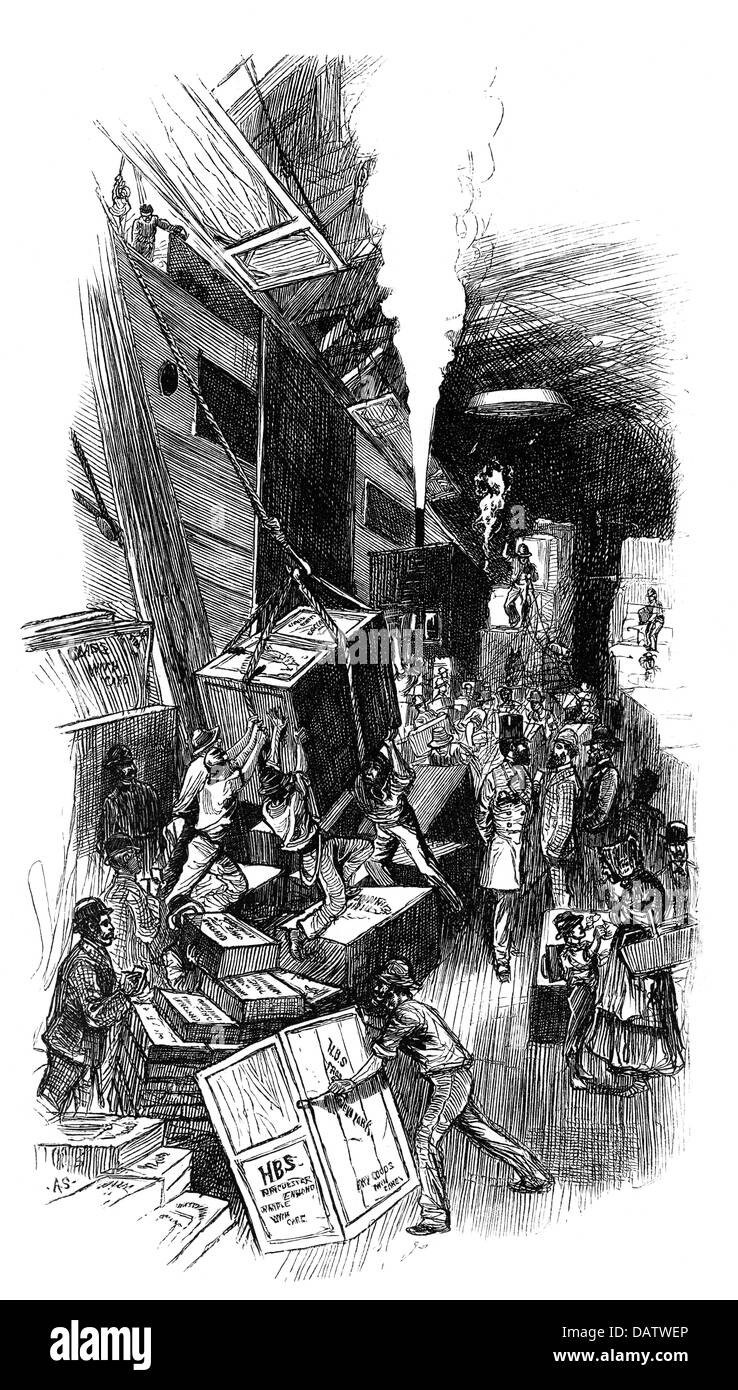 trade,merchant ships,harbour,seagoing vessel is unloaded,wood engraving,19th century,19th century,graphic,graphics,international trade,oversea trade,overseas trade,harbour,harbor,harbours,harbors,port,ports,cargo ship,freighter,merchant ship,cargo ships,freighters,merchant ships,cargo vessel,trading vessel,cargo vessels,trading vessels,worker,workers,docker,dockers,ware,wares,box,case,chest,crate,boxes,unload,offload,unloading,offloading,unloaded,import,importing,industrial imports,navigation,transportation,trans,Additional-Rights-Clearences-Not Available Stock Photohttps://www.alamy.com/image-license-details/?v=1https://www.alamy.com/stock-photo-trademerchant-shipsharbourseagoing-vessel-is-unloadedwood-engraving19th-58324526.html
trade,merchant ships,harbour,seagoing vessel is unloaded,wood engraving,19th century,19th century,graphic,graphics,international trade,oversea trade,overseas trade,harbour,harbor,harbours,harbors,port,ports,cargo ship,freighter,merchant ship,cargo ships,freighters,merchant ships,cargo vessel,trading vessel,cargo vessels,trading vessels,worker,workers,docker,dockers,ware,wares,box,case,chest,crate,boxes,unload,offload,unloading,offloading,unloaded,import,importing,industrial imports,navigation,transportation,trans,Additional-Rights-Clearences-Not Available Stock Photohttps://www.alamy.com/image-license-details/?v=1https://www.alamy.com/stock-photo-trademerchant-shipsharbourseagoing-vessel-is-unloadedwood-engraving19th-58324526.htmlRMDATWEP–trade,merchant ships,harbour,seagoing vessel is unloaded,wood engraving,19th century,19th century,graphic,graphics,international trade,oversea trade,overseas trade,harbour,harbor,harbours,harbors,port,ports,cargo ship,freighter,merchant ship,cargo ships,freighters,merchant ships,cargo vessel,trading vessel,cargo vessels,trading vessels,worker,workers,docker,dockers,ware,wares,box,case,chest,crate,boxes,unload,offload,unloading,offloading,unloaded,import,importing,industrial imports,navigation,transportation,trans,Additional-Rights-Clearences-Not Available
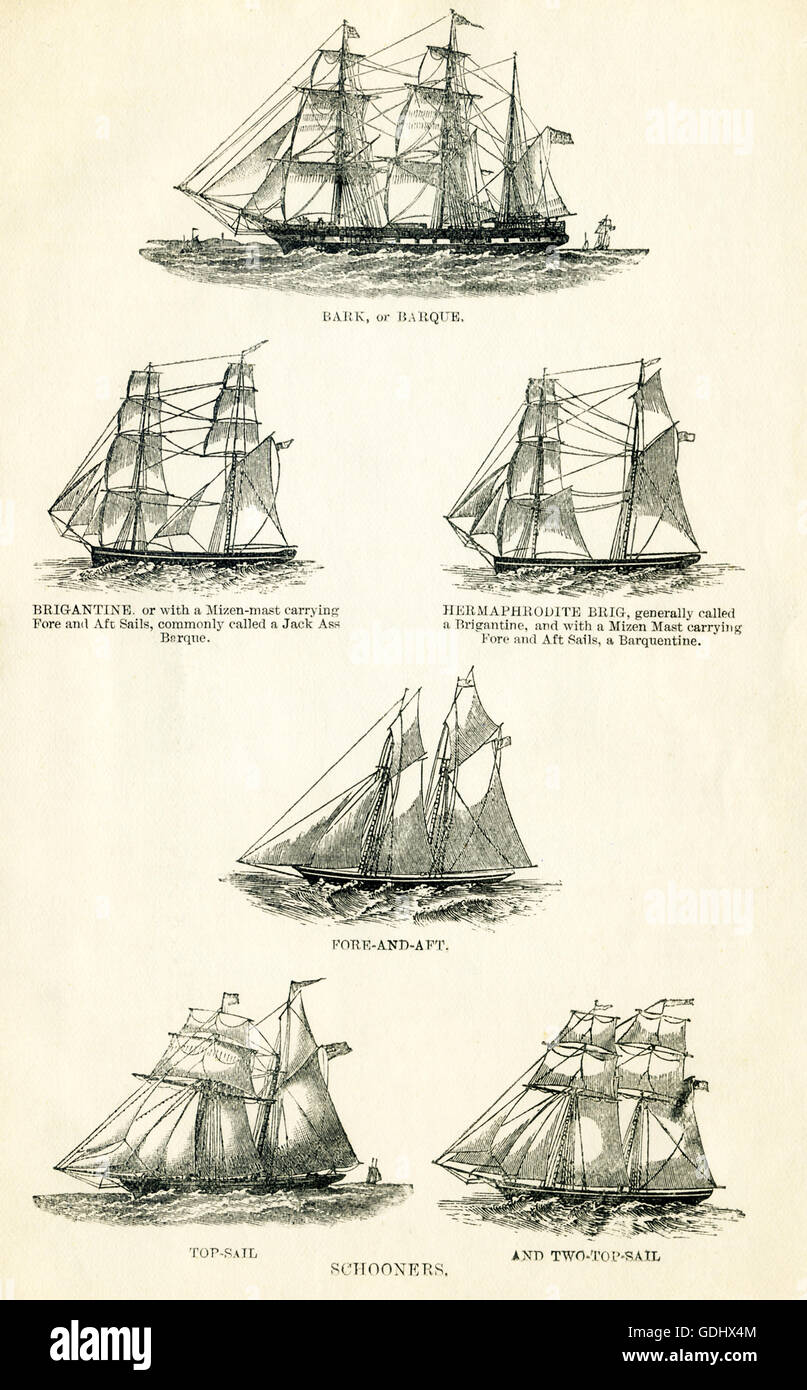 The vessels pictured in this 19th-century drawing are all schooners. From top to bottom, left to right, they are: bark (barque), brigantine, hermaphrodite brig, fore-and-aft, top-sail, two-top-sail. Stock Photohttps://www.alamy.com/image-license-details/?v=1https://www.alamy.com/stock-photo-the-vessels-pictured-in-this-19th-century-drawing-are-all-schooners-111646436.html
The vessels pictured in this 19th-century drawing are all schooners. From top to bottom, left to right, they are: bark (barque), brigantine, hermaphrodite brig, fore-and-aft, top-sail, two-top-sail. Stock Photohttps://www.alamy.com/image-license-details/?v=1https://www.alamy.com/stock-photo-the-vessels-pictured-in-this-19th-century-drawing-are-all-schooners-111646436.htmlRFGDHX4M–The vessels pictured in this 19th-century drawing are all schooners. From top to bottom, left to right, they are: bark (barque), brigantine, hermaphrodite brig, fore-and-aft, top-sail, two-top-sail.
 China of the Qing period. Vintage illustration of three Chinese vessels lying at anchor, in the river of Ningbo. 1805 The middle vessel, with the stern in view, was a trading ship without cargo; in this the peculiar construction of the stern is exemplified, being hollowed into an indented angle, for the protection of the rudder, which is lifted out of the water by a rope, to preserve it. The Chinese characters over the rudder, denote the name of the vessel; and the bisected cone against the stern, is appropriated to the same use as the quarter-galleries of our ships. The small vessel was hired Stock Photohttps://www.alamy.com/image-license-details/?v=1https://www.alamy.com/china-of-the-qing-period-vintage-illustration-of-three-chinese-vessels-lying-at-anchor-in-the-river-of-ningbo-1805-the-middle-vessel-with-the-stern-in-view-was-a-trading-ship-without-cargo-in-this-the-peculiar-construction-of-the-stern-is-exemplified-being-hollowed-into-an-indented-angle-for-the-protection-of-the-rudder-which-is-lifted-out-of-the-water-by-a-rope-to-preserve-it-the-chinese-characters-over-the-rudder-denote-the-name-of-the-vessel-and-the-bisected-cone-against-the-stern-is-appropriated-to-the-same-use-as-the-quarter-galleries-of-our-ships-the-small-vessel-was-hired-image623198987.html
China of the Qing period. Vintage illustration of three Chinese vessels lying at anchor, in the river of Ningbo. 1805 The middle vessel, with the stern in view, was a trading ship without cargo; in this the peculiar construction of the stern is exemplified, being hollowed into an indented angle, for the protection of the rudder, which is lifted out of the water by a rope, to preserve it. The Chinese characters over the rudder, denote the name of the vessel; and the bisected cone against the stern, is appropriated to the same use as the quarter-galleries of our ships. The small vessel was hired Stock Photohttps://www.alamy.com/image-license-details/?v=1https://www.alamy.com/china-of-the-qing-period-vintage-illustration-of-three-chinese-vessels-lying-at-anchor-in-the-river-of-ningbo-1805-the-middle-vessel-with-the-stern-in-view-was-a-trading-ship-without-cargo-in-this-the-peculiar-construction-of-the-stern-is-exemplified-being-hollowed-into-an-indented-angle-for-the-protection-of-the-rudder-which-is-lifted-out-of-the-water-by-a-rope-to-preserve-it-the-chinese-characters-over-the-rudder-denote-the-name-of-the-vessel-and-the-bisected-cone-against-the-stern-is-appropriated-to-the-same-use-as-the-quarter-galleries-of-our-ships-the-small-vessel-was-hired-image623198987.htmlRM2Y5W4JK–China of the Qing period. Vintage illustration of three Chinese vessels lying at anchor, in the river of Ningbo. 1805 The middle vessel, with the stern in view, was a trading ship without cargo; in this the peculiar construction of the stern is exemplified, being hollowed into an indented angle, for the protection of the rudder, which is lifted out of the water by a rope, to preserve it. The Chinese characters over the rudder, denote the name of the vessel; and the bisected cone against the stern, is appropriated to the same use as the quarter-galleries of our ships. The small vessel was hired
![[ 1880s Japan - Japanese Cargo Vessels ] — Cargo vessels at anchor at a harbor. 19th century vintage albumen photograph. Stock Photo [ 1880s Japan - Japanese Cargo Vessels ] — Cargo vessels at anchor at a harbor. 19th century vintage albumen photograph. Stock Photo](https://c8.alamy.com/comp/W26HBD/1880s-japan-japanese-cargo-vessels-cargo-vessels-at-anchor-at-a-harbor-19th-century-vintage-albumen-photograph-W26HBD.jpg) [ 1880s Japan - Japanese Cargo Vessels ] — Cargo vessels at anchor at a harbor. 19th century vintage albumen photograph. Stock Photohttps://www.alamy.com/image-license-details/?v=1https://www.alamy.com/1880s-japan-japanese-cargo-vessels-cargo-vessels-at-anchor-at-a-harbor-19th-century-vintage-albumen-photograph-image259530193.html
[ 1880s Japan - Japanese Cargo Vessels ] — Cargo vessels at anchor at a harbor. 19th century vintage albumen photograph. Stock Photohttps://www.alamy.com/image-license-details/?v=1https://www.alamy.com/1880s-japan-japanese-cargo-vessels-cargo-vessels-at-anchor-at-a-harbor-19th-century-vintage-albumen-photograph-image259530193.htmlRMW26HBD–[ 1880s Japan - Japanese Cargo Vessels ] — Cargo vessels at anchor at a harbor. 19th century vintage albumen photograph.
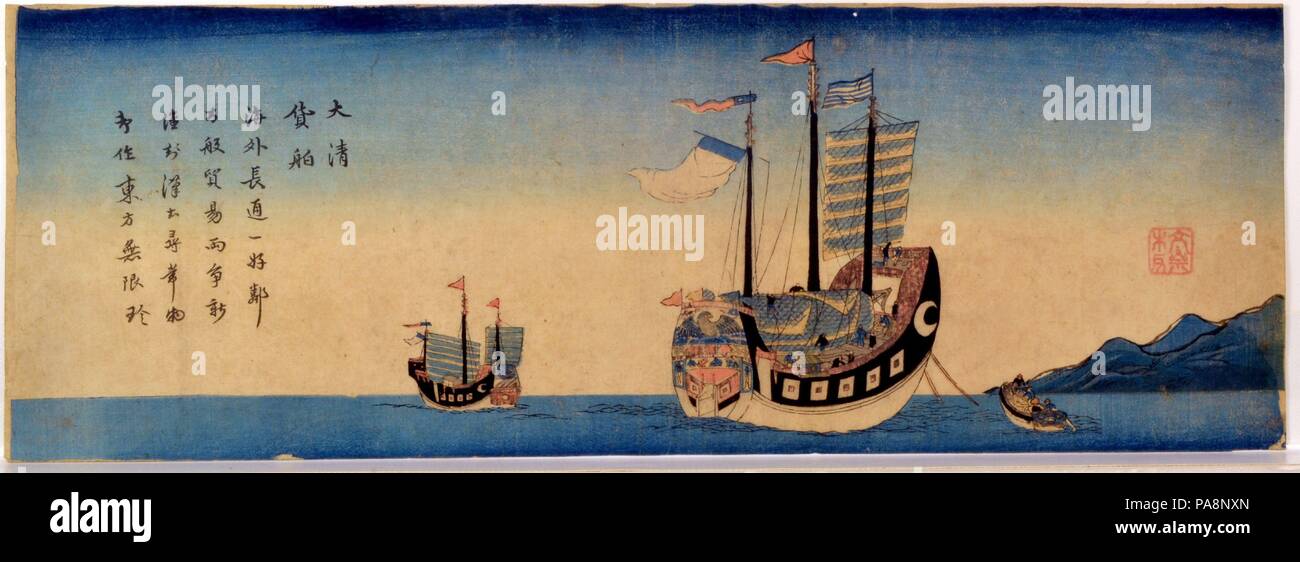 Chinese Ships at Nagasaki. Artist: Unidentified Artist Japanese, 19th century. Culture: Japan. Dimensions: Sheet: 6 3/8 x 18 3/16 in. (16.2 x 46.2 cm). Date: ca. 1840. Two Chinese ships approach the port of Nagasaki. The crew works quickly to lower one of the sails of the ship in the foreground as a small vessel approaches with a group of returning traders. Above the slopes of the shore at the right of the print is a red seal with the name of the print's publisher. It reads 'Bunsaido'. An inscription at the upper left of the print declares the ships to be trading vessels from Qing China. I Stock Photohttps://www.alamy.com/image-license-details/?v=1https://www.alamy.com/chinese-ships-at-nagasaki-artist-unidentified-artist-japanese-19th-century-culture-japan-dimensions-sheet-6-38-x-18-316-in-162-x-462-cm-date-ca-1840-two-chinese-ships-approach-the-port-of-nagasaki-the-crew-works-quickly-to-lower-one-of-the-sails-of-the-ship-in-the-foreground-as-a-small-vessel-approaches-with-a-group-of-returning-traders-above-the-slopes-of-the-shore-at-the-right-of-the-print-is-a-red-seal-with-the-name-of-the-prints-publisher-it-reads-bunsaido-an-inscription-at-the-upper-left-of-the-print-declares-the-ships-to-be-trading-vessels-from-qing-china-i-image212863805.html
Chinese Ships at Nagasaki. Artist: Unidentified Artist Japanese, 19th century. Culture: Japan. Dimensions: Sheet: 6 3/8 x 18 3/16 in. (16.2 x 46.2 cm). Date: ca. 1840. Two Chinese ships approach the port of Nagasaki. The crew works quickly to lower one of the sails of the ship in the foreground as a small vessel approaches with a group of returning traders. Above the slopes of the shore at the right of the print is a red seal with the name of the print's publisher. It reads 'Bunsaido'. An inscription at the upper left of the print declares the ships to be trading vessels from Qing China. I Stock Photohttps://www.alamy.com/image-license-details/?v=1https://www.alamy.com/chinese-ships-at-nagasaki-artist-unidentified-artist-japanese-19th-century-culture-japan-dimensions-sheet-6-38-x-18-316-in-162-x-462-cm-date-ca-1840-two-chinese-ships-approach-the-port-of-nagasaki-the-crew-works-quickly-to-lower-one-of-the-sails-of-the-ship-in-the-foreground-as-a-small-vessel-approaches-with-a-group-of-returning-traders-above-the-slopes-of-the-shore-at-the-right-of-the-print-is-a-red-seal-with-the-name-of-the-prints-publisher-it-reads-bunsaido-an-inscription-at-the-upper-left-of-the-print-declares-the-ships-to-be-trading-vessels-from-qing-china-i-image212863805.htmlRMPA8NXN–Chinese Ships at Nagasaki. Artist: Unidentified Artist Japanese, 19th century. Culture: Japan. Dimensions: Sheet: 6 3/8 x 18 3/16 in. (16.2 x 46.2 cm). Date: ca. 1840. Two Chinese ships approach the port of Nagasaki. The crew works quickly to lower one of the sails of the ship in the foreground as a small vessel approaches with a group of returning traders. Above the slopes of the shore at the right of the print is a red seal with the name of the print's publisher. It reads 'Bunsaido'. An inscription at the upper left of the print declares the ships to be trading vessels from Qing China. I
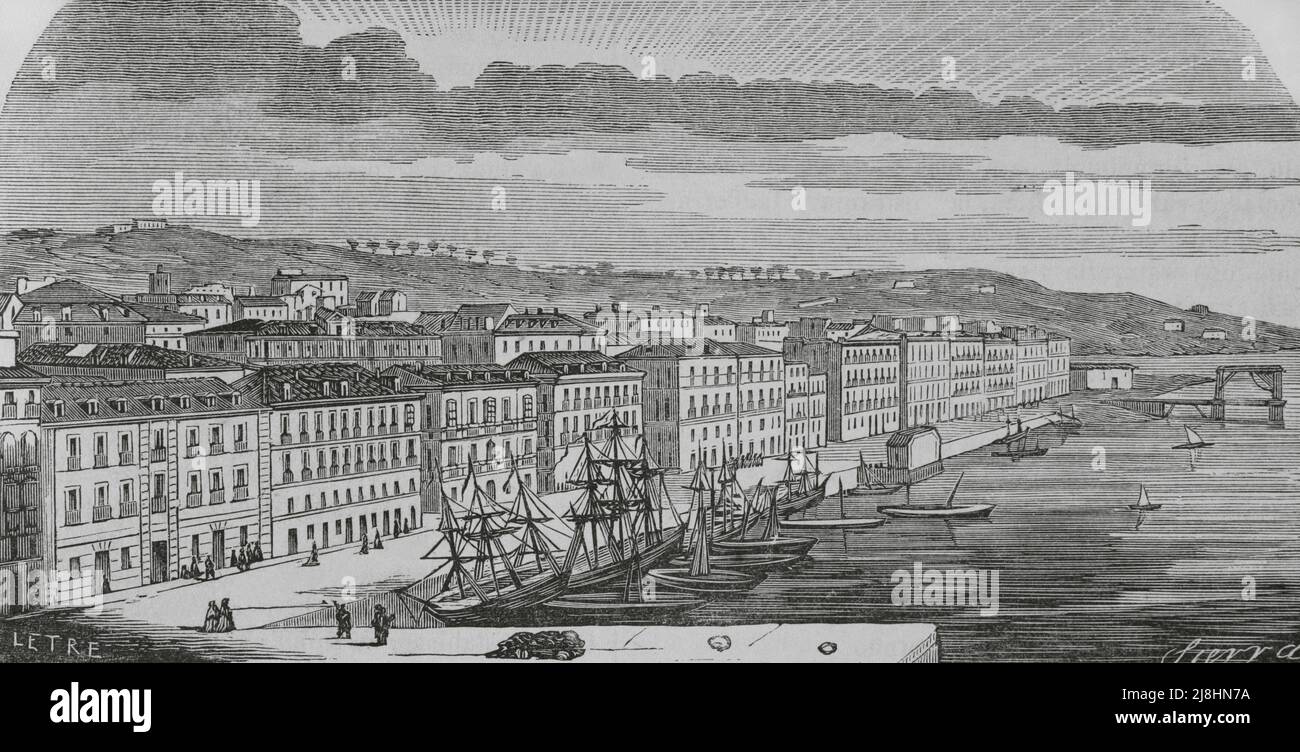 Spain, Santander. Panoramic view of the harbour. Engraving by Sierra, 19th century. Stock Photohttps://www.alamy.com/image-license-details/?v=1https://www.alamy.com/spain-santander-panoramic-view-of-the-harbour-engraving-by-sierra-19th-century-image469987038.html
Spain, Santander. Panoramic view of the harbour. Engraving by Sierra, 19th century. Stock Photohttps://www.alamy.com/image-license-details/?v=1https://www.alamy.com/spain-santander-panoramic-view-of-the-harbour-engraving-by-sierra-19th-century-image469987038.htmlRM2J8HN7A–Spain, Santander. Panoramic view of the harbour. Engraving by Sierra, 19th century.
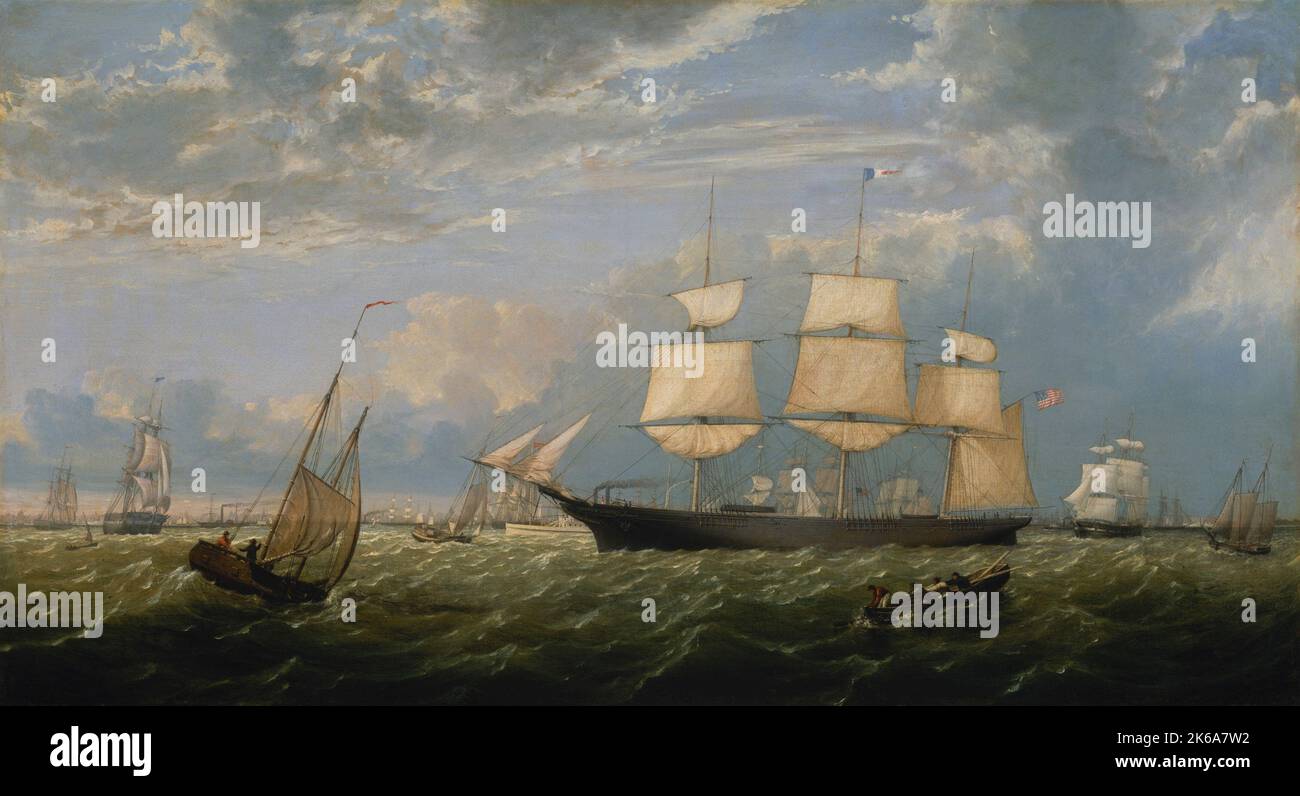 19th century painting of the Golden Gate merchant ship as it enters New York Harbor, 1854. Stock Photohttps://www.alamy.com/image-license-details/?v=1https://www.alamy.com/19th-century-painting-of-the-golden-gate-merchant-ship-as-it-enters-new-york-harbor-1854-image485803950.html
19th century painting of the Golden Gate merchant ship as it enters New York Harbor, 1854. Stock Photohttps://www.alamy.com/image-license-details/?v=1https://www.alamy.com/19th-century-painting-of-the-golden-gate-merchant-ship-as-it-enters-new-york-harbor-1854-image485803950.htmlRF2K6A7W2–19th century painting of the Golden Gate merchant ship as it enters New York Harbor, 1854.
 SHIPS Vessels of Refuge in Harbour, chartered by the British Government 1882. The Graphic Stock Photohttps://www.alamy.com/image-license-details/?v=1https://www.alamy.com/stock-photo-ships-vessels-of-refuge-in-harbour-chartered-by-the-british-government-122597343.html
SHIPS Vessels of Refuge in Harbour, chartered by the British Government 1882. The Graphic Stock Photohttps://www.alamy.com/image-license-details/?v=1https://www.alamy.com/stock-photo-ships-vessels-of-refuge-in-harbour-chartered-by-the-british-government-122597343.htmlRFH3CP4F–SHIPS Vessels of Refuge in Harbour, chartered by the British Government 1882. The Graphic
 Vintage photo of the 19th-century Hong Kong's harbour . Illustration of China, 1875 Hong Kong is a special administrative region of the People's Republic of China. With 7.4 million residents of various nationalities in a 1,104-square-kilometre (426 sq mi) territory, Hong Kong is one of the most densely populated territories in the world. Hong Kong was established as a colony of the British Empire after the Qing dynasty ceded Hong Kong Island in 1841–1842 as a consequence of losing the First Opium War. The colony expanded to the Kowloon Peninsula in 1860 and was further extended when the United Stock Photohttps://www.alamy.com/image-license-details/?v=1https://www.alamy.com/vintage-photo-of-the-19th-century-hong-kongs-harbour-illustration-of-china-1875-hong-kong-is-a-special-administrative-region-of-the-peoples-republic-of-china-with-74-million-residents-of-various-nationalities-in-a-1104-square-kilometre-426-sq-mi-territory-hong-kong-is-one-of-the-most-densely-populated-territories-in-the-world-hong-kong-was-established-as-a-colony-of-the-british-empire-after-the-qing-dynasty-ceded-hong-kong-island-in-18411842-as-a-consequence-of-losing-the-first-opium-war-the-colony-expanded-to-the-kowloon-peninsula-in-1860-and-was-further-extended-when-the-united-image612030701.html
Vintage photo of the 19th-century Hong Kong's harbour . Illustration of China, 1875 Hong Kong is a special administrative region of the People's Republic of China. With 7.4 million residents of various nationalities in a 1,104-square-kilometre (426 sq mi) territory, Hong Kong is one of the most densely populated territories in the world. Hong Kong was established as a colony of the British Empire after the Qing dynasty ceded Hong Kong Island in 1841–1842 as a consequence of losing the First Opium War. The colony expanded to the Kowloon Peninsula in 1860 and was further extended when the United Stock Photohttps://www.alamy.com/image-license-details/?v=1https://www.alamy.com/vintage-photo-of-the-19th-century-hong-kongs-harbour-illustration-of-china-1875-hong-kong-is-a-special-administrative-region-of-the-peoples-republic-of-china-with-74-million-residents-of-various-nationalities-in-a-1104-square-kilometre-426-sq-mi-territory-hong-kong-is-one-of-the-most-densely-populated-territories-in-the-world-hong-kong-was-established-as-a-colony-of-the-british-empire-after-the-qing-dynasty-ceded-hong-kong-island-in-18411842-as-a-consequence-of-losing-the-first-opium-war-the-colony-expanded-to-the-kowloon-peninsula-in-1860-and-was-further-extended-when-the-united-image612030701.htmlRM2XFMBB9–Vintage photo of the 19th-century Hong Kong's harbour . Illustration of China, 1875 Hong Kong is a special administrative region of the People's Republic of China. With 7.4 million residents of various nationalities in a 1,104-square-kilometre (426 sq mi) territory, Hong Kong is one of the most densely populated territories in the world. Hong Kong was established as a colony of the British Empire after the Qing dynasty ceded Hong Kong Island in 1841–1842 as a consequence of losing the First Opium War. The colony expanded to the Kowloon Peninsula in 1860 and was further extended when the United
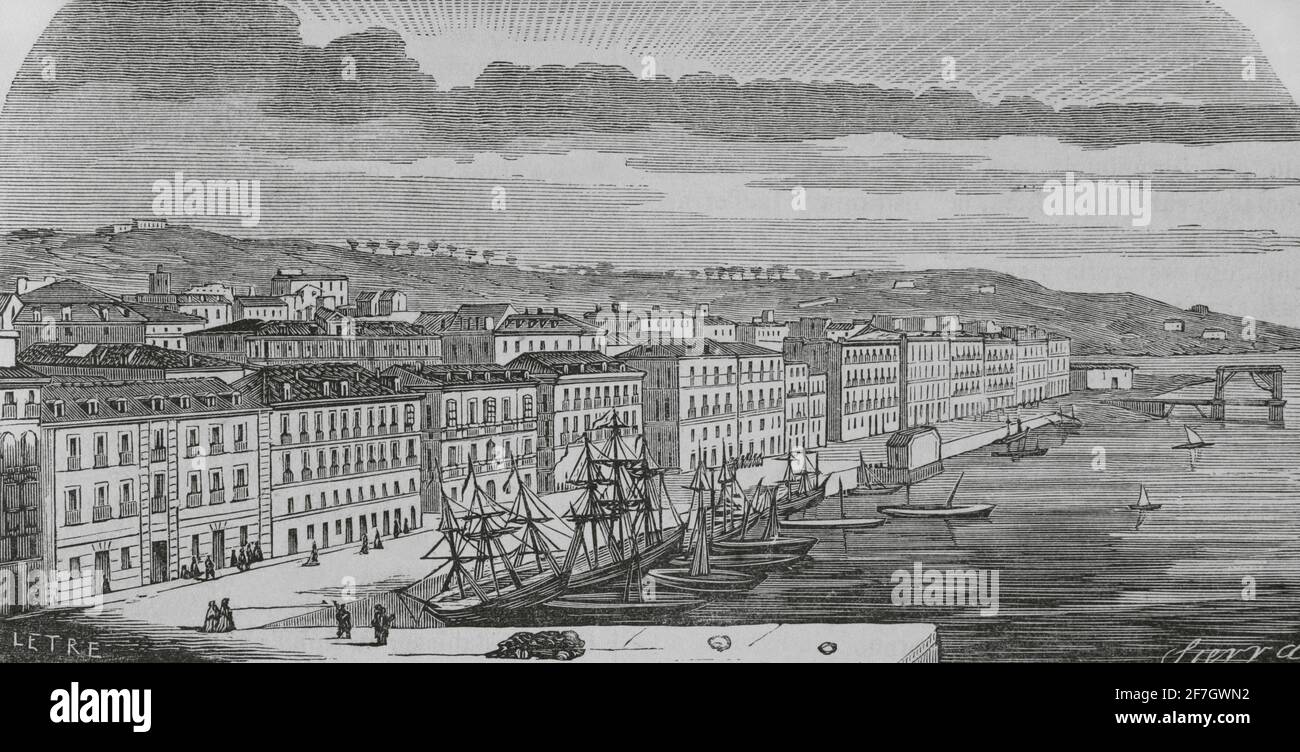 Spain, Santander. Panoramic view of the harbour. Illustration by Letre. Engraving by Sierra. Crónica General de España, Historia Ilustrada y Descriptiva de sus Provincias. Castilla-La Vieja, 1870. Stock Photohttps://www.alamy.com/image-license-details/?v=1https://www.alamy.com/spain-santander-panoramic-view-of-the-harbour-illustration-by-letre-engraving-by-sierra-crnica-general-de-espaa-historia-ilustrada-y-descriptiva-de-sus-provincias-castilla-la-vieja-1870-image417722846.html
Spain, Santander. Panoramic view of the harbour. Illustration by Letre. Engraving by Sierra. Crónica General de España, Historia Ilustrada y Descriptiva de sus Provincias. Castilla-La Vieja, 1870. Stock Photohttps://www.alamy.com/image-license-details/?v=1https://www.alamy.com/spain-santander-panoramic-view-of-the-harbour-illustration-by-letre-engraving-by-sierra-crnica-general-de-espaa-historia-ilustrada-y-descriptiva-de-sus-provincias-castilla-la-vieja-1870-image417722846.htmlRM2F7GWN2–Spain, Santander. Panoramic view of the harbour. Illustration by Letre. Engraving by Sierra. Crónica General de España, Historia Ilustrada y Descriptiva de sus Provincias. Castilla-La Vieja, 1870.
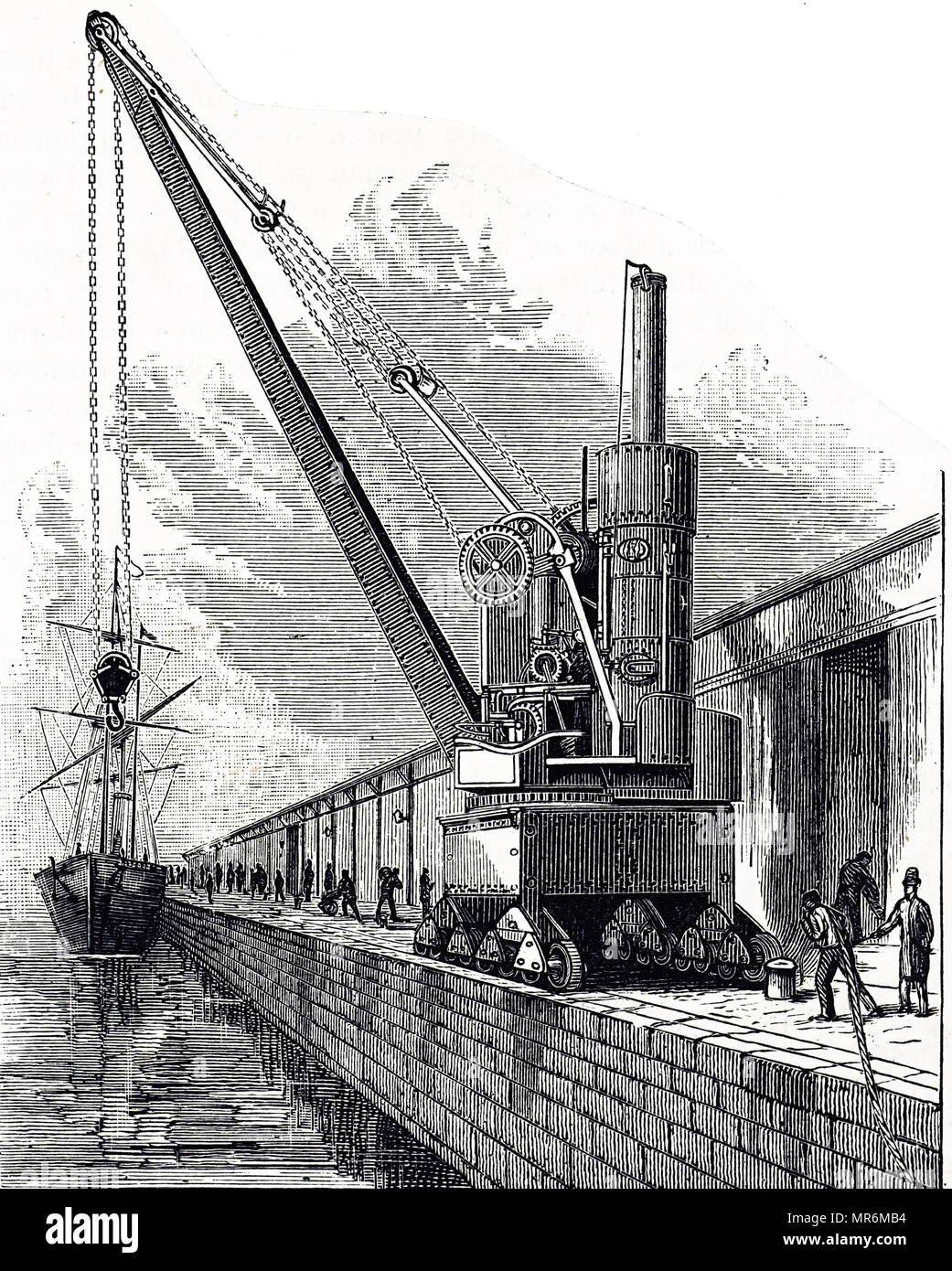 Engraving depicting a George-Russell & Co.'s steam crane, used by the Anchor line for loading and unloading vessels. Dated 19th century Stock Photohttps://www.alamy.com/image-license-details/?v=1https://www.alamy.com/engraving-depicting-a-george-russell-cos-steam-crane-used-by-the-anchor-line-for-loading-and-unloading-vessels-dated-19th-century-image186388472.html
Engraving depicting a George-Russell & Co.'s steam crane, used by the Anchor line for loading and unloading vessels. Dated 19th century Stock Photohttps://www.alamy.com/image-license-details/?v=1https://www.alamy.com/engraving-depicting-a-george-russell-cos-steam-crane-used-by-the-anchor-line-for-loading-and-unloading-vessels-dated-19th-century-image186388472.htmlRMMR6MB4–Engraving depicting a George-Russell & Co.'s steam crane, used by the Anchor line for loading and unloading vessels. Dated 19th century
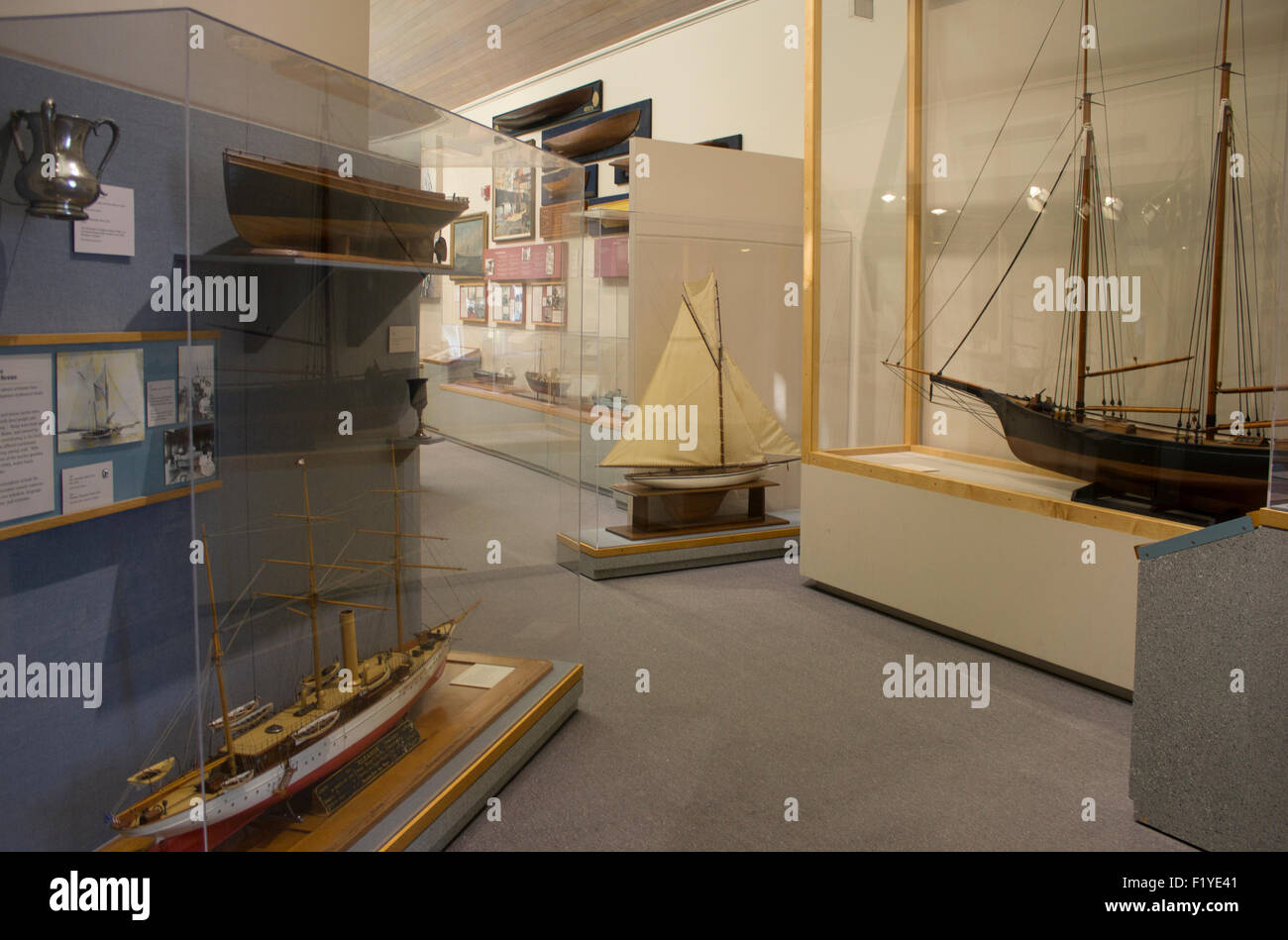 The Maine Maritime Museum in Bath, Maine. Features the history of 19th century ship building, vessels, and commercial voyages. Stock Photohttps://www.alamy.com/image-license-details/?v=1https://www.alamy.com/stock-photo-the-maine-maritime-museum-in-bath-maine-features-the-history-of-19th-87270289.html
The Maine Maritime Museum in Bath, Maine. Features the history of 19th century ship building, vessels, and commercial voyages. Stock Photohttps://www.alamy.com/image-license-details/?v=1https://www.alamy.com/stock-photo-the-maine-maritime-museum-in-bath-maine-features-the-history-of-19th-87270289.htmlRMF1YE41–The Maine Maritime Museum in Bath, Maine. Features the history of 19th century ship building, vessels, and commercial voyages.
 Warships Lying Offshore, the Commanding Admiral Being Rowed out to Join the Flagship, Her Sails Illuminated by a Break in the Clouds, Charles Martin Powell, 1775 –1824, British, early 19th century, Oil on canvas, Support (PTG): 23 3/4 × 35 7/8 inches (60.3 × 91.1 cm), admiral, barges, beach, clouds, flags, marine art, men, rowboats, sailors, sea, ships of the line, shore (landform), sloops (sailing vessels), warships Stock Photohttps://www.alamy.com/image-license-details/?v=1https://www.alamy.com/warships-lying-offshore-the-commanding-admiral-being-rowed-out-to-join-the-flagship-her-sails-illuminated-by-a-break-in-the-clouds-charles-martin-powell-1775-1824-british-early-19th-century-oil-on-canvas-support-ptg-23-34-35-78-inches-603-911-cm-admiral-barges-beach-clouds-flags-marine-art-men-rowboats-sailors-sea-ships-of-the-line-shore-landform-sloops-sailing-vessels-warships-image389809834.html
Warships Lying Offshore, the Commanding Admiral Being Rowed out to Join the Flagship, Her Sails Illuminated by a Break in the Clouds, Charles Martin Powell, 1775 –1824, British, early 19th century, Oil on canvas, Support (PTG): 23 3/4 × 35 7/8 inches (60.3 × 91.1 cm), admiral, barges, beach, clouds, flags, marine art, men, rowboats, sailors, sea, ships of the line, shore (landform), sloops (sailing vessels), warships Stock Photohttps://www.alamy.com/image-license-details/?v=1https://www.alamy.com/warships-lying-offshore-the-commanding-admiral-being-rowed-out-to-join-the-flagship-her-sails-illuminated-by-a-break-in-the-clouds-charles-martin-powell-1775-1824-british-early-19th-century-oil-on-canvas-support-ptg-23-34-35-78-inches-603-911-cm-admiral-barges-beach-clouds-flags-marine-art-men-rowboats-sailors-sea-ships-of-the-line-shore-landform-sloops-sailing-vessels-warships-image389809834.htmlRM2DJ5ABP–Warships Lying Offshore, the Commanding Admiral Being Rowed out to Join the Flagship, Her Sails Illuminated by a Break in the Clouds, Charles Martin Powell, 1775 –1824, British, early 19th century, Oil on canvas, Support (PTG): 23 3/4 × 35 7/8 inches (60.3 × 91.1 cm), admiral, barges, beach, clouds, flags, marine art, men, rowboats, sailors, sea, ships of the line, shore (landform), sloops (sailing vessels), warships
 Oil painting of Dutch sailing vessels ships painted by William Anderson art artwork picture Stock Photohttps://www.alamy.com/image-license-details/?v=1https://www.alamy.com/oil-painting-of-dutch-sailing-vessels-ships-painted-by-william-anderson-art-artwork-picture-image619616313.html
Oil painting of Dutch sailing vessels ships painted by William Anderson art artwork picture Stock Photohttps://www.alamy.com/image-license-details/?v=1https://www.alamy.com/oil-painting-of-dutch-sailing-vessels-ships-painted-by-william-anderson-art-artwork-picture-image619616313.htmlRM2Y01XX1–Oil painting of Dutch sailing vessels ships painted by William Anderson art artwork picture
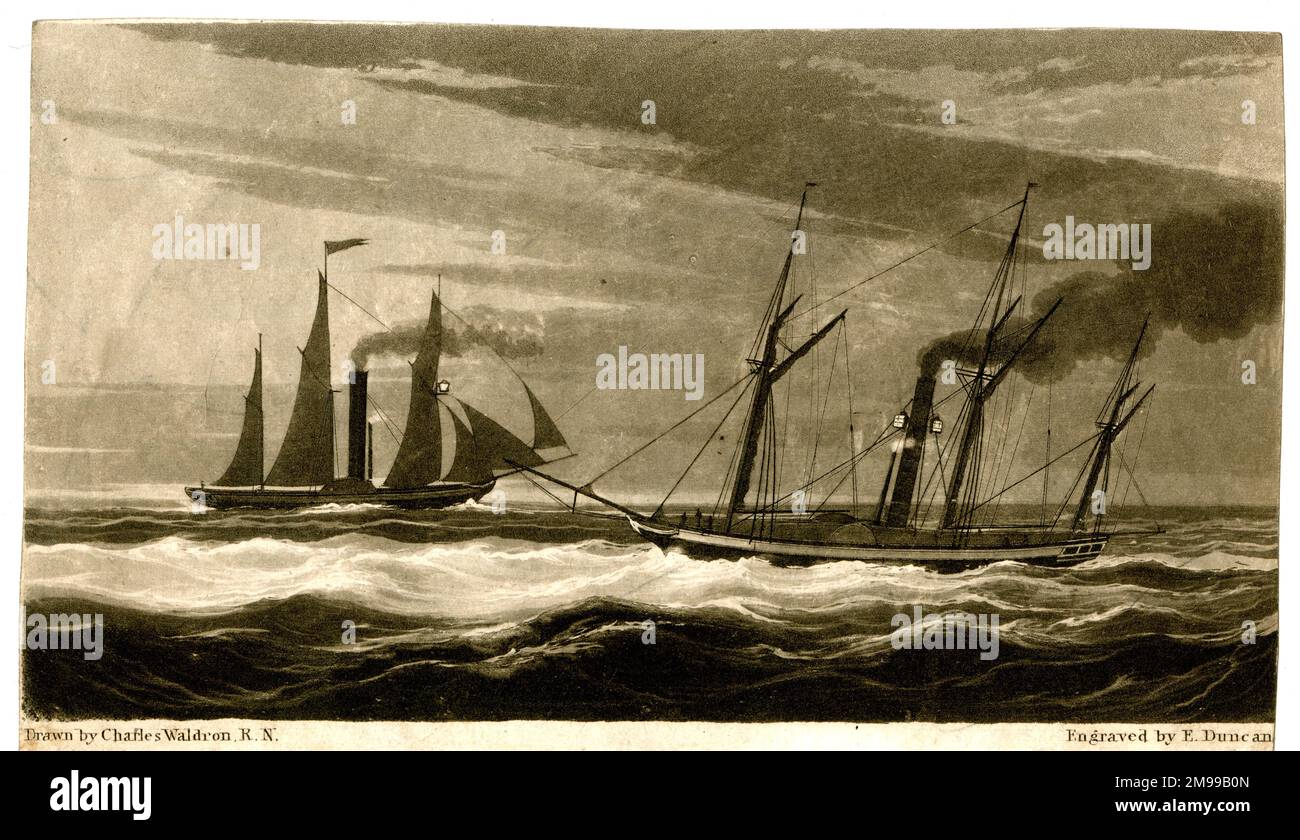 Steam ships at night with lights to the foremast head. Stock Photohttps://www.alamy.com/image-license-details/?v=1https://www.alamy.com/steam-ships-at-night-with-lights-to-the-foremast-head-image504838789.html
Steam ships at night with lights to the foremast head. Stock Photohttps://www.alamy.com/image-license-details/?v=1https://www.alamy.com/steam-ships-at-night-with-lights-to-the-foremast-head-image504838789.htmlRM2M99B0N–Steam ships at night with lights to the foremast head.
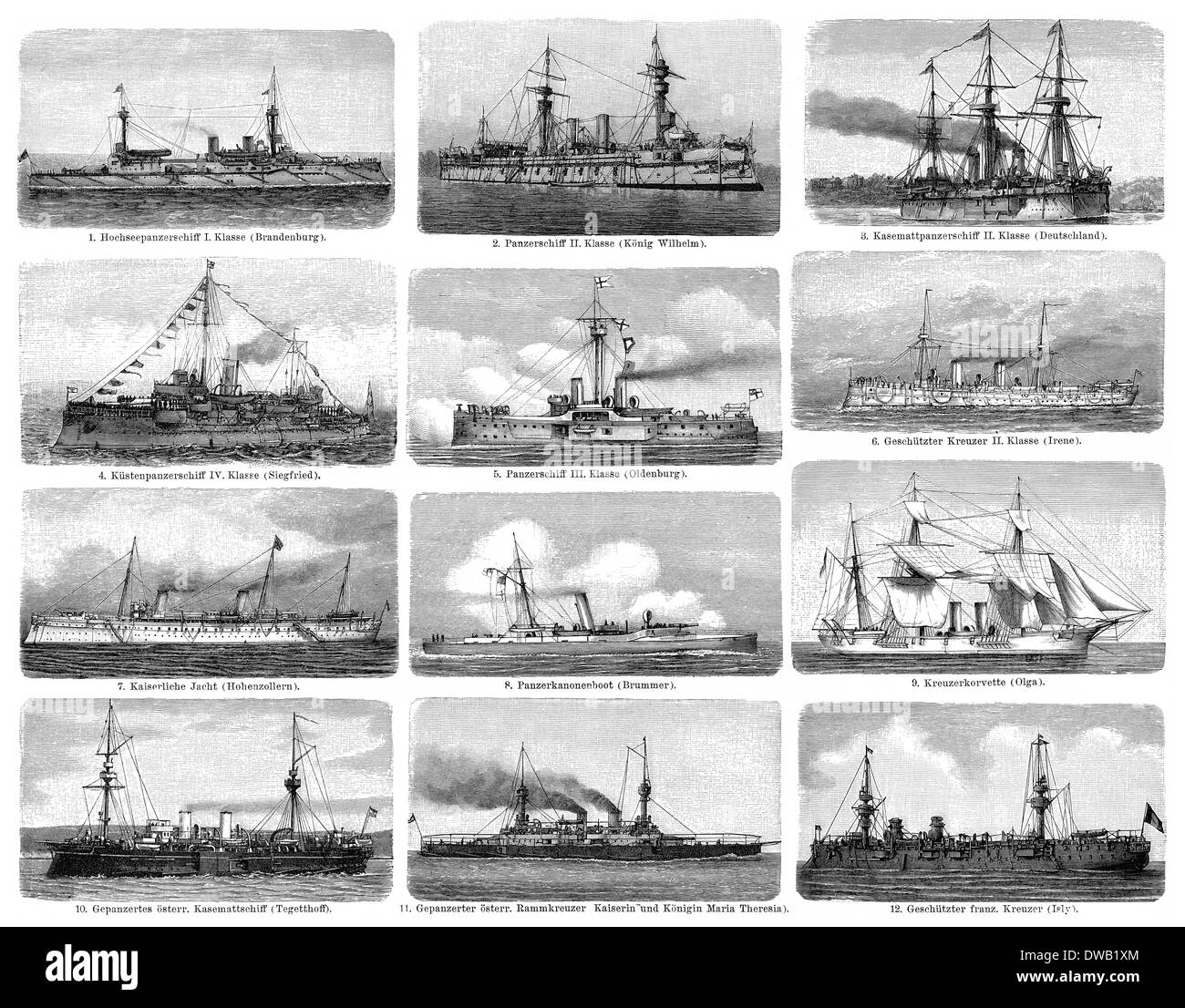 Historical illustration, 19th Century, Different types of warships, Stock Photohttps://www.alamy.com/image-license-details/?v=1https://www.alamy.com/historical-illustration-19th-century-different-types-of-warships-image67240508.html
Historical illustration, 19th Century, Different types of warships, Stock Photohttps://www.alamy.com/image-license-details/?v=1https://www.alamy.com/historical-illustration-19th-century-different-types-of-warships-image67240508.htmlRMDWB1XM–Historical illustration, 19th Century, Different types of warships,
 A late 19th Century view of shipping in the harbour in Brixham, a small fishing town in the district of Torbay in the county of Devon, in the south-west of England. For many years Brixham was the largest fishing port in the south west of England and its boats helped to establish the fishing industries of Hull, Grimsby and Lowestoft. Some of the 300 individually owned trawling vessels from Brixham can be seen heading out to sea. Stock Photohttps://www.alamy.com/image-license-details/?v=1https://www.alamy.com/a-late-19th-century-view-of-shipping-in-the-harbour-in-brixham-a-small-fishing-town-in-the-district-of-torbay-in-the-county-of-devon-in-the-south-west-of-england-for-many-years-brixham-was-the-largest-fishing-port-in-the-south-west-of-england-and-its-boats-helped-to-establish-the-fishing-industries-of-hull-grimsby-and-lowestoft-some-of-the-300-individually-owned-trawling-vessels-from-brixham-can-be-seen-heading-out-to-sea-image246623438.html
A late 19th Century view of shipping in the harbour in Brixham, a small fishing town in the district of Torbay in the county of Devon, in the south-west of England. For many years Brixham was the largest fishing port in the south west of England and its boats helped to establish the fishing industries of Hull, Grimsby and Lowestoft. Some of the 300 individually owned trawling vessels from Brixham can be seen heading out to sea. Stock Photohttps://www.alamy.com/image-license-details/?v=1https://www.alamy.com/a-late-19th-century-view-of-shipping-in-the-harbour-in-brixham-a-small-fishing-town-in-the-district-of-torbay-in-the-county-of-devon-in-the-south-west-of-england-for-many-years-brixham-was-the-largest-fishing-port-in-the-south-west-of-england-and-its-boats-helped-to-establish-the-fishing-industries-of-hull-grimsby-and-lowestoft-some-of-the-300-individually-owned-trawling-vessels-from-brixham-can-be-seen-heading-out-to-sea-image246623438.htmlRMT96JKX–A late 19th Century view of shipping in the harbour in Brixham, a small fishing town in the district of Torbay in the county of Devon, in the south-west of England. For many years Brixham was the largest fishing port in the south west of England and its boats helped to establish the fishing industries of Hull, Grimsby and Lowestoft. Some of the 300 individually owned trawling vessels from Brixham can be seen heading out to sea.
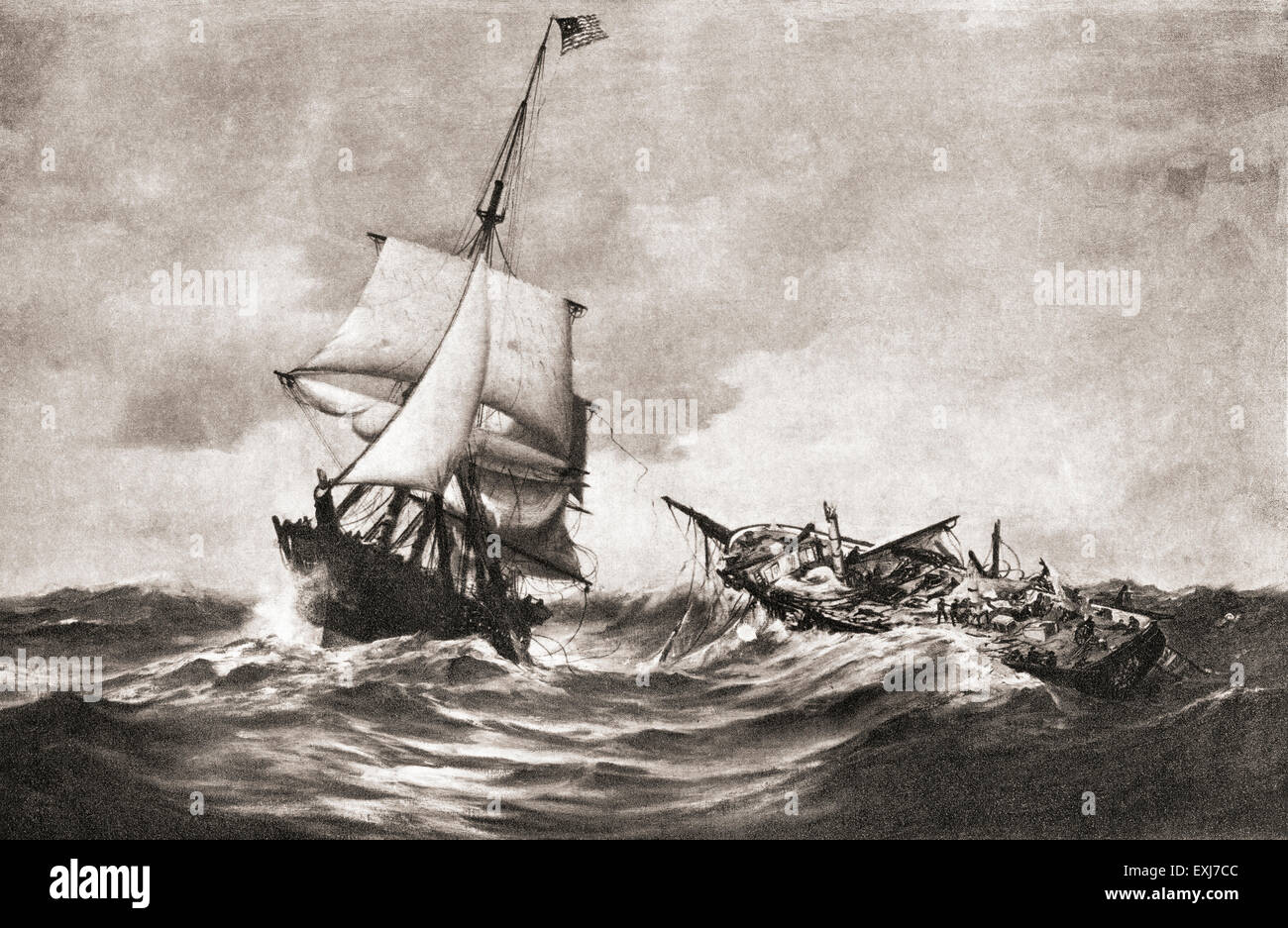 The capture of HMS Frolic by the sloop-of-war USS Wasp, a naval action fought in the Atlantic on 18 October 1812, during The War of 1812. Stock Photohttps://www.alamy.com/image-license-details/?v=1https://www.alamy.com/stock-photo-the-capture-of-hms-frolic-by-the-sloop-of-war-uss-wasp-a-naval-action-85223500.html
The capture of HMS Frolic by the sloop-of-war USS Wasp, a naval action fought in the Atlantic on 18 October 1812, during The War of 1812. Stock Photohttps://www.alamy.com/image-license-details/?v=1https://www.alamy.com/stock-photo-the-capture-of-hms-frolic-by-the-sloop-of-war-uss-wasp-a-naval-action-85223500.htmlRMEXJ7CC–The capture of HMS Frolic by the sloop-of-war USS Wasp, a naval action fought in the Atlantic on 18 October 1812, during The War of 1812.
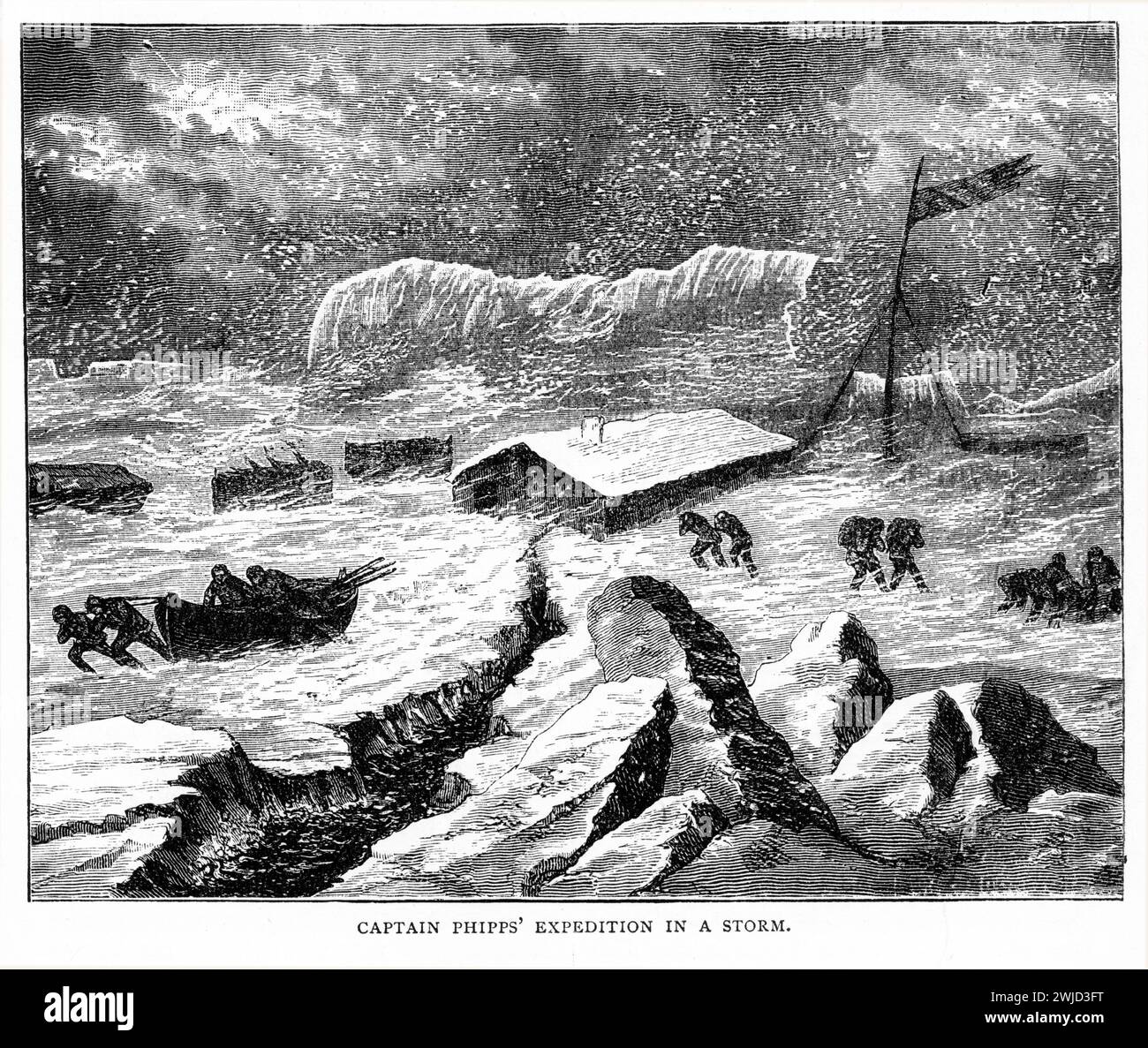 Engraving of Captain John Phipps and crew during the Arctic expedition of 1773, image published circa 1900. The 1773 Phipps expedition towards the North Pole was a British Royal Navy expedition suggested by the Royal Society and especially its vice president Daines Barrington, who believed in an ice-free Open Polar Sea. Two bomb vessels, HMS Racehorse and HMS Carcass, were modified for greater protection against ice and sailed towards the North Pole in the summer of 1773 under the commands of Constantine John Phipps and Skeffington Lutwidge. The ships became stuck in ice near Svalbard. The rep Stock Photohttps://www.alamy.com/image-license-details/?v=1https://www.alamy.com/engraving-of-captain-john-phipps-and-crew-during-the-arctic-expedition-of-1773-image-published-circa-1900-the-1773-phipps-expedition-towards-the-north-pole-was-a-british-royal-navy-expedition-suggested-by-the-royal-society-and-especially-its-vice-president-daines-barrington-who-believed-in-an-ice-free-open-polar-sea-two-bomb-vessels-hms-racehorse-and-hms-carcass-were-modified-for-greater-protection-against-ice-and-sailed-towards-the-north-pole-in-the-summer-of-1773-under-the-commands-of-constantine-john-phipps-and-skeffington-lutwidge-the-ships-became-stuck-in-ice-near-svalbard-the-rep-image596504492.html
Engraving of Captain John Phipps and crew during the Arctic expedition of 1773, image published circa 1900. The 1773 Phipps expedition towards the North Pole was a British Royal Navy expedition suggested by the Royal Society and especially its vice president Daines Barrington, who believed in an ice-free Open Polar Sea. Two bomb vessels, HMS Racehorse and HMS Carcass, were modified for greater protection against ice and sailed towards the North Pole in the summer of 1773 under the commands of Constantine John Phipps and Skeffington Lutwidge. The ships became stuck in ice near Svalbard. The rep Stock Photohttps://www.alamy.com/image-license-details/?v=1https://www.alamy.com/engraving-of-captain-john-phipps-and-crew-during-the-arctic-expedition-of-1773-image-published-circa-1900-the-1773-phipps-expedition-towards-the-north-pole-was-a-british-royal-navy-expedition-suggested-by-the-royal-society-and-especially-its-vice-president-daines-barrington-who-believed-in-an-ice-free-open-polar-sea-two-bomb-vessels-hms-racehorse-and-hms-carcass-were-modified-for-greater-protection-against-ice-and-sailed-towards-the-north-pole-in-the-summer-of-1773-under-the-commands-of-constantine-john-phipps-and-skeffington-lutwidge-the-ships-became-stuck-in-ice-near-svalbard-the-rep-image596504492.htmlRM2WJD3FT–Engraving of Captain John Phipps and crew during the Arctic expedition of 1773, image published circa 1900. The 1773 Phipps expedition towards the North Pole was a British Royal Navy expedition suggested by the Royal Society and especially its vice president Daines Barrington, who believed in an ice-free Open Polar Sea. Two bomb vessels, HMS Racehorse and HMS Carcass, were modified for greater protection against ice and sailed towards the North Pole in the summer of 1773 under the commands of Constantine John Phipps and Skeffington Lutwidge. The ships became stuck in ice near Svalbard. The rep
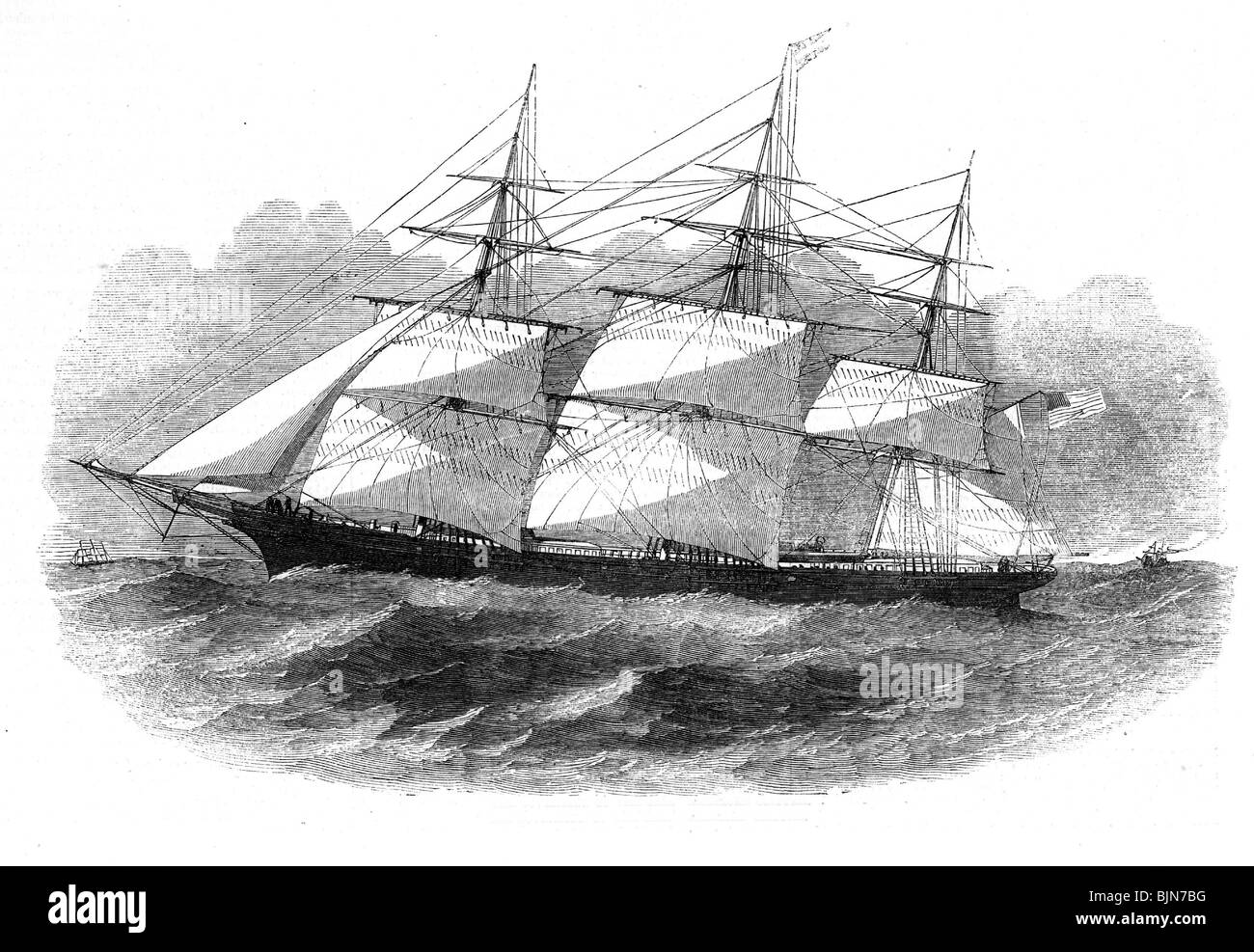 transport / transportation, navigation, sailing ships, clipper, 'The Sovereign of the Seas', American sailing ship, wood engraving, circa 1853, Stock Photohttps://www.alamy.com/image-license-details/?v=1https://www.alamy.com/stock-photo-transport-transportation-navigation-sailing-ships-clipper-the-sovereign-28740980.html
transport / transportation, navigation, sailing ships, clipper, 'The Sovereign of the Seas', American sailing ship, wood engraving, circa 1853, Stock Photohttps://www.alamy.com/image-license-details/?v=1https://www.alamy.com/stock-photo-transport-transportation-navigation-sailing-ships-clipper-the-sovereign-28740980.htmlRMBJN7BG–transport / transportation, navigation, sailing ships, clipper, 'The Sovereign of the Seas', American sailing ship, wood engraving, circa 1853,
 This 19th-century drawing shows a cutter with sails. Stock Photohttps://www.alamy.com/image-license-details/?v=1https://www.alamy.com/stock-photo-this-19th-century-drawing-shows-a-cutter-with-sails-112045318.html
This 19th-century drawing shows a cutter with sails. Stock Photohttps://www.alamy.com/image-license-details/?v=1https://www.alamy.com/stock-photo-this-19th-century-drawing-shows-a-cutter-with-sails-112045318.htmlRFGE82XE–This 19th-century drawing shows a cutter with sails.
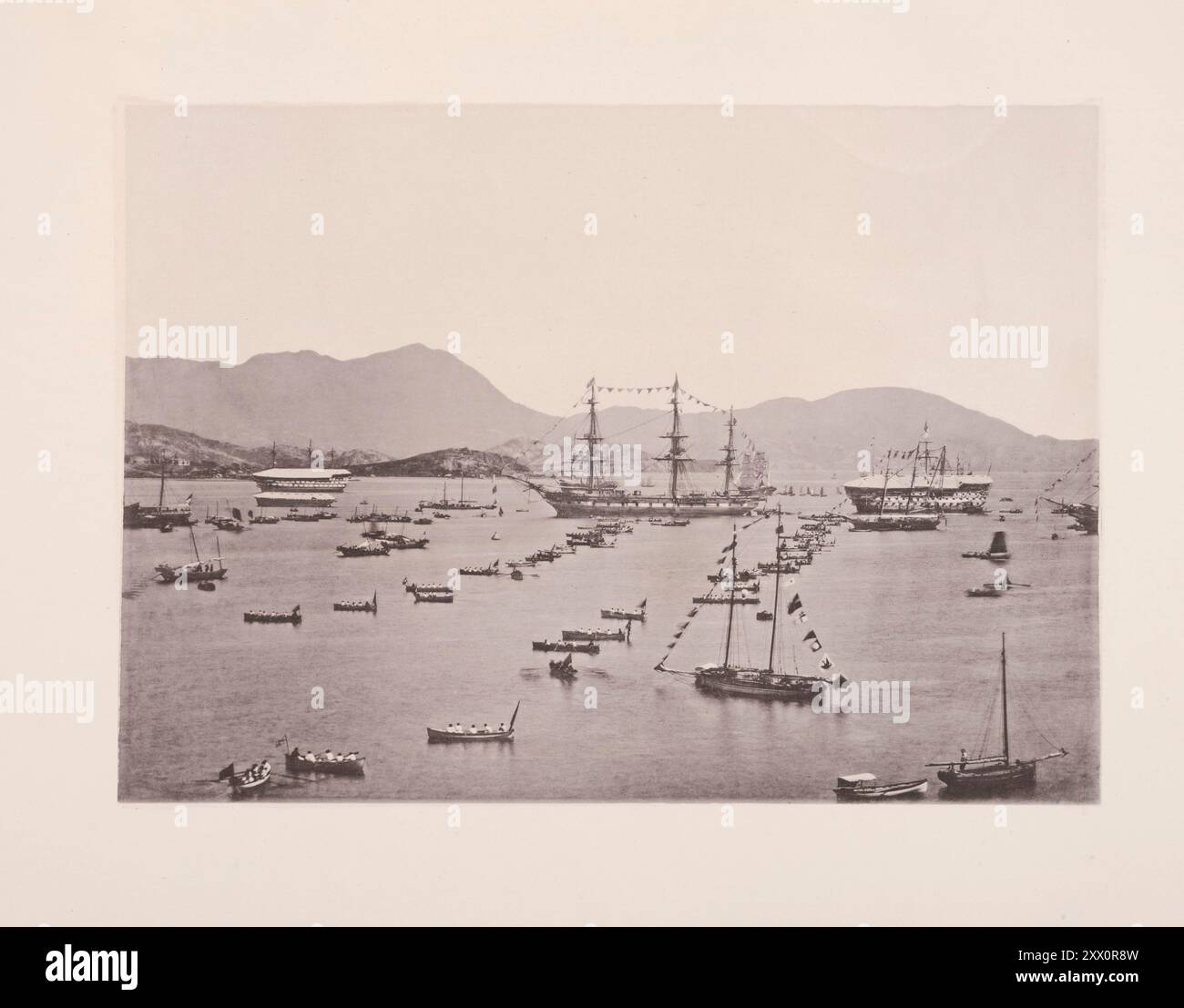 Vintage photo of the 19th-century Hong Kong's harbour . Illustration of China, 1875 Hong Kong is a special administrative region of the People's Republic of China. With 7.4 million residents of various nationalities in a 1,104-square-kilometre (426 sq mi) territory, Hong Kong is one of the most densely populated territories in the world. Hong Kong was established as a colony of the British Empire after the Qing dynasty ceded Hong Kong Island in 1841–1842 as a consequence of losing the First Opium War. The colony expanded to the Kowloon Peninsula in 1860 and was further extended when the United Stock Photohttps://www.alamy.com/image-license-details/?v=1https://www.alamy.com/vintage-photo-of-the-19th-century-hong-kongs-harbour-illustration-of-china-1875-hong-kong-is-a-special-administrative-region-of-the-peoples-republic-of-china-with-74-million-residents-of-various-nationalities-in-a-1104-square-kilometre-426-sq-mi-territory-hong-kong-is-one-of-the-most-densely-populated-territories-in-the-world-hong-kong-was-established-as-a-colony-of-the-british-empire-after-the-qing-dynasty-ceded-hong-kong-island-in-18411842-as-a-consequence-of-losing-the-first-opium-war-the-colony-expanded-to-the-kowloon-peninsula-in-1860-and-was-further-extended-when-the-united-image618362217.html
Vintage photo of the 19th-century Hong Kong's harbour . Illustration of China, 1875 Hong Kong is a special administrative region of the People's Republic of China. With 7.4 million residents of various nationalities in a 1,104-square-kilometre (426 sq mi) territory, Hong Kong is one of the most densely populated territories in the world. Hong Kong was established as a colony of the British Empire after the Qing dynasty ceded Hong Kong Island in 1841–1842 as a consequence of losing the First Opium War. The colony expanded to the Kowloon Peninsula in 1860 and was further extended when the United Stock Photohttps://www.alamy.com/image-license-details/?v=1https://www.alamy.com/vintage-photo-of-the-19th-century-hong-kongs-harbour-illustration-of-china-1875-hong-kong-is-a-special-administrative-region-of-the-peoples-republic-of-china-with-74-million-residents-of-various-nationalities-in-a-1104-square-kilometre-426-sq-mi-territory-hong-kong-is-one-of-the-most-densely-populated-territories-in-the-world-hong-kong-was-established-as-a-colony-of-the-british-empire-after-the-qing-dynasty-ceded-hong-kong-island-in-18411842-as-a-consequence-of-losing-the-first-opium-war-the-colony-expanded-to-the-kowloon-peninsula-in-1860-and-was-further-extended-when-the-united-image618362217.htmlRM2XX0R8W–Vintage photo of the 19th-century Hong Kong's harbour . Illustration of China, 1875 Hong Kong is a special administrative region of the People's Republic of China. With 7.4 million residents of various nationalities in a 1,104-square-kilometre (426 sq mi) territory, Hong Kong is one of the most densely populated territories in the world. Hong Kong was established as a colony of the British Empire after the Qing dynasty ceded Hong Kong Island in 1841–1842 as a consequence of losing the First Opium War. The colony expanded to the Kowloon Peninsula in 1860 and was further extended when the United
![[ 1870s Japan - Japanese Cargo Vessels ] — Cargo vessels at Nagasaki. Published in the Illustrated London News on December 15, 1877 (Meiji 10). 19th century vintage newspaper illustration. Stock Photo [ 1870s Japan - Japanese Cargo Vessels ] — Cargo vessels at Nagasaki. Published in the Illustrated London News on December 15, 1877 (Meiji 10). 19th century vintage newspaper illustration. Stock Photo](https://c8.alamy.com/comp/W9K9PP/1870s-japan-japanese-cargo-vessels-cargo-vessels-at-nagasaki-published-in-the-illustrated-london-news-on-december-15-1877-meiji-10-19th-century-vintage-newspaper-illustration-W9K9PP.jpg) [ 1870s Japan - Japanese Cargo Vessels ] — Cargo vessels at Nagasaki. Published in the Illustrated London News on December 15, 1877 (Meiji 10). 19th century vintage newspaper illustration. Stock Photohttps://www.alamy.com/image-license-details/?v=1https://www.alamy.com/1870s-japan-japanese-cargo-vessels-cargo-vessels-at-nagasaki-published-in-the-illustrated-london-news-on-december-15-1877-meiji-10-19th-century-vintage-newspaper-illustration-image264112206.html
[ 1870s Japan - Japanese Cargo Vessels ] — Cargo vessels at Nagasaki. Published in the Illustrated London News on December 15, 1877 (Meiji 10). 19th century vintage newspaper illustration. Stock Photohttps://www.alamy.com/image-license-details/?v=1https://www.alamy.com/1870s-japan-japanese-cargo-vessels-cargo-vessels-at-nagasaki-published-in-the-illustrated-london-news-on-december-15-1877-meiji-10-19th-century-vintage-newspaper-illustration-image264112206.htmlRMW9K9PP–[ 1870s Japan - Japanese Cargo Vessels ] — Cargo vessels at Nagasaki. Published in the Illustrated London News on December 15, 1877 (Meiji 10). 19th century vintage newspaper illustration.
 A traditional pulley. Double. Wood. Used in sailing ships. Late 19th century. Museum of History and Navigation. Riga. Latvia. Stock Photohttps://www.alamy.com/image-license-details/?v=1https://www.alamy.com/a-traditional-pulley-double-wood-used-in-sailing-ships-late-19th-century-museum-of-history-and-navigation-riga-latvia-image231229821.html
A traditional pulley. Double. Wood. Used in sailing ships. Late 19th century. Museum of History and Navigation. Riga. Latvia. Stock Photohttps://www.alamy.com/image-license-details/?v=1https://www.alamy.com/a-traditional-pulley-double-wood-used-in-sailing-ships-late-19th-century-museum-of-history-and-navigation-riga-latvia-image231229821.htmlRMRC5BYW–A traditional pulley. Double. Wood. Used in sailing ships. Late 19th century. Museum of History and Navigation. Riga. Latvia.
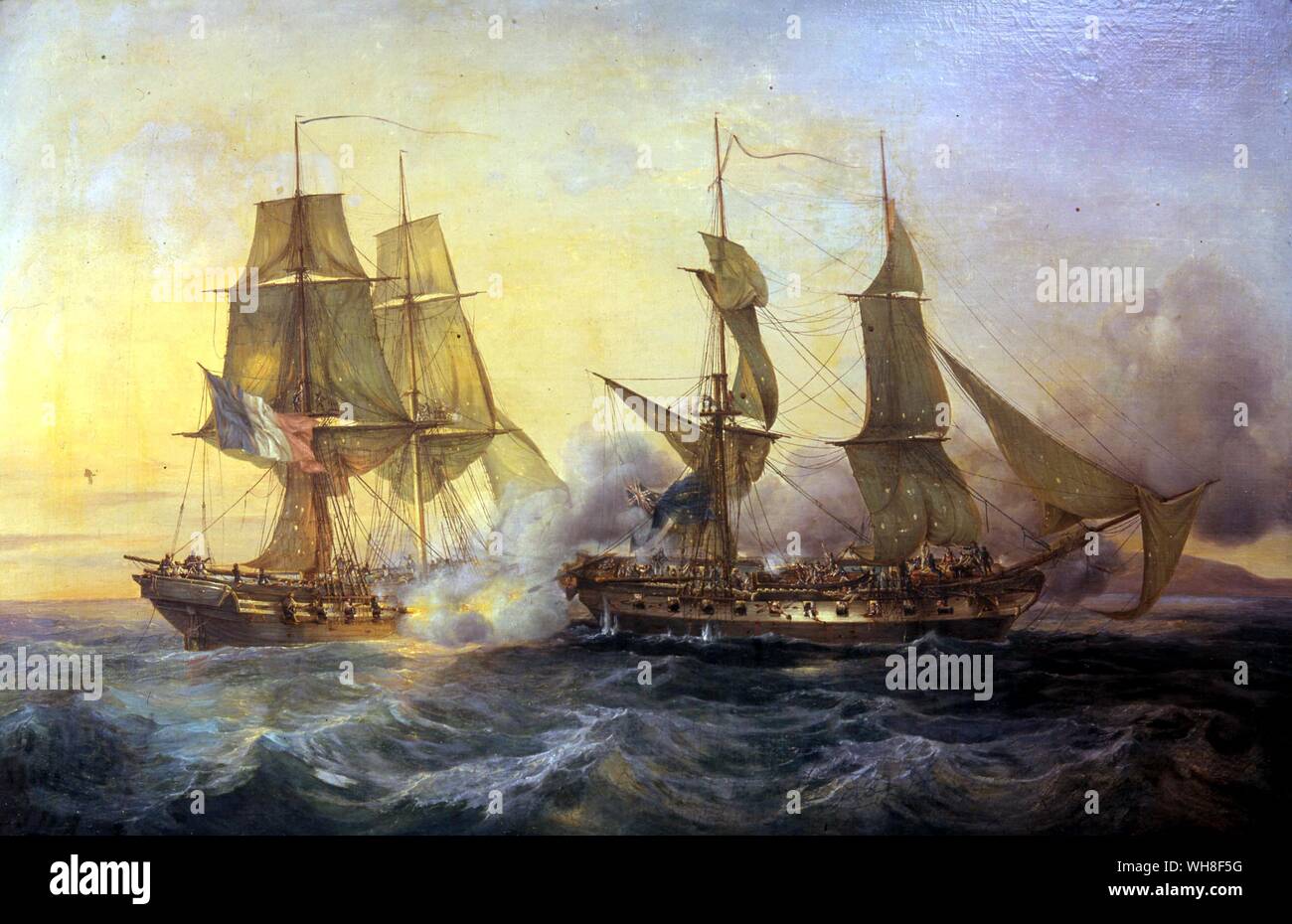 Brigs Fighting. Two-masted sailing ship with square rigging on both masts. Naval brigs carried a battery of ten to twenty guns on a single deck. In the great European Navies of the 18th and 19th centuries, they served as couriers for battle fleets and as training vessels for cadets. In the early U.S. Navy, brigs acquired distinction during the War of 1812 in small fleet engagements on the Great Lakes and as merchant raiders in the Atlantic. Square rigging required a large crew, so merchant brigs became uneconomical, and in the 19th century they began to give way to such fore-and-aft rigged Stock Photohttps://www.alamy.com/image-license-details/?v=1https://www.alamy.com/brigs-fighting-two-masted-sailing-ship-with-square-rigging-on-both-masts-naval-brigs-carried-a-battery-of-ten-to-twenty-guns-on-a-single-deck-in-the-great-european-navies-of-the-18th-and-19th-centuries-they-served-as-couriers-for-battle-fleets-and-as-training-vessels-for-cadets-in-the-early-us-navy-brigs-acquired-distinction-during-the-war-of-1812-in-small-fleet-engagements-on-the-great-lakes-and-as-merchant-raiders-in-the-atlantic-square-rigging-required-a-large-crew-so-merchant-brigs-became-uneconomical-and-in-the-19th-century-they-began-to-give-way-to-such-fore-and-aft-rigged-image268792204.html
Brigs Fighting. Two-masted sailing ship with square rigging on both masts. Naval brigs carried a battery of ten to twenty guns on a single deck. In the great European Navies of the 18th and 19th centuries, they served as couriers for battle fleets and as training vessels for cadets. In the early U.S. Navy, brigs acquired distinction during the War of 1812 in small fleet engagements on the Great Lakes and as merchant raiders in the Atlantic. Square rigging required a large crew, so merchant brigs became uneconomical, and in the 19th century they began to give way to such fore-and-aft rigged Stock Photohttps://www.alamy.com/image-license-details/?v=1https://www.alamy.com/brigs-fighting-two-masted-sailing-ship-with-square-rigging-on-both-masts-naval-brigs-carried-a-battery-of-ten-to-twenty-guns-on-a-single-deck-in-the-great-european-navies-of-the-18th-and-19th-centuries-they-served-as-couriers-for-battle-fleets-and-as-training-vessels-for-cadets-in-the-early-us-navy-brigs-acquired-distinction-during-the-war-of-1812-in-small-fleet-engagements-on-the-great-lakes-and-as-merchant-raiders-in-the-atlantic-square-rigging-required-a-large-crew-so-merchant-brigs-became-uneconomical-and-in-the-19th-century-they-began-to-give-way-to-such-fore-and-aft-rigged-image268792204.htmlRMWH8F5G–Brigs Fighting. Two-masted sailing ship with square rigging on both masts. Naval brigs carried a battery of ten to twenty guns on a single deck. In the great European Navies of the 18th and 19th centuries, they served as couriers for battle fleets and as training vessels for cadets. In the early U.S. Navy, brigs acquired distinction during the War of 1812 in small fleet engagements on the Great Lakes and as merchant raiders in the Atlantic. Square rigging required a large crew, so merchant brigs became uneconomical, and in the 19th century they began to give way to such fore-and-aft rigged
 Vintage print of Tygert-Allen Fertilizer Company of Philadelphia, Philadelphia. Stock Photohttps://www.alamy.com/image-license-details/?v=1https://www.alamy.com/vintage-print-of-tygert-allen-fertilizer-company-of-philadelphia-philadelphia-image552925327.html
Vintage print of Tygert-Allen Fertilizer Company of Philadelphia, Philadelphia. Stock Photohttps://www.alamy.com/image-license-details/?v=1https://www.alamy.com/vintage-print-of-tygert-allen-fertilizer-company-of-philadelphia-philadelphia-image552925327.htmlRM2R3FWW3–Vintage print of Tygert-Allen Fertilizer Company of Philadelphia, Philadelphia.
 EGYPT Ships, bar, Rosetta Nile 1854. Illustrated London News Stock Photohttps://www.alamy.com/image-license-details/?v=1https://www.alamy.com/stock-photo-egypt-ships-bar-rosetta-nile-1854-illustrated-london-news-95368872.html
EGYPT Ships, bar, Rosetta Nile 1854. Illustrated London News Stock Photohttps://www.alamy.com/image-license-details/?v=1https://www.alamy.com/stock-photo-egypt-ships-bar-rosetta-nile-1854-illustrated-london-news-95368872.htmlRFFF4BY4–EGYPT Ships, bar, Rosetta Nile 1854. Illustrated London News
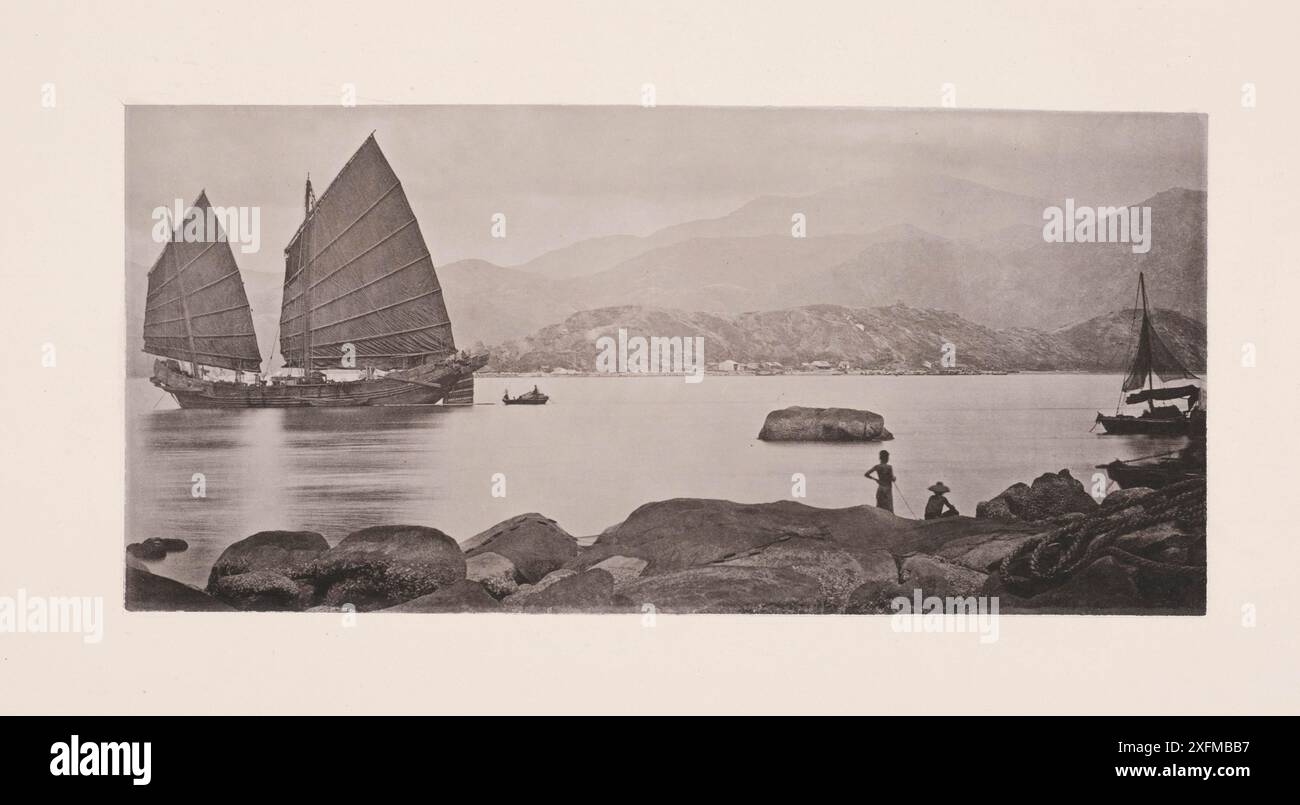 Vintage photo of a Canton junk. Illustration of Qing China, 1875 The term junk, applied by Europeans to all Chinese craft, whether trading vessels or ships of war, is probably derived from 'jung', the Javanese word for a large boat or vessel. Chinese ships vary in dimensions, model, and appearance, in the different parts of the Empire as much as do the sailing craft of Europe. The vessel under sail on the left of the photograph is a coasting trader of Kwang-tung build, and may be regarded as one of the clipper fleet of Southern China. It looks heavy and unhandy, but it will make good sailing w Stock Photohttps://www.alamy.com/image-license-details/?v=1https://www.alamy.com/vintage-photo-of-a-canton-junk-illustration-of-qing-china-1875-the-term-junk-applied-by-europeans-to-all-chinese-craft-whether-trading-vessels-or-ships-of-war-is-probably-derived-from-jung-the-javanese-word-for-a-large-boat-or-vessel-chinese-ships-vary-in-dimensions-model-and-appearance-in-the-different-parts-of-the-empire-as-much-as-do-the-sailing-craft-of-europe-the-vessel-under-sail-on-the-left-of-the-photograph-is-a-coasting-trader-of-kwang-tung-build-and-may-be-regarded-as-one-of-the-clipper-fleet-of-southern-china-it-looks-heavy-and-unhandy-but-it-will-make-good-sailing-w-image612030699.html
Vintage photo of a Canton junk. Illustration of Qing China, 1875 The term junk, applied by Europeans to all Chinese craft, whether trading vessels or ships of war, is probably derived from 'jung', the Javanese word for a large boat or vessel. Chinese ships vary in dimensions, model, and appearance, in the different parts of the Empire as much as do the sailing craft of Europe. The vessel under sail on the left of the photograph is a coasting trader of Kwang-tung build, and may be regarded as one of the clipper fleet of Southern China. It looks heavy and unhandy, but it will make good sailing w Stock Photohttps://www.alamy.com/image-license-details/?v=1https://www.alamy.com/vintage-photo-of-a-canton-junk-illustration-of-qing-china-1875-the-term-junk-applied-by-europeans-to-all-chinese-craft-whether-trading-vessels-or-ships-of-war-is-probably-derived-from-jung-the-javanese-word-for-a-large-boat-or-vessel-chinese-ships-vary-in-dimensions-model-and-appearance-in-the-different-parts-of-the-empire-as-much-as-do-the-sailing-craft-of-europe-the-vessel-under-sail-on-the-left-of-the-photograph-is-a-coasting-trader-of-kwang-tung-build-and-may-be-regarded-as-one-of-the-clipper-fleet-of-southern-china-it-looks-heavy-and-unhandy-but-it-will-make-good-sailing-w-image612030699.htmlRM2XFMBB7–Vintage photo of a Canton junk. Illustration of Qing China, 1875 The term junk, applied by Europeans to all Chinese craft, whether trading vessels or ships of war, is probably derived from 'jung', the Javanese word for a large boat or vessel. Chinese ships vary in dimensions, model, and appearance, in the different parts of the Empire as much as do the sailing craft of Europe. The vessel under sail on the left of the photograph is a coasting trader of Kwang-tung build, and may be regarded as one of the clipper fleet of Southern China. It looks heavy and unhandy, but it will make good sailing w
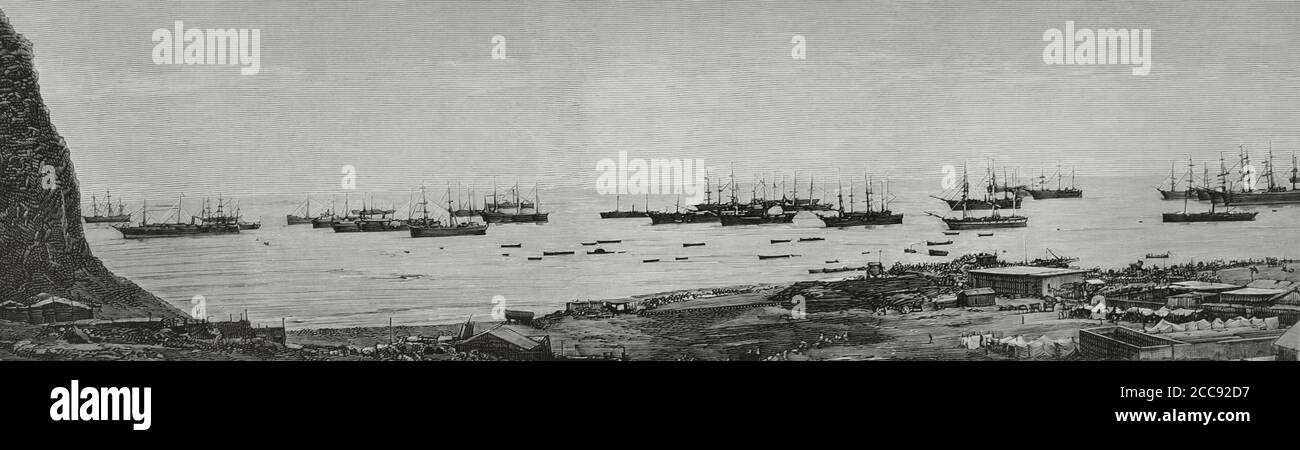 Pacific War or Saltpeter War. Armed conflict between 1879-1883 that pitted Chile against its allies Bolivia and Peru. Panoramic view of the Bay and Port of Arica, when the third Chilean expedition embarked on December 15, 1880. Engraving. La Ilustracion Española y Americana, 1881. Stock Photohttps://www.alamy.com/image-license-details/?v=1https://www.alamy.com/pacific-war-or-saltpeter-war-armed-conflict-between-1879-1883-that-pitted-chile-against-its-allies-bolivia-and-peru-panoramic-view-of-the-bay-and-port-of-arica-when-the-third-chilean-expedition-embarked-on-december-15-1880-engraving-la-ilustracion-espaola-y-americana-1881-image368993107.html
Pacific War or Saltpeter War. Armed conflict between 1879-1883 that pitted Chile against its allies Bolivia and Peru. Panoramic view of the Bay and Port of Arica, when the third Chilean expedition embarked on December 15, 1880. Engraving. La Ilustracion Española y Americana, 1881. Stock Photohttps://www.alamy.com/image-license-details/?v=1https://www.alamy.com/pacific-war-or-saltpeter-war-armed-conflict-between-1879-1883-that-pitted-chile-against-its-allies-bolivia-and-peru-panoramic-view-of-the-bay-and-port-of-arica-when-the-third-chilean-expedition-embarked-on-december-15-1880-engraving-la-ilustracion-espaola-y-americana-1881-image368993107.htmlRM2CC92D7–Pacific War or Saltpeter War. Armed conflict between 1879-1883 that pitted Chile against its allies Bolivia and Peru. Panoramic view of the Bay and Port of Arica, when the third Chilean expedition embarked on December 15, 1880. Engraving. La Ilustracion Española y Americana, 1881.
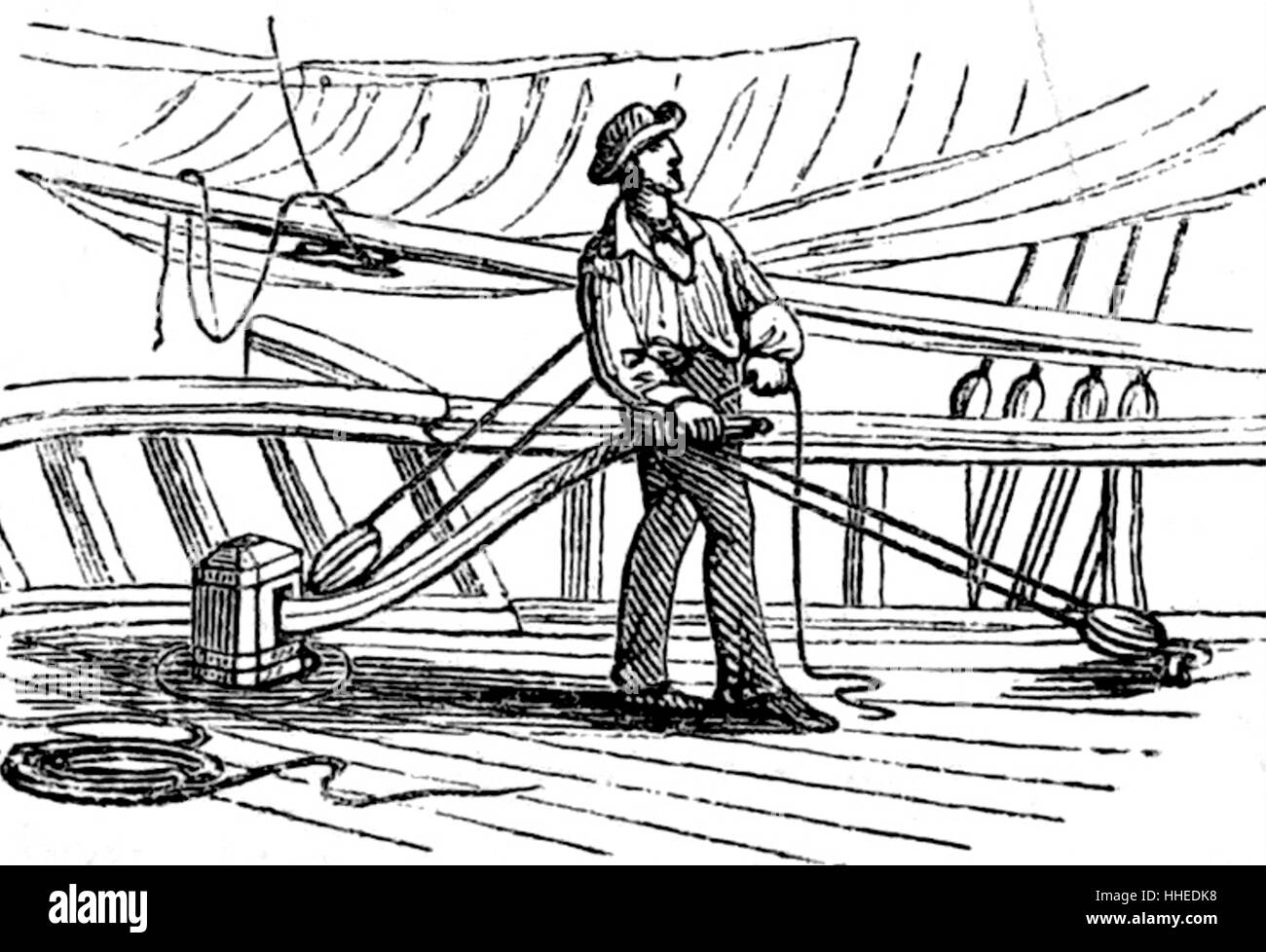 Engraving of a relieving tackle is tackle employing one or more lines attached to a vessel's steering mechanism, to assist or substitute for the whipstaff or ship's wheel in steering the craft. Dated 19th Century Stock Photohttps://www.alamy.com/image-license-details/?v=1https://www.alamy.com/stock-photo-engraving-of-a-relieving-tackle-is-tackle-employing-one-or-more-lines-131239788.html
Engraving of a relieving tackle is tackle employing one or more lines attached to a vessel's steering mechanism, to assist or substitute for the whipstaff or ship's wheel in steering the craft. Dated 19th Century Stock Photohttps://www.alamy.com/image-license-details/?v=1https://www.alamy.com/stock-photo-engraving-of-a-relieving-tackle-is-tackle-employing-one-or-more-lines-131239788.htmlRMHHEDK8–Engraving of a relieving tackle is tackle employing one or more lines attached to a vessel's steering mechanism, to assist or substitute for the whipstaff or ship's wheel in steering the craft. Dated 19th Century
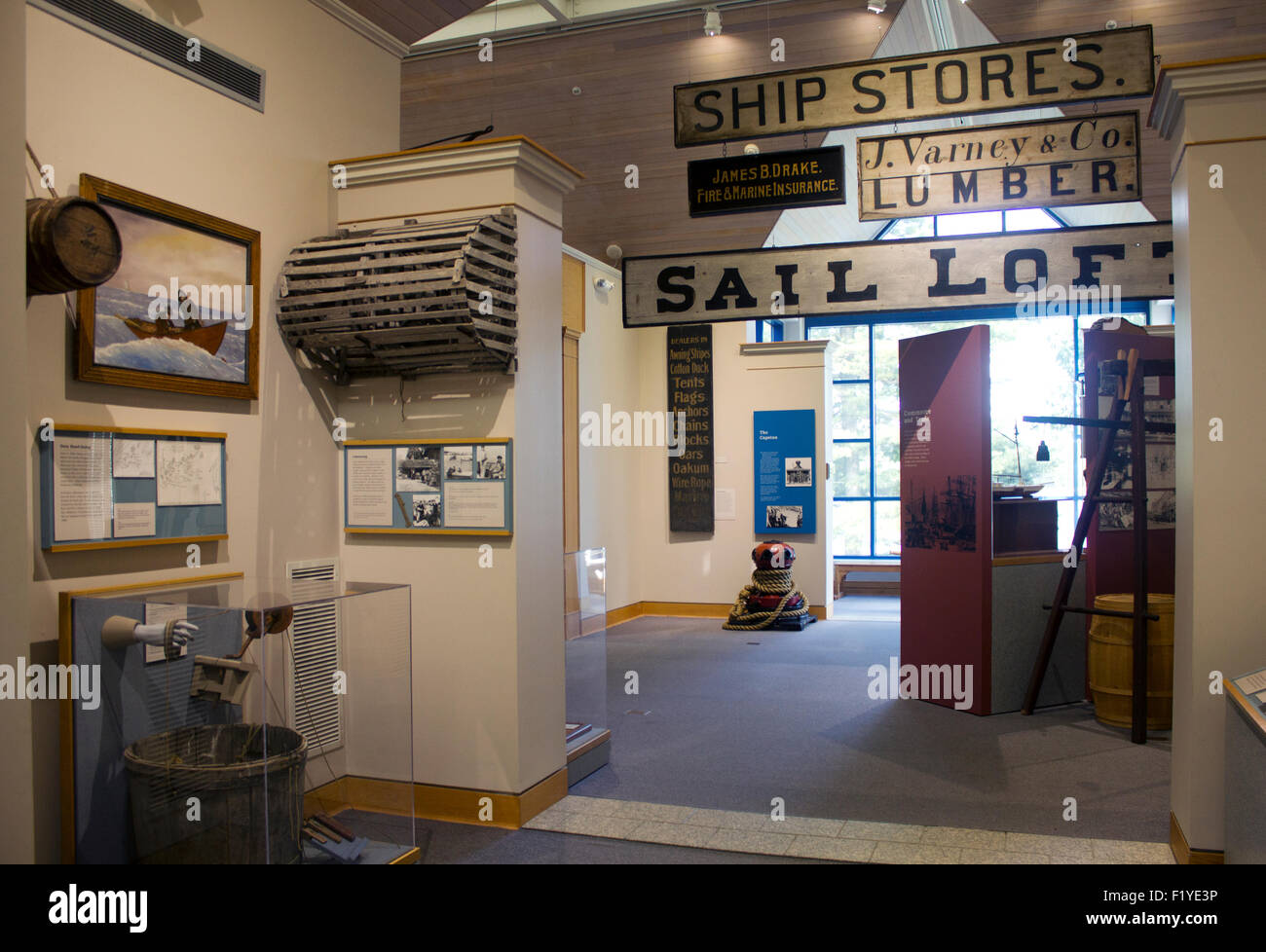 The Maine Maritime Museum in Bath, Maine. Features the history of 19th century ship building, vessels, and commercial voyages. Stock Photohttps://www.alamy.com/image-license-details/?v=1https://www.alamy.com/stock-photo-the-maine-maritime-museum-in-bath-maine-features-the-history-of-19th-87270282.html
The Maine Maritime Museum in Bath, Maine. Features the history of 19th century ship building, vessels, and commercial voyages. Stock Photohttps://www.alamy.com/image-license-details/?v=1https://www.alamy.com/stock-photo-the-maine-maritime-museum-in-bath-maine-features-the-history-of-19th-87270282.htmlRMF1YE3P–The Maine Maritime Museum in Bath, Maine. Features the history of 19th century ship building, vessels, and commercial voyages.
 Drives of steam vessels or steamers by steam engines and propellers, 19th Century,Historische, zeichnerische Darstellung, Antieb Stock Photohttps://www.alamy.com/image-license-details/?v=1https://www.alamy.com/stock-photo-drives-of-steam-vessels-or-steamers-by-steam-engines-and-propellers-48124859.html
Drives of steam vessels or steamers by steam engines and propellers, 19th Century,Historische, zeichnerische Darstellung, Antieb Stock Photohttps://www.alamy.com/image-license-details/?v=1https://www.alamy.com/stock-photo-drives-of-steam-vessels-or-steamers-by-steam-engines-and-propellers-48124859.htmlRMCP87MY–Drives of steam vessels or steamers by steam engines and propellers, 19th Century,Historische, zeichnerische Darstellung, Antieb
 Ships Vessels of various kind Copperplate engraving From the Encyclopaedia Londinensis or, Universal dictionary of arts, sciences, and literature; Volume XXIII; Edited by Wilkes, John. Published in London in 1828 Stock Photohttps://www.alamy.com/image-license-details/?v=1https://www.alamy.com/ships-vessels-of-various-kind-copperplate-engraving-from-the-encyclopaedia-londinensis-or-universal-dictionary-of-arts-sciences-and-literature-volume-xxiii-edited-by-wilkes-john-published-in-london-in-1828-image440648436.html
Ships Vessels of various kind Copperplate engraving From the Encyclopaedia Londinensis or, Universal dictionary of arts, sciences, and literature; Volume XXIII; Edited by Wilkes, John. Published in London in 1828 Stock Photohttps://www.alamy.com/image-license-details/?v=1https://www.alamy.com/ships-vessels-of-various-kind-copperplate-engraving-from-the-encyclopaedia-londinensis-or-universal-dictionary-of-arts-sciences-and-literature-volume-xxiii-edited-by-wilkes-john-published-in-london-in-1828-image440648436.htmlRF2GGW7G4–Ships Vessels of various kind Copperplate engraving From the Encyclopaedia Londinensis or, Universal dictionary of arts, sciences, and literature; Volume XXIII; Edited by Wilkes, John. Published in London in 1828
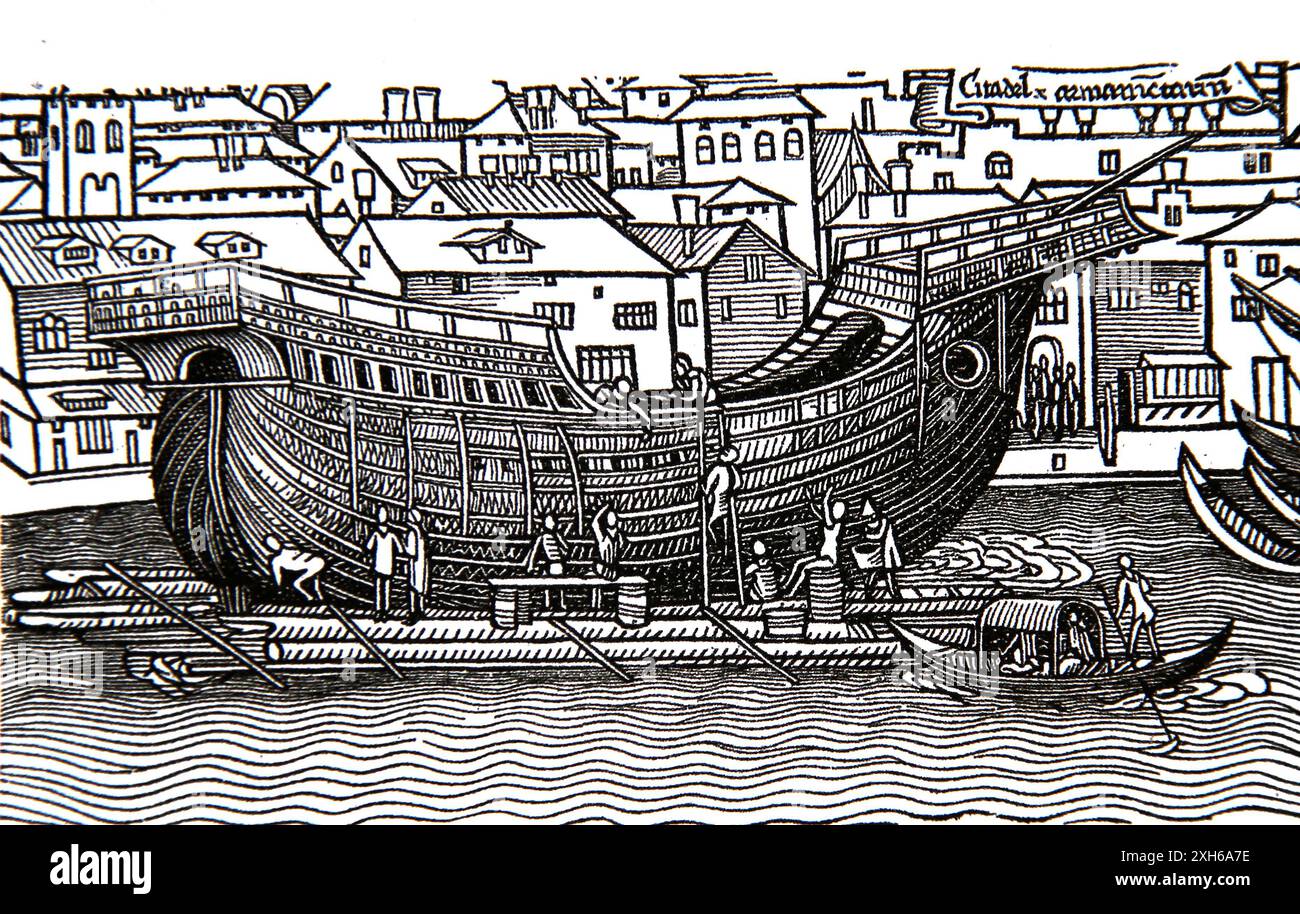 Ship hull on dry dock. Modern period. 15th century. Europe. Engraving, 19th century. Stock Photohttps://www.alamy.com/image-license-details/?v=1https://www.alamy.com/ship-hull-on-dry-dock-modern-period-15th-century-europe-engraving-19th-century-image612951794.html
Ship hull on dry dock. Modern period. 15th century. Europe. Engraving, 19th century. Stock Photohttps://www.alamy.com/image-license-details/?v=1https://www.alamy.com/ship-hull-on-dry-dock-modern-period-15th-century-europe-engraving-19th-century-image612951794.htmlRM2XH6A7E–Ship hull on dry dock. Modern period. 15th century. Europe. Engraving, 19th century.
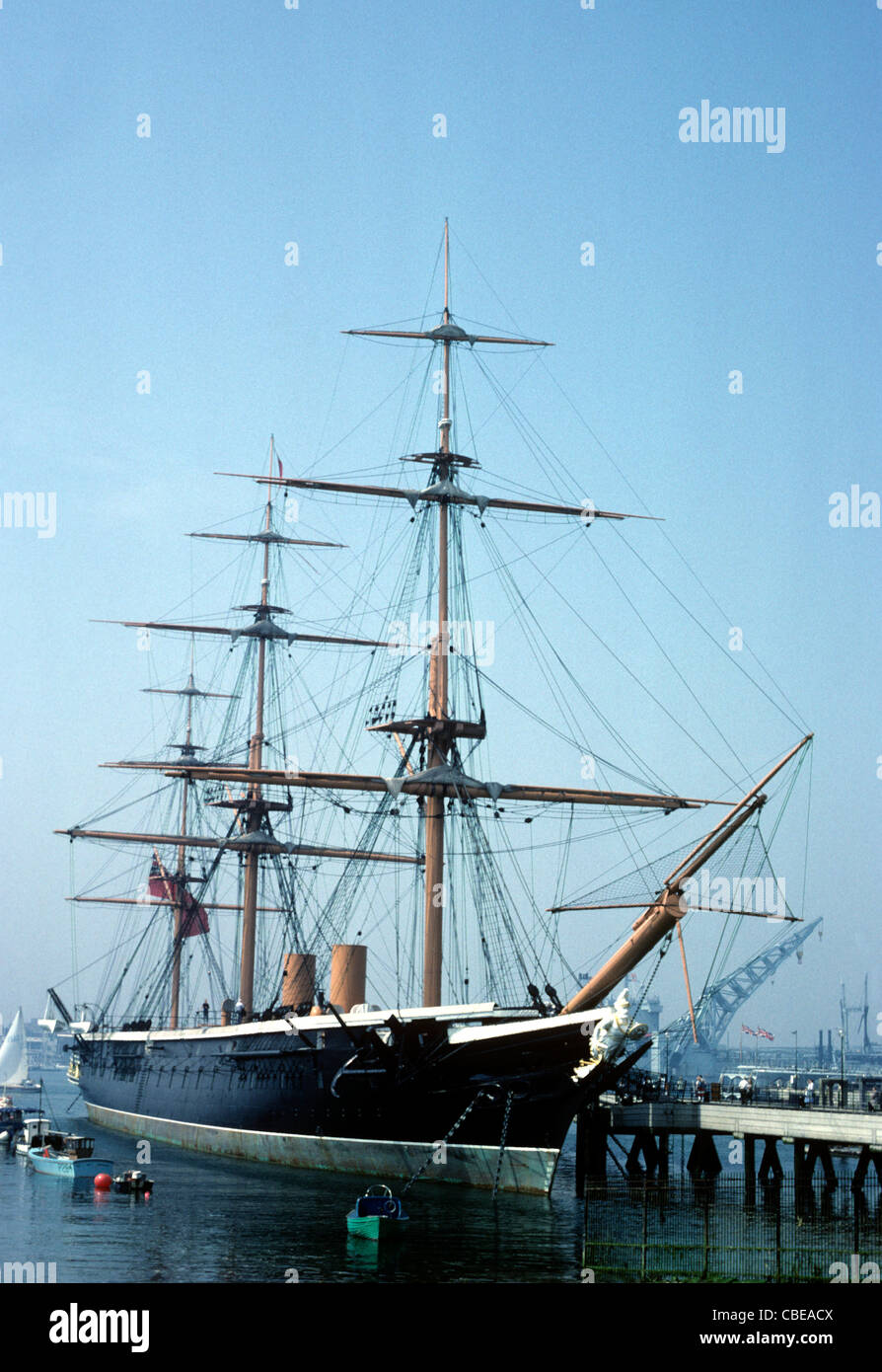 Portsmouth, Hampshire, HMS Warrior vintage battle ship ships England UK English nineteenth century Victorian vessel vessels Stock Photohttps://www.alamy.com/image-license-details/?v=1https://www.alamy.com/stock-photo-portsmouth-hampshire-hms-warrior-vintage-battle-ship-ships-england-41497482.html
Portsmouth, Hampshire, HMS Warrior vintage battle ship ships England UK English nineteenth century Victorian vessel vessels Stock Photohttps://www.alamy.com/image-license-details/?v=1https://www.alamy.com/stock-photo-portsmouth-hampshire-hms-warrior-vintage-battle-ship-ships-england-41497482.htmlRFCBEACX–Portsmouth, Hampshire, HMS Warrior vintage battle ship ships England UK English nineteenth century Victorian vessel vessels
 A late 19th century view of shipping at Partick on the north bank of the River Clyde, just across from Govan, Glasgow, Scotland. The rapid expansion of Partick's industry was based on the continually deepened Clyde from the early 1820's by steam-powered dredgers. This dredging process soon provided deep-water shipping channels all the way to the harbour at the Broomielaw in the centre of Glasgow. By the 1840's the Clyde was deep and wide enough at Govan and Partick to provide for shipyards on both sides of the river, capable of building huge ocean-going vessels Stock Photohttps://www.alamy.com/image-license-details/?v=1https://www.alamy.com/a-late-19th-century-view-of-shipping-at-partick-on-the-north-bank-of-the-river-clyde-just-across-from-govan-glasgow-scotland-the-rapid-expansion-of-particks-industry-was-based-on-the-continually-deepened-clyde-from-the-early-1820s-by-steam-powered-dredgers-this-dredging-process-soon-provided-deep-water-shipping-channels-all-the-way-to-the-harbour-at-the-broomielaw-in-the-centre-of-glasgow-by-the-1840s-the-clyde-was-deep-and-wide-enough-at-govan-and-partick-to-provide-for-shipyards-on-both-sides-of-the-river-capable-of-building-huge-ocean-going-vessels-image434919190.html
A late 19th century view of shipping at Partick on the north bank of the River Clyde, just across from Govan, Glasgow, Scotland. The rapid expansion of Partick's industry was based on the continually deepened Clyde from the early 1820's by steam-powered dredgers. This dredging process soon provided deep-water shipping channels all the way to the harbour at the Broomielaw in the centre of Glasgow. By the 1840's the Clyde was deep and wide enough at Govan and Partick to provide for shipyards on both sides of the river, capable of building huge ocean-going vessels Stock Photohttps://www.alamy.com/image-license-details/?v=1https://www.alamy.com/a-late-19th-century-view-of-shipping-at-partick-on-the-north-bank-of-the-river-clyde-just-across-from-govan-glasgow-scotland-the-rapid-expansion-of-particks-industry-was-based-on-the-continually-deepened-clyde-from-the-early-1820s-by-steam-powered-dredgers-this-dredging-process-soon-provided-deep-water-shipping-channels-all-the-way-to-the-harbour-at-the-broomielaw-in-the-centre-of-glasgow-by-the-1840s-the-clyde-was-deep-and-wide-enough-at-govan-and-partick-to-provide-for-shipyards-on-both-sides-of-the-river-capable-of-building-huge-ocean-going-vessels-image434919190.htmlRM2G7G7T6–A late 19th century view of shipping at Partick on the north bank of the River Clyde, just across from Govan, Glasgow, Scotland. The rapid expansion of Partick's industry was based on the continually deepened Clyde from the early 1820's by steam-powered dredgers. This dredging process soon provided deep-water shipping channels all the way to the harbour at the Broomielaw in the centre of Glasgow. By the 1840's the Clyde was deep and wide enough at Govan and Partick to provide for shipyards on both sides of the river, capable of building huge ocean-going vessels
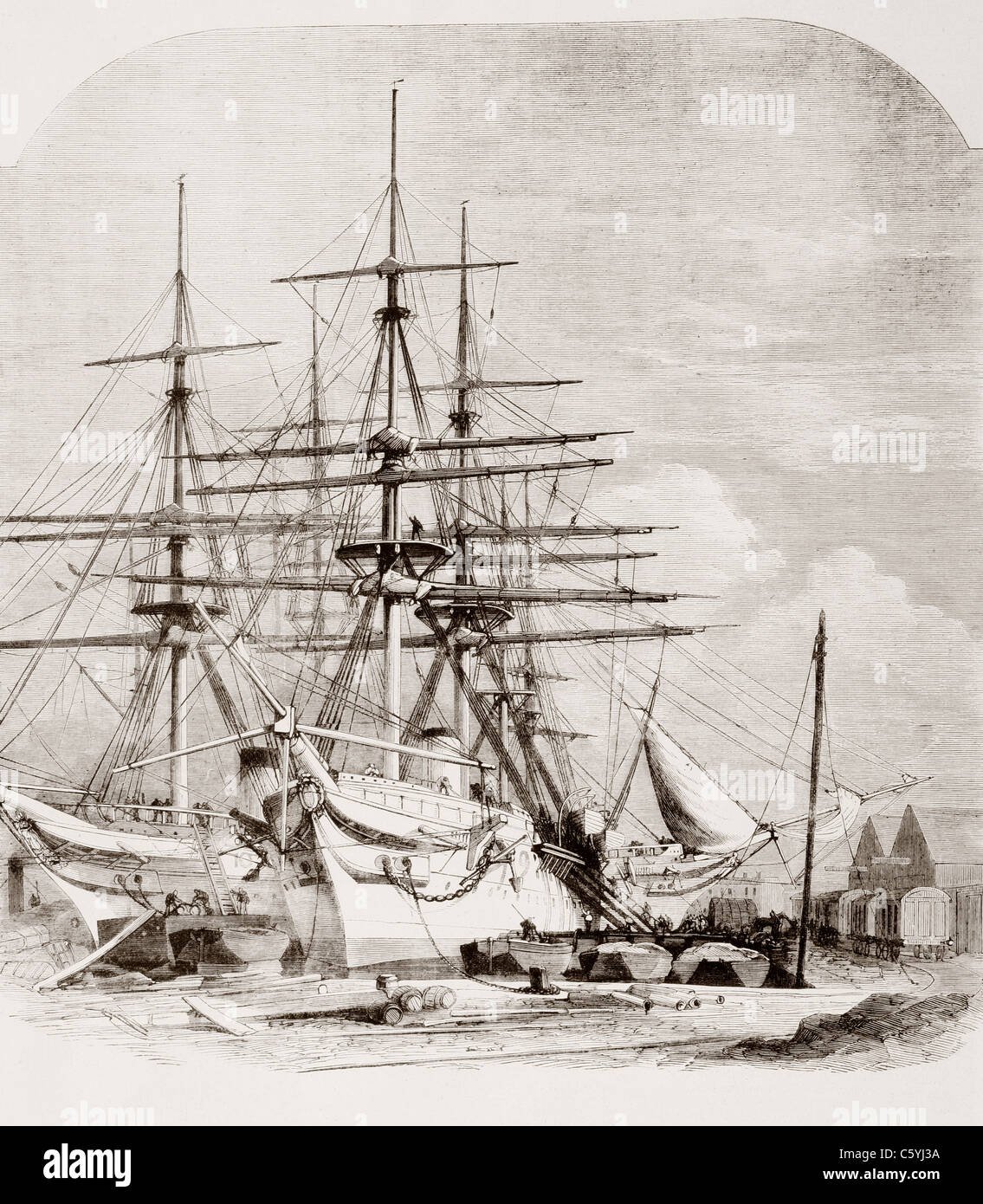 British navy hospital ships supporting the 1868 Expedition to Abyssinia. Stock Photohttps://www.alamy.com/image-license-details/?v=1https://www.alamy.com/stock-photo-british-navy-hospital-ships-supporting-the-1868-expedition-to-abyssinia-38100926.html
British navy hospital ships supporting the 1868 Expedition to Abyssinia. Stock Photohttps://www.alamy.com/image-license-details/?v=1https://www.alamy.com/stock-photo-british-navy-hospital-ships-supporting-the-1868-expedition-to-abyssinia-38100926.htmlRMC5YJ3A–British navy hospital ships supporting the 1868 Expedition to Abyssinia.
 Engraving of Captain John Phipps' ships and crew during the Arctic expedition of 1773, image published circa 1900. The ships HMS Racehorse and HMS Carcass are frozen in the ice. This was a British Royal Navy expedition suggested by the Royal Society and especially its vice president Daines Barrington, who believed in an ice-free Open Polar Sea. Two bomb vessels, HMS Racehorse and HMS Carcass, were modified for greater protection against ice and sailed towards the North Pole in the summer of 1773 under the commands of Constantine John Phipps and Skeffington Lutwidge. The ships became stuck in i Stock Photohttps://www.alamy.com/image-license-details/?v=1https://www.alamy.com/engraving-of-captain-john-phipps-ships-and-crew-during-the-arctic-expedition-of-1773-image-published-circa-1900-the-ships-hms-racehorse-and-hms-carcass-are-frozen-in-the-ice-this-was-a-british-royal-navy-expedition-suggested-by-the-royal-society-and-especially-its-vice-president-daines-barrington-who-believed-in-an-ice-free-open-polar-sea-two-bomb-vessels-hms-racehorse-and-hms-carcass-were-modified-for-greater-protection-against-ice-and-sailed-towards-the-north-pole-in-the-summer-of-1773-under-the-commands-of-constantine-john-phipps-and-skeffington-lutwidge-the-ships-became-stuck-in-i-image596504393.html
Engraving of Captain John Phipps' ships and crew during the Arctic expedition of 1773, image published circa 1900. The ships HMS Racehorse and HMS Carcass are frozen in the ice. This was a British Royal Navy expedition suggested by the Royal Society and especially its vice president Daines Barrington, who believed in an ice-free Open Polar Sea. Two bomb vessels, HMS Racehorse and HMS Carcass, were modified for greater protection against ice and sailed towards the North Pole in the summer of 1773 under the commands of Constantine John Phipps and Skeffington Lutwidge. The ships became stuck in i Stock Photohttps://www.alamy.com/image-license-details/?v=1https://www.alamy.com/engraving-of-captain-john-phipps-ships-and-crew-during-the-arctic-expedition-of-1773-image-published-circa-1900-the-ships-hms-racehorse-and-hms-carcass-are-frozen-in-the-ice-this-was-a-british-royal-navy-expedition-suggested-by-the-royal-society-and-especially-its-vice-president-daines-barrington-who-believed-in-an-ice-free-open-polar-sea-two-bomb-vessels-hms-racehorse-and-hms-carcass-were-modified-for-greater-protection-against-ice-and-sailed-towards-the-north-pole-in-the-summer-of-1773-under-the-commands-of-constantine-john-phipps-and-skeffington-lutwidge-the-ships-became-stuck-in-i-image596504393.htmlRM2WJD3C9–Engraving of Captain John Phipps' ships and crew during the Arctic expedition of 1773, image published circa 1900. The ships HMS Racehorse and HMS Carcass are frozen in the ice. This was a British Royal Navy expedition suggested by the Royal Society and especially its vice president Daines Barrington, who believed in an ice-free Open Polar Sea. Two bomb vessels, HMS Racehorse and HMS Carcass, were modified for greater protection against ice and sailed towards the North Pole in the summer of 1773 under the commands of Constantine John Phipps and Skeffington Lutwidge. The ships became stuck in i
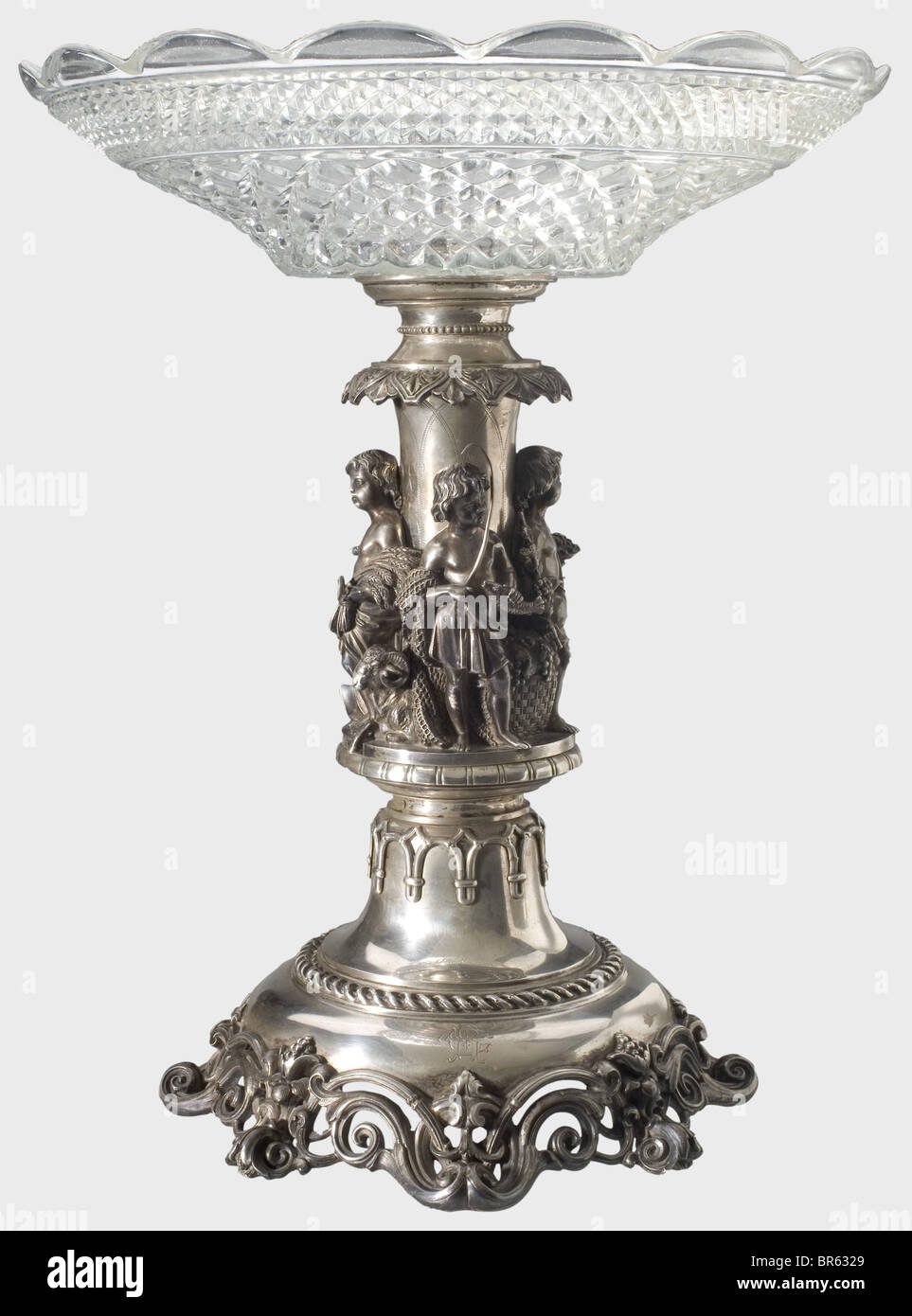 A tazza centrepiece, ca. 1870. Silver foot (no hallmarks). The stem with four three-dimensional genii symbolising fishing, viticulture, hunting and crop/livestock farming. The foot with engraved cipher 'CR'. Height of the stem 36 cm, weight ca. 1750 g. Glass bowl supplemented by moulded glass, diameter 35 cm. fine arts, people, 19th century, handicrafts, handcraft, craft, object, objects, stills, clipping, clippings, cut out, cut-out, cut-outs, vessel, vessels, Artist's Copyright has not to be cleared Stock Photohttps://www.alamy.com/image-license-details/?v=1https://www.alamy.com/stock-photo-a-tazza-centrepiece-ca-1870-silver-foot-no-hallmarks-the-stem-with-31481585.html
A tazza centrepiece, ca. 1870. Silver foot (no hallmarks). The stem with four three-dimensional genii symbolising fishing, viticulture, hunting and crop/livestock farming. The foot with engraved cipher 'CR'. Height of the stem 36 cm, weight ca. 1750 g. Glass bowl supplemented by moulded glass, diameter 35 cm. fine arts, people, 19th century, handicrafts, handcraft, craft, object, objects, stills, clipping, clippings, cut out, cut-out, cut-outs, vessel, vessels, Artist's Copyright has not to be cleared Stock Photohttps://www.alamy.com/image-license-details/?v=1https://www.alamy.com/stock-photo-a-tazza-centrepiece-ca-1870-silver-foot-no-hallmarks-the-stem-with-31481585.htmlRMBR6329–A tazza centrepiece, ca. 1870. Silver foot (no hallmarks). The stem with four three-dimensional genii symbolising fishing, viticulture, hunting and crop/livestock farming. The foot with engraved cipher 'CR'. Height of the stem 36 cm, weight ca. 1750 g. Glass bowl supplemented by moulded glass, diameter 35 cm. fine arts, people, 19th century, handicrafts, handcraft, craft, object, objects, stills, clipping, clippings, cut out, cut-out, cut-outs, vessel, vessels, Artist's Copyright has not to be cleared
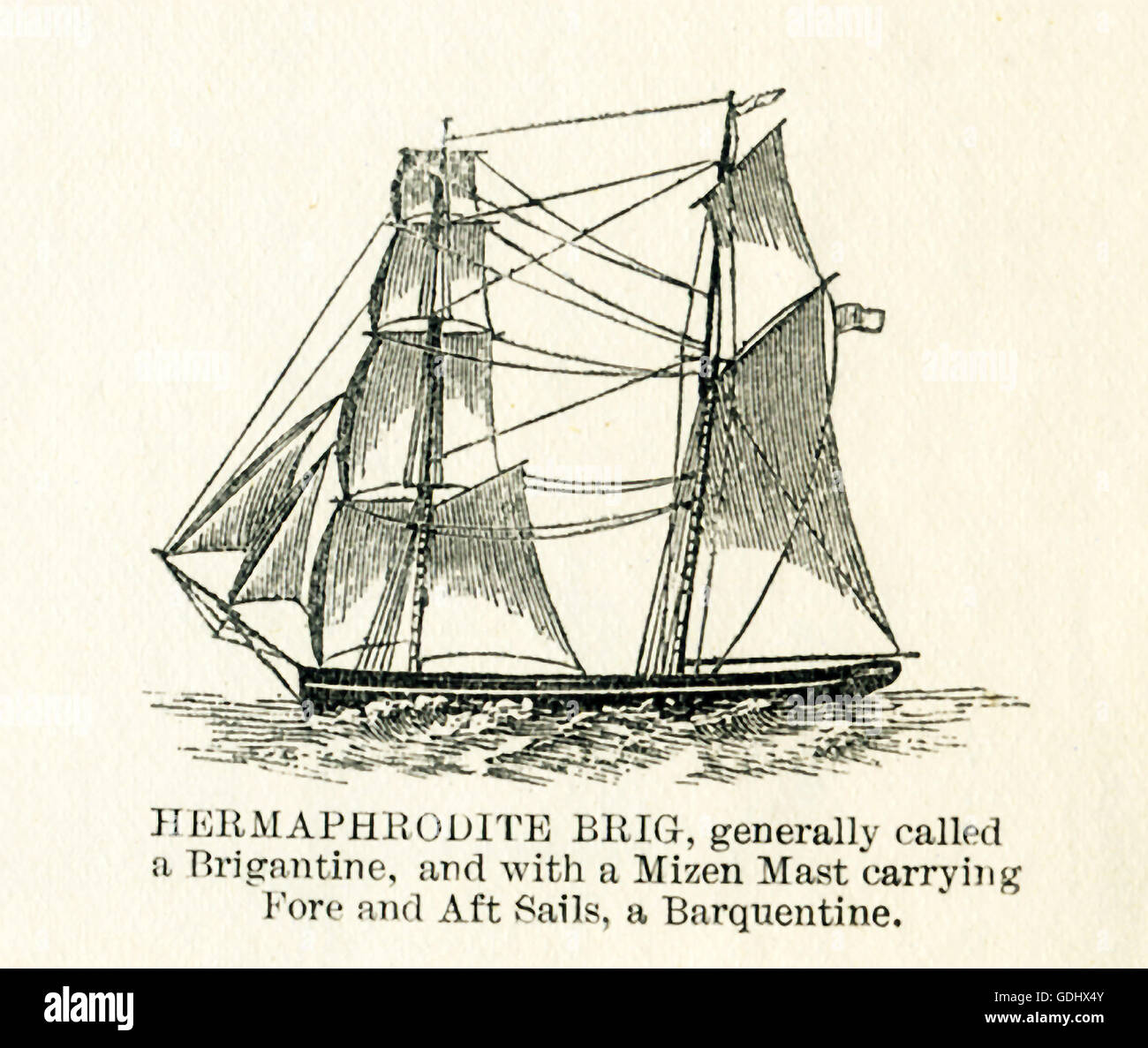 The vessel pictured in this 19th-century drawing is a hermaphrodite brig. Stock Photohttps://www.alamy.com/image-license-details/?v=1https://www.alamy.com/stock-photo-the-vessel-pictured-in-this-19th-century-drawing-is-a-hermaphrodite-111646443.html
The vessel pictured in this 19th-century drawing is a hermaphrodite brig. Stock Photohttps://www.alamy.com/image-license-details/?v=1https://www.alamy.com/stock-photo-the-vessel-pictured-in-this-19th-century-drawing-is-a-hermaphrodite-111646443.htmlRFGDHX4Y–The vessel pictured in this 19th-century drawing is a hermaphrodite brig.
 Vintage photo of old junks. Illustrations of Qing China, 1875 Interesting craft are the old weather-beaten junks which lie at anchor in the Canton river, waiting till the monsoon is favourable, to proceed upon their voyages. The usual destination of such junks is one of the ports on the China coast, or at furthest, Siam, Java, Borneo, or the Straits of Malacca. At their moorings, as represented in photo, these huge, clumsy vessels seem like mid-stream dwelling-places, fastened down by solid foundations to the river's bed, but when full rigged for sea, they look well, and even at times make goo Stock Photohttps://www.alamy.com/image-license-details/?v=1https://www.alamy.com/vintage-photo-of-old-junks-illustrations-of-qing-china-1875-interesting-craft-are-the-old-weather-beaten-junks-which-lie-at-anchor-in-the-canton-river-waiting-till-the-monsoon-is-favourable-to-proceed-upon-their-voyages-the-usual-destination-of-such-junks-is-one-of-the-ports-on-the-china-coast-or-at-furthest-siam-java-borneo-or-the-straits-of-malacca-at-their-moorings-as-represented-in-photo-these-huge-clumsy-vessels-seem-like-mid-stream-dwelling-places-fastened-down-by-solid-foundations-to-the-rivers-bed-but-when-full-rigged-for-sea-they-look-well-and-even-at-times-make-goo-image618361895.html
Vintage photo of old junks. Illustrations of Qing China, 1875 Interesting craft are the old weather-beaten junks which lie at anchor in the Canton river, waiting till the monsoon is favourable, to proceed upon their voyages. The usual destination of such junks is one of the ports on the China coast, or at furthest, Siam, Java, Borneo, or the Straits of Malacca. At their moorings, as represented in photo, these huge, clumsy vessels seem like mid-stream dwelling-places, fastened down by solid foundations to the river's bed, but when full rigged for sea, they look well, and even at times make goo Stock Photohttps://www.alamy.com/image-license-details/?v=1https://www.alamy.com/vintage-photo-of-old-junks-illustrations-of-qing-china-1875-interesting-craft-are-the-old-weather-beaten-junks-which-lie-at-anchor-in-the-canton-river-waiting-till-the-monsoon-is-favourable-to-proceed-upon-their-voyages-the-usual-destination-of-such-junks-is-one-of-the-ports-on-the-china-coast-or-at-furthest-siam-java-borneo-or-the-straits-of-malacca-at-their-moorings-as-represented-in-photo-these-huge-clumsy-vessels-seem-like-mid-stream-dwelling-places-fastened-down-by-solid-foundations-to-the-rivers-bed-but-when-full-rigged-for-sea-they-look-well-and-even-at-times-make-goo-image618361895.htmlRM2XX0PWB–Vintage photo of old junks. Illustrations of Qing China, 1875 Interesting craft are the old weather-beaten junks which lie at anchor in the Canton river, waiting till the monsoon is favourable, to proceed upon their voyages. The usual destination of such junks is one of the ports on the China coast, or at furthest, Siam, Java, Borneo, or the Straits of Malacca. At their moorings, as represented in photo, these huge, clumsy vessels seem like mid-stream dwelling-places, fastened down by solid foundations to the river's bed, but when full rigged for sea, they look well, and even at times make goo
![[ 1880s Japan - Mount Fuji ] — A view of Numakawa River and Mount Fuji as seen from Tagonoura in Shizuoka Prefecture. Tagonourabashi Bridge, built in 1873, as well as several sailing vessels can be seen. A rickshaw with customer is crossing the bridge. Since the stone gate to block the back flow is missing in the inner part of the harbor, this photograph must have been taken before 1886. 19th century vintage albumen photograph. Stock Photo [ 1880s Japan - Mount Fuji ] — A view of Numakawa River and Mount Fuji as seen from Tagonoura in Shizuoka Prefecture. Tagonourabashi Bridge, built in 1873, as well as several sailing vessels can be seen. A rickshaw with customer is crossing the bridge. Since the stone gate to block the back flow is missing in the inner part of the harbor, this photograph must have been taken before 1886. 19th century vintage albumen photograph. Stock Photo](https://c8.alamy.com/comp/W13M36/1880s-japan-mount-fuji-a-view-of-numakawa-river-and-mount-fuji-as-seen-from-tagonoura-in-shizuoka-prefecture-tagonourabashi-bridge-built-in-1873-as-well-as-several-sailing-vessels-can-be-seen-a-rickshaw-with-customer-is-crossing-the-bridge-since-the-stone-gate-to-block-the-back-flow-is-missing-in-the-inner-part-of-the-harbor-this-photograph-must-have-been-taken-before-1886-19th-century-vintage-albumen-photograph-W13M36.jpg) [ 1880s Japan - Mount Fuji ] — A view of Numakawa River and Mount Fuji as seen from Tagonoura in Shizuoka Prefecture. Tagonourabashi Bridge, built in 1873, as well as several sailing vessels can be seen. A rickshaw with customer is crossing the bridge. Since the stone gate to block the back flow is missing in the inner part of the harbor, this photograph must have been taken before 1886. 19th century vintage albumen photograph. Stock Photohttps://www.alamy.com/image-license-details/?v=1https://www.alamy.com/1880s-japan-mount-fuji-a-view-of-numakawa-river-and-mount-fuji-as-seen-from-tagonoura-in-shizuoka-prefecture-tagonourabashi-bridge-built-in-1873-as-well-as-several-sailing-vessels-can-be-seen-a-rickshaw-with-customer-is-crossing-the-bridge-since-the-stone-gate-to-block-the-back-flow-is-missing-in-the-inner-part-of-the-harbor-this-photograph-must-have-been-taken-before-1886-19th-century-vintage-albumen-photograph-image258851802.html
[ 1880s Japan - Mount Fuji ] — A view of Numakawa River and Mount Fuji as seen from Tagonoura in Shizuoka Prefecture. Tagonourabashi Bridge, built in 1873, as well as several sailing vessels can be seen. A rickshaw with customer is crossing the bridge. Since the stone gate to block the back flow is missing in the inner part of the harbor, this photograph must have been taken before 1886. 19th century vintage albumen photograph. Stock Photohttps://www.alamy.com/image-license-details/?v=1https://www.alamy.com/1880s-japan-mount-fuji-a-view-of-numakawa-river-and-mount-fuji-as-seen-from-tagonoura-in-shizuoka-prefecture-tagonourabashi-bridge-built-in-1873-as-well-as-several-sailing-vessels-can-be-seen-a-rickshaw-with-customer-is-crossing-the-bridge-since-the-stone-gate-to-block-the-back-flow-is-missing-in-the-inner-part-of-the-harbor-this-photograph-must-have-been-taken-before-1886-19th-century-vintage-albumen-photograph-image258851802.htmlRMW13M36–[ 1880s Japan - Mount Fuji ] — A view of Numakawa River and Mount Fuji as seen from Tagonoura in Shizuoka Prefecture. Tagonourabashi Bridge, built in 1873, as well as several sailing vessels can be seen. A rickshaw with customer is crossing the bridge. Since the stone gate to block the back flow is missing in the inner part of the harbor, this photograph must have been taken before 1886. 19th century vintage albumen photograph.
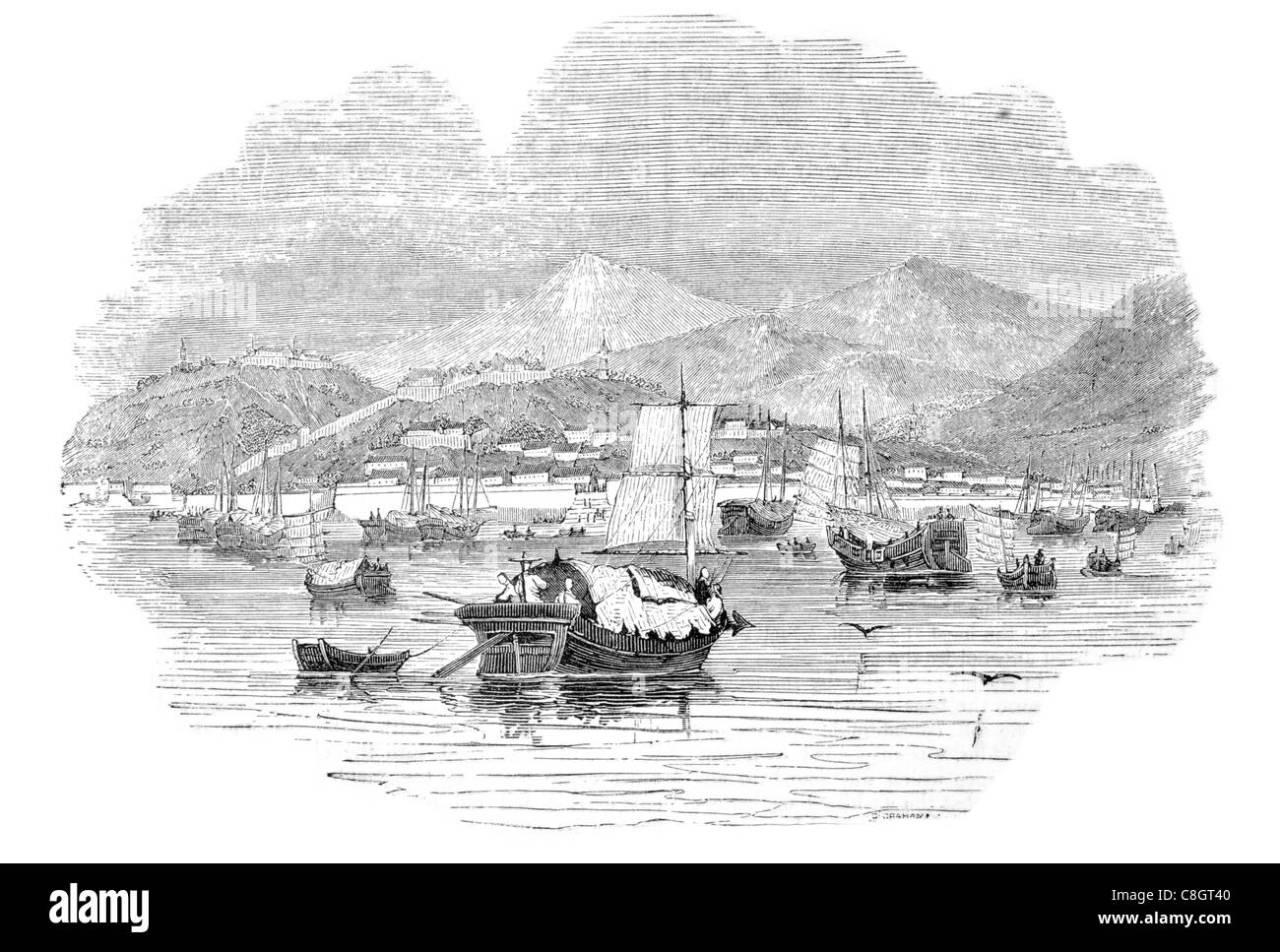 various Chinese vessels at the port of Shang hae shanghai fishing sailor fisherman sail sailing sailor ship ships shipping Stock Photohttps://www.alamy.com/image-license-details/?v=1https://www.alamy.com/stock-photo-various-chinese-vessels-at-the-port-of-shang-hae-shanghai-fishing-39708144.html
various Chinese vessels at the port of Shang hae shanghai fishing sailor fisherman sail sailing sailor ship ships shipping Stock Photohttps://www.alamy.com/image-license-details/?v=1https://www.alamy.com/stock-photo-various-chinese-vessels-at-the-port-of-shang-hae-shanghai-fishing-39708144.htmlRMC8GT40–various Chinese vessels at the port of Shang hae shanghai fishing sailor fisherman sail sailing sailor ship ships shipping
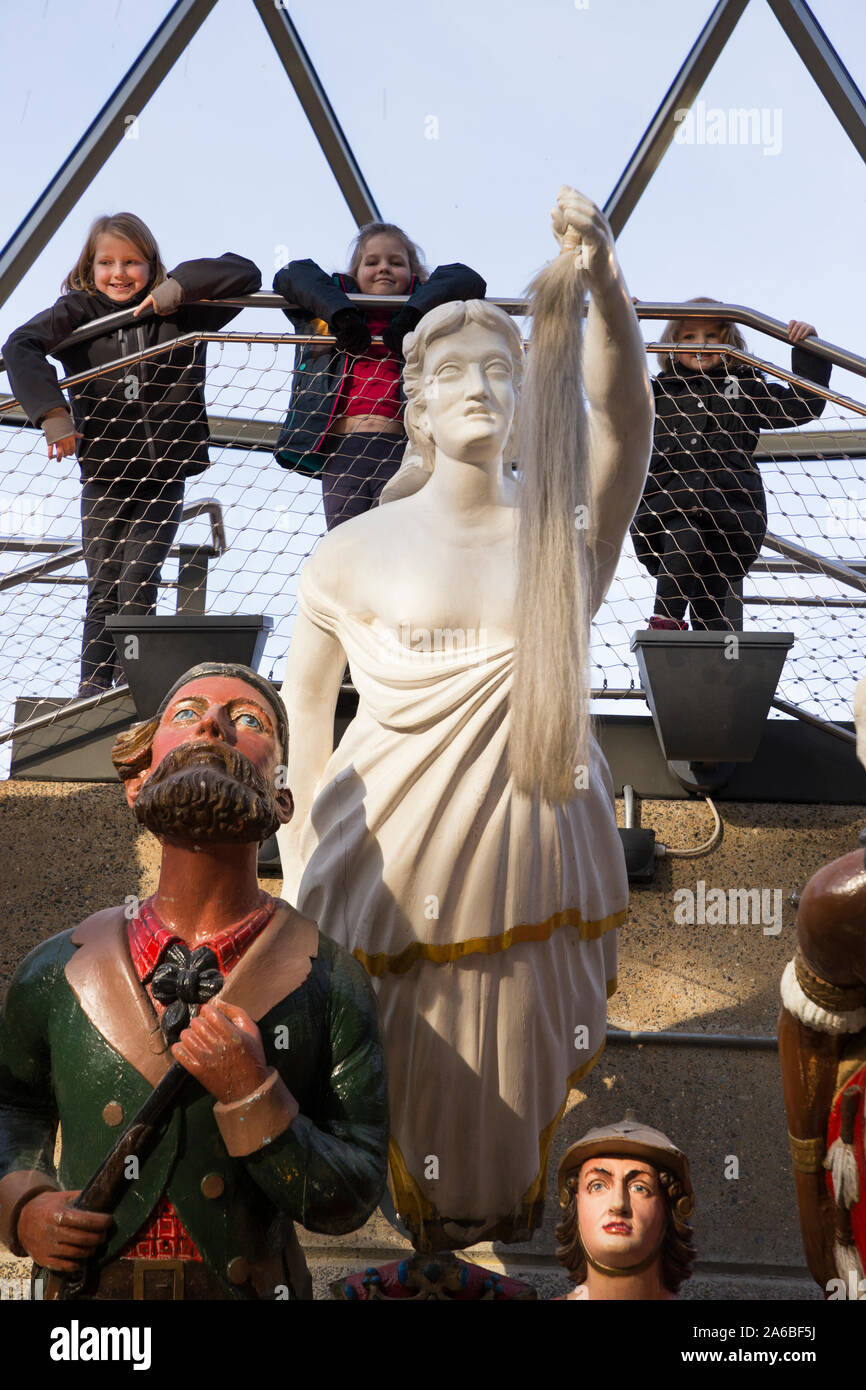 The figurehead of Cutty Sark (' Nanny' the witch with the tail of the horse) is central to The Long John Silver collection of – mainly – 19th-century ships' figureheads / ship figure heads which was gifted to Cutty Sark by the collector Sydney Cumbers, who dedicated it to the merchant Navy. Greenwich, London. UK (105) Stock Photohttps://www.alamy.com/image-license-details/?v=1https://www.alamy.com/the-figurehead-of-cutty-sark-nanny-the-witch-with-the-tail-of-the-horse-is-central-to-the-long-john-silver-collection-of-mainly-19th-century-ships-figureheads-ship-figure-heads-which-was-gifted-to-cutty-sark-by-the-collector-sydney-cumbers-who-dedicated-it-to-the-merchant-navy-greenwich-london-uk-105-image330938318.html
The figurehead of Cutty Sark (' Nanny' the witch with the tail of the horse) is central to The Long John Silver collection of – mainly – 19th-century ships' figureheads / ship figure heads which was gifted to Cutty Sark by the collector Sydney Cumbers, who dedicated it to the merchant Navy. Greenwich, London. UK (105) Stock Photohttps://www.alamy.com/image-license-details/?v=1https://www.alamy.com/the-figurehead-of-cutty-sark-nanny-the-witch-with-the-tail-of-the-horse-is-central-to-the-long-john-silver-collection-of-mainly-19th-century-ships-figureheads-ship-figure-heads-which-was-gifted-to-cutty-sark-by-the-collector-sydney-cumbers-who-dedicated-it-to-the-merchant-navy-greenwich-london-uk-105-image330938318.htmlRM2A6BF5J–The figurehead of Cutty Sark (' Nanny' the witch with the tail of the horse) is central to The Long John Silver collection of – mainly – 19th-century ships' figureheads / ship figure heads which was gifted to Cutty Sark by the collector Sydney Cumbers, who dedicated it to the merchant Navy. Greenwich, London. UK (105)
 Vintage advertisement for Bradley's superphosphate of lime. The standard commercial fertilizer. Stock Photohttps://www.alamy.com/image-license-details/?v=1https://www.alamy.com/vintage-advertisement-for-bradleys-superphosphate-of-lime-the-standard-commercial-fertilizer-image552925847.html
Vintage advertisement for Bradley's superphosphate of lime. The standard commercial fertilizer. Stock Photohttps://www.alamy.com/image-license-details/?v=1https://www.alamy.com/vintage-advertisement-for-bradleys-superphosphate-of-lime-the-standard-commercial-fertilizer-image552925847.htmlRM2R3FXFK–Vintage advertisement for Bradley's superphosphate of lime. The standard commercial fertilizer.
 YORKS Launch ships from, Samuelson's Yd 1863. Illustrated London News Stock Photohttps://www.alamy.com/image-license-details/?v=1https://www.alamy.com/stock-photo-yorks-launch-ships-from-samuelsons-yd-1863-illustrated-london-news-95371238.html
YORKS Launch ships from, Samuelson's Yd 1863. Illustrated London News Stock Photohttps://www.alamy.com/image-license-details/?v=1https://www.alamy.com/stock-photo-yorks-launch-ships-from-samuelsons-yd-1863-illustrated-london-news-95371238.htmlRFFF4EYJ–YORKS Launch ships from, Samuelson's Yd 1863. Illustrated London News
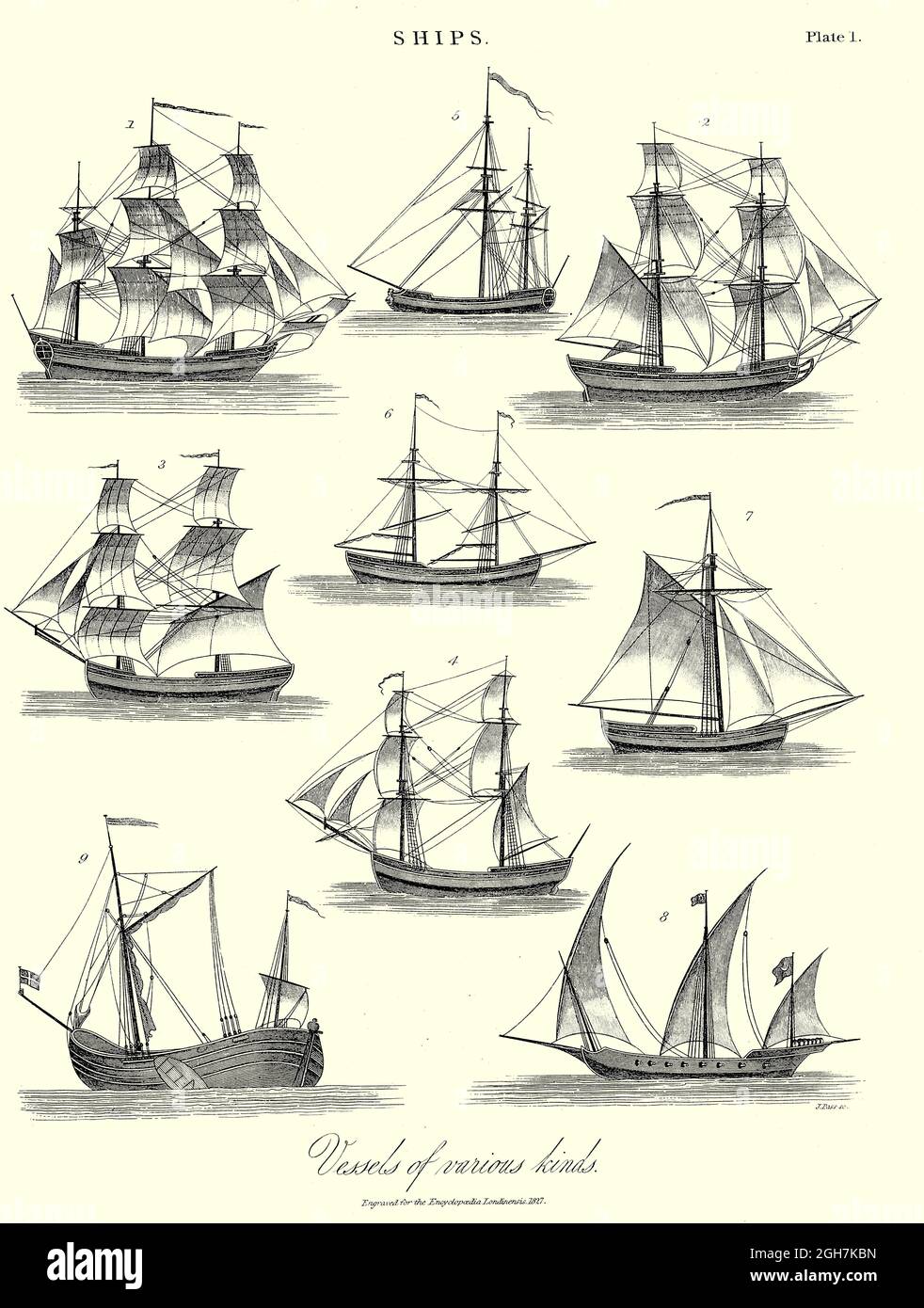 Ships Vessels of various kind Copperplate engraving From the Encyclopaedia Londinensis or, Universal dictionary of arts, sciences, and literature; Volume XXIII; Edited by Wilkes, John. Published in London in 1828 Stock Photohttps://www.alamy.com/image-license-details/?v=1https://www.alamy.com/ships-vessels-of-various-kind-copperplate-engraving-from-the-encyclopaedia-londinensis-or-universal-dictionary-of-arts-sciences-and-literature-volume-xxiii-edited-by-wilkes-john-published-in-london-in-1828-image440877241.html
Ships Vessels of various kind Copperplate engraving From the Encyclopaedia Londinensis or, Universal dictionary of arts, sciences, and literature; Volume XXIII; Edited by Wilkes, John. Published in London in 1828 Stock Photohttps://www.alamy.com/image-license-details/?v=1https://www.alamy.com/ships-vessels-of-various-kind-copperplate-engraving-from-the-encyclopaedia-londinensis-or-universal-dictionary-of-arts-sciences-and-literature-volume-xxiii-edited-by-wilkes-john-published-in-london-in-1828-image440877241.htmlRF2GH7KBN–Ships Vessels of various kind Copperplate engraving From the Encyclopaedia Londinensis or, Universal dictionary of arts, sciences, and literature; Volume XXIII; Edited by Wilkes, John. Published in London in 1828
 Valparaíso, Chile. Panoramic view of the port and the city, from the unloading pier. Engraving by Capuz. La Ilustración Española y Americana (The Spanish and American Illustration), March 15, 1884. Stock Photohttps://www.alamy.com/image-license-details/?v=1https://www.alamy.com/valparaso-chile-panoramic-view-of-the-port-and-the-city-from-the-unloading-pier-engraving-by-capuz-la-ilustracin-espaola-y-americana-the-spanish-and-american-illustration-march-15-1884-image622192283.html
Valparaíso, Chile. Panoramic view of the port and the city, from the unloading pier. Engraving by Capuz. La Ilustración Española y Americana (The Spanish and American Illustration), March 15, 1884. Stock Photohttps://www.alamy.com/image-license-details/?v=1https://www.alamy.com/valparaso-chile-panoramic-view-of-the-port-and-the-city-from-the-unloading-pier-engraving-by-capuz-la-ilustracin-espaola-y-americana-the-spanish-and-american-illustration-march-15-1884-image622192283.htmlRM2Y478GY–Valparaíso, Chile. Panoramic view of the port and the city, from the unloading pier. Engraving by Capuz. La Ilustración Española y Americana (The Spanish and American Illustration), March 15, 1884.
 Illustration depicting a hydraulic slipway at Constadt for lifting vessels out of the water for repair. Dated 19th Century Stock Photohttps://www.alamy.com/image-license-details/?v=1https://www.alamy.com/stock-photo-illustration-depicting-a-hydraulic-slipway-at-constadt-for-lifting-131239721.html
Illustration depicting a hydraulic slipway at Constadt for lifting vessels out of the water for repair. Dated 19th Century Stock Photohttps://www.alamy.com/image-license-details/?v=1https://www.alamy.com/stock-photo-illustration-depicting-a-hydraulic-slipway-at-constadt-for-lifting-131239721.htmlRMHHEDGW–Illustration depicting a hydraulic slipway at Constadt for lifting vessels out of the water for repair. Dated 19th Century
 Historic drawing, nightly boat trip on the River Thames, Waterloo Bridge, London, 19th Century, London, England, United Kingdom, Stock Photohttps://www.alamy.com/image-license-details/?v=1https://www.alamy.com/stock-photo-historic-drawing-nightly-boat-trip-on-the-river-thames-waterloo-bridge-55967714.html
Historic drawing, nightly boat trip on the River Thames, Waterloo Bridge, London, 19th Century, London, England, United Kingdom, Stock Photohttps://www.alamy.com/image-license-details/?v=1https://www.alamy.com/stock-photo-historic-drawing-nightly-boat-trip-on-the-river-thames-waterloo-bridge-55967714.htmlRMD71FAX–Historic drawing, nightly boat trip on the River Thames, Waterloo Bridge, London, 19th Century, London, England, United Kingdom,
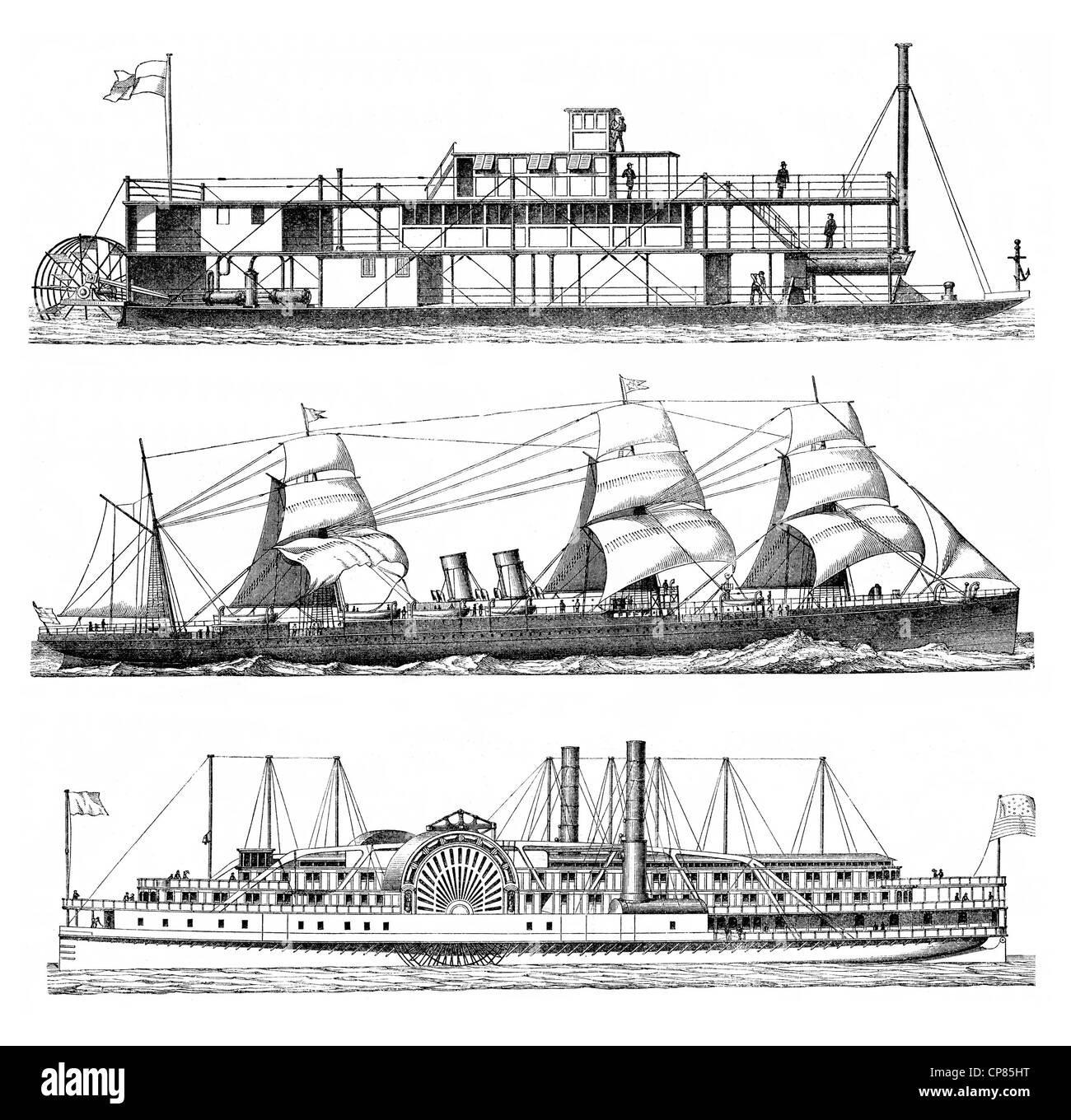 vessels powered by steam engines, steam vessels or steamers, 19th Century, Historische, zeichnerische Darstellung, Mit Dampfmasc Stock Photohttps://www.alamy.com/image-license-details/?v=1https://www.alamy.com/stock-photo-vessels-powered-by-steam-engines-steam-vessels-or-steamers-19th-century-48123204.html
vessels powered by steam engines, steam vessels or steamers, 19th Century, Historische, zeichnerische Darstellung, Mit Dampfmasc Stock Photohttps://www.alamy.com/image-license-details/?v=1https://www.alamy.com/stock-photo-vessels-powered-by-steam-engines-steam-vessels-or-steamers-19th-century-48123204.htmlRMCP85HT–vessels powered by steam engines, steam vessels or steamers, 19th Century, Historische, zeichnerische Darstellung, Mit Dampfmasc
 Ships Vessels of various kind Copperplate engraving From the Encyclopaedia Londinensis or, Universal dictionary of arts, sciences, and literature; Volume XXIII; Edited by Wilkes, John. Published in London in 1828 Stock Photohttps://www.alamy.com/image-license-details/?v=1https://www.alamy.com/ships-vessels-of-various-kind-copperplate-engraving-from-the-encyclopaedia-londinensis-or-universal-dictionary-of-arts-sciences-and-literature-volume-xxiii-edited-by-wilkes-john-published-in-london-in-1828-image401786078.html
Ships Vessels of various kind Copperplate engraving From the Encyclopaedia Londinensis or, Universal dictionary of arts, sciences, and literature; Volume XXIII; Edited by Wilkes, John. Published in London in 1828 Stock Photohttps://www.alamy.com/image-license-details/?v=1https://www.alamy.com/ships-vessels-of-various-kind-copperplate-engraving-from-the-encyclopaedia-londinensis-or-universal-dictionary-of-arts-sciences-and-literature-volume-xxiii-edited-by-wilkes-john-published-in-london-in-1828-image401786078.htmlRF2E9JX6P–Ships Vessels of various kind Copperplate engraving From the Encyclopaedia Londinensis or, Universal dictionary of arts, sciences, and literature; Volume XXIII; Edited by Wilkes, John. Published in London in 1828
 Ship hull on dry dock. Modern period. 15th century. Europe. Engraving, 19th century. Stock Photohttps://www.alamy.com/image-license-details/?v=1https://www.alamy.com/ship-hull-on-dry-dock-modern-period-15th-century-europe-engraving-19th-century-image613322461.html
Ship hull on dry dock. Modern period. 15th century. Europe. Engraving, 19th century. Stock Photohttps://www.alamy.com/image-license-details/?v=1https://www.alamy.com/ship-hull-on-dry-dock-modern-period-15th-century-europe-engraving-19th-century-image613322461.htmlRM2XHR71H–Ship hull on dry dock. Modern period. 15th century. Europe. Engraving, 19th century.
 Portsmouth, Hampshire, HMS Warrior vintage battle ship ships England UK English nineteenth century Victorian vessel vessels Stock Photohttps://www.alamy.com/image-license-details/?v=1https://www.alamy.com/stock-photo-portsmouth-hampshire-hms-warrior-vintage-battle-ship-ships-england-41497491.html
Portsmouth, Hampshire, HMS Warrior vintage battle ship ships England UK English nineteenth century Victorian vessel vessels Stock Photohttps://www.alamy.com/image-license-details/?v=1https://www.alamy.com/stock-photo-portsmouth-hampshire-hms-warrior-vintage-battle-ship-ships-england-41497491.htmlRMCBEAD7–Portsmouth, Hampshire, HMS Warrior vintage battle ship ships England UK English nineteenth century Victorian vessel vessels
 A late 19th Century chart illustrating various naval vessels from Greek Triremes from 500BCE onwards to Ironclad ships of the late 19th Century. Stock Photohttps://www.alamy.com/image-license-details/?v=1https://www.alamy.com/a-late-19th-century-chart-illustrating-various-naval-vessels-from-greek-triremes-from-500bce-onwards-to-ironclad-ships-of-the-late-19th-century-image379738509.html
A late 19th Century chart illustrating various naval vessels from Greek Triremes from 500BCE onwards to Ironclad ships of the late 19th Century. Stock Photohttps://www.alamy.com/image-license-details/?v=1https://www.alamy.com/a-late-19th-century-chart-illustrating-various-naval-vessels-from-greek-triremes-from-500bce-onwards-to-ironclad-ships-of-the-late-19th-century-image379738509.htmlRM2D1PG9H–A late 19th Century chart illustrating various naval vessels from Greek Triremes from 500BCE onwards to Ironclad ships of the late 19th Century.
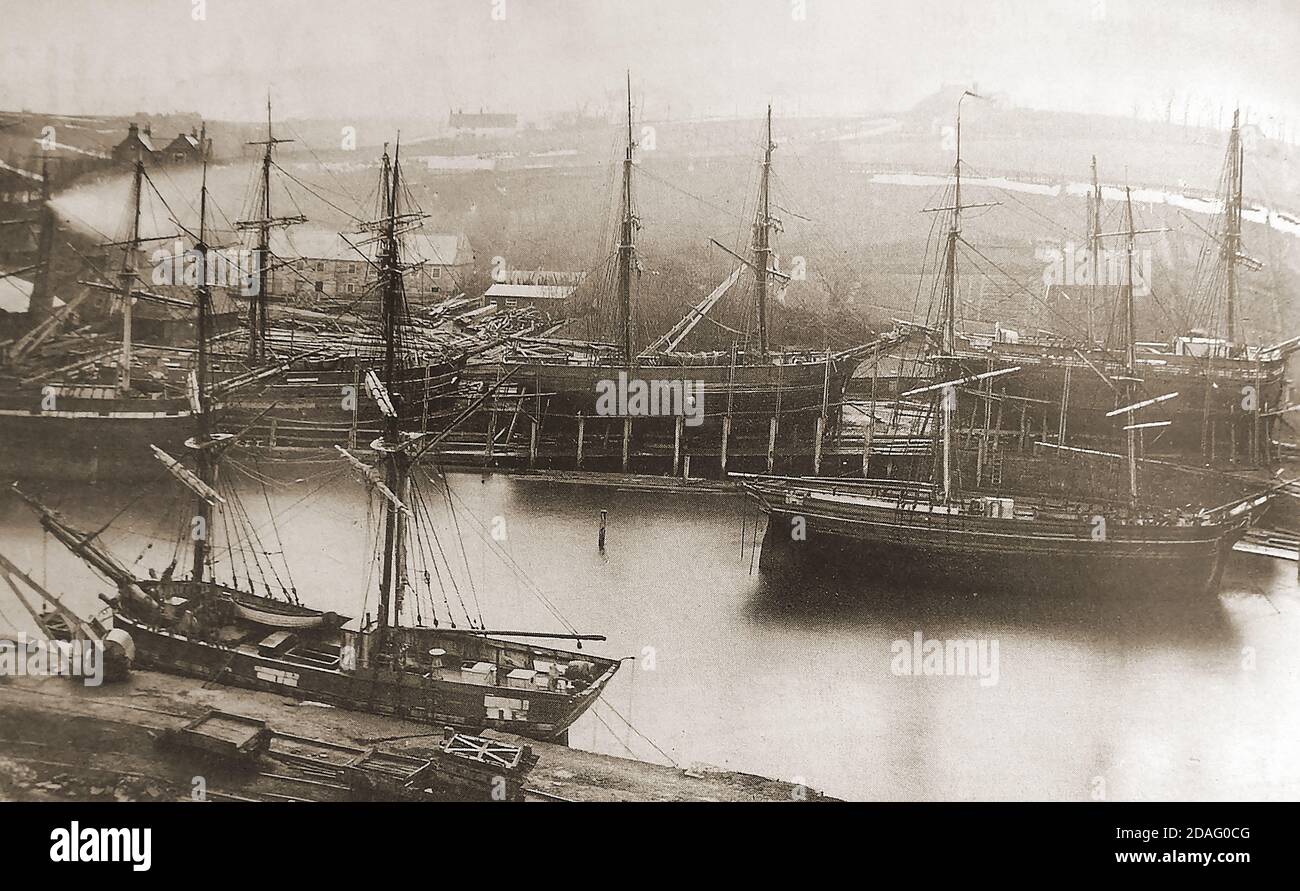 A rare & unusual old photograph showing sailing ships being built or repaired at the Whitehall shipyard on the river Esk at , Whitby, North Yorkshire (UK) during the Victorian period. White Hall, or Whitehall (still standing in 2020) was the home of the shipyard owner, Thomas Turbull. The two gable ends of the building (top left) can be seen in the picture. A collier (coal ship) selling coal to the public is moored on the other side of the river close to where the Co-op store carpark and marina are situated today (2020) Stock Photohttps://www.alamy.com/image-license-details/?v=1https://www.alamy.com/a-rare-unusual-old-photograph-showing-sailing-ships-being-built-or-repaired-at-the-whitehall-shipyard-on-the-river-esk-at-whitby-north-yorkshire-uk-during-the-victorian-period-white-hall-or-whitehall-still-standing-in-2020-was-the-home-of-the-shipyard-owner-thomas-turbull-the-two-gable-ends-of-the-building-top-left-can-be-seen-in-the-picture-a-collier-coal-ship-selling-coal-to-the-public-is-moored-on-the-other-side-of-the-river-close-to-where-the-co-op-store-carpark-and-marina-are-situated-today-2020-image385126240.html
A rare & unusual old photograph showing sailing ships being built or repaired at the Whitehall shipyard on the river Esk at , Whitby, North Yorkshire (UK) during the Victorian period. White Hall, or Whitehall (still standing in 2020) was the home of the shipyard owner, Thomas Turbull. The two gable ends of the building (top left) can be seen in the picture. A collier (coal ship) selling coal to the public is moored on the other side of the river close to where the Co-op store carpark and marina are situated today (2020) Stock Photohttps://www.alamy.com/image-license-details/?v=1https://www.alamy.com/a-rare-unusual-old-photograph-showing-sailing-ships-being-built-or-repaired-at-the-whitehall-shipyard-on-the-river-esk-at-whitby-north-yorkshire-uk-during-the-victorian-period-white-hall-or-whitehall-still-standing-in-2020-was-the-home-of-the-shipyard-owner-thomas-turbull-the-two-gable-ends-of-the-building-top-left-can-be-seen-in-the-picture-a-collier-coal-ship-selling-coal-to-the-public-is-moored-on-the-other-side-of-the-river-close-to-where-the-co-op-store-carpark-and-marina-are-situated-today-2020-image385126240.htmlRM2DAG0CG–A rare & unusual old photograph showing sailing ships being built or repaired at the Whitehall shipyard on the river Esk at , Whitby, North Yorkshire (UK) during the Victorian period. White Hall, or Whitehall (still standing in 2020) was the home of the shipyard owner, Thomas Turbull. The two gable ends of the building (top left) can be seen in the picture. A collier (coal ship) selling coal to the public is moored on the other side of the river close to where the Co-op store carpark and marina are situated today (2020)
 Battle of Navarino. 20 October 1827. Greek War of Independence (1821-32). Coast Peloponnese. Belligerents: Allied forces of British, French and Russian against Ottoman Empire. Allies' victory. Engraving. 19th century. Stock Photohttps://www.alamy.com/image-license-details/?v=1https://www.alamy.com/battle-of-navarino-20-october-1827-greek-war-of-independence-1821-32-coast-peloponnese-belligerents-allied-forces-of-british-french-and-russian-against-ottoman-empire-allies-victory-engraving-19th-century-image210645910.html
Battle of Navarino. 20 October 1827. Greek War of Independence (1821-32). Coast Peloponnese. Belligerents: Allied forces of British, French and Russian against Ottoman Empire. Allies' victory. Engraving. 19th century. Stock Photohttps://www.alamy.com/image-license-details/?v=1https://www.alamy.com/battle-of-navarino-20-october-1827-greek-war-of-independence-1821-32-coast-peloponnese-belligerents-allied-forces-of-british-french-and-russian-against-ottoman-empire-allies-victory-engraving-19th-century-image210645910.htmlRMP6KN06–Battle of Navarino. 20 October 1827. Greek War of Independence (1821-32). Coast Peloponnese. Belligerents: Allied forces of British, French and Russian against Ottoman Empire. Allies' victory. Engraving. 19th century.
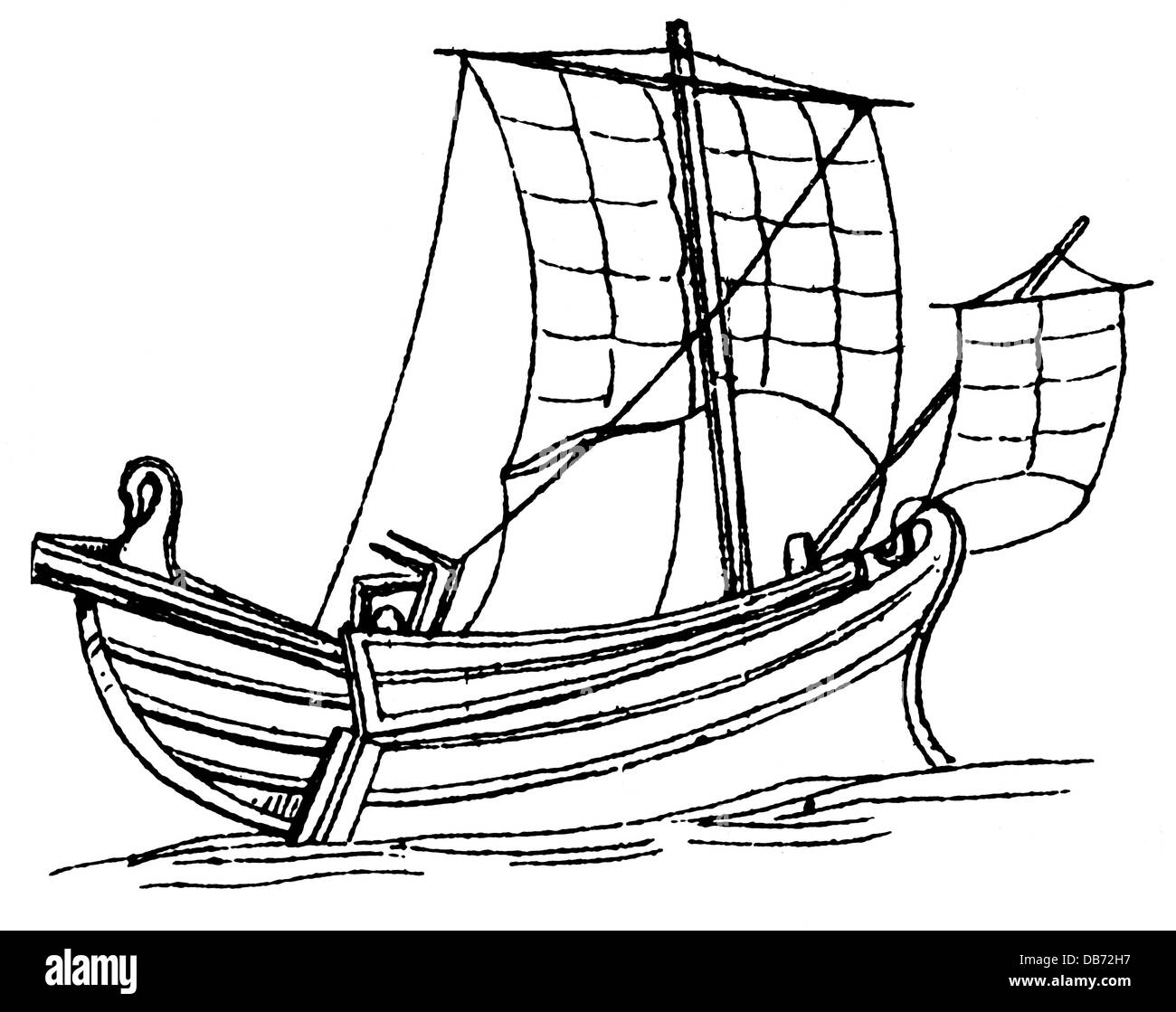 transport / transportation, navigation, sailing ships, merchant ship from Byblos, circa 1000 - 500 BC, wood engraving, 19th century, sailing ship, cargo vessel, trading vessel, cargo vessels, trading vessels, trade, Phoenicians, Phoenician, Phoenicia, sail, sails, square sail, ancient world, ancient times, historic, historical, ancient world, Additional-Rights-Clearences-Not Available Stock Photohttps://www.alamy.com/image-license-details/?v=1https://www.alamy.com/stock-photo-transport-transportation-navigation-sailing-ships-merchant-ship-from-58548035.html
transport / transportation, navigation, sailing ships, merchant ship from Byblos, circa 1000 - 500 BC, wood engraving, 19th century, sailing ship, cargo vessel, trading vessel, cargo vessels, trading vessels, trade, Phoenicians, Phoenician, Phoenicia, sail, sails, square sail, ancient world, ancient times, historic, historical, ancient world, Additional-Rights-Clearences-Not Available Stock Photohttps://www.alamy.com/image-license-details/?v=1https://www.alamy.com/stock-photo-transport-transportation-navigation-sailing-ships-merchant-ship-from-58548035.htmlRMDB72H7–transport / transportation, navigation, sailing ships, merchant ship from Byblos, circa 1000 - 500 BC, wood engraving, 19th century, sailing ship, cargo vessel, trading vessel, cargo vessels, trading vessels, trade, Phoenicians, Phoenician, Phoenicia, sail, sails, square sail, ancient world, ancient times, historic, historical, ancient world, Additional-Rights-Clearences-Not Available
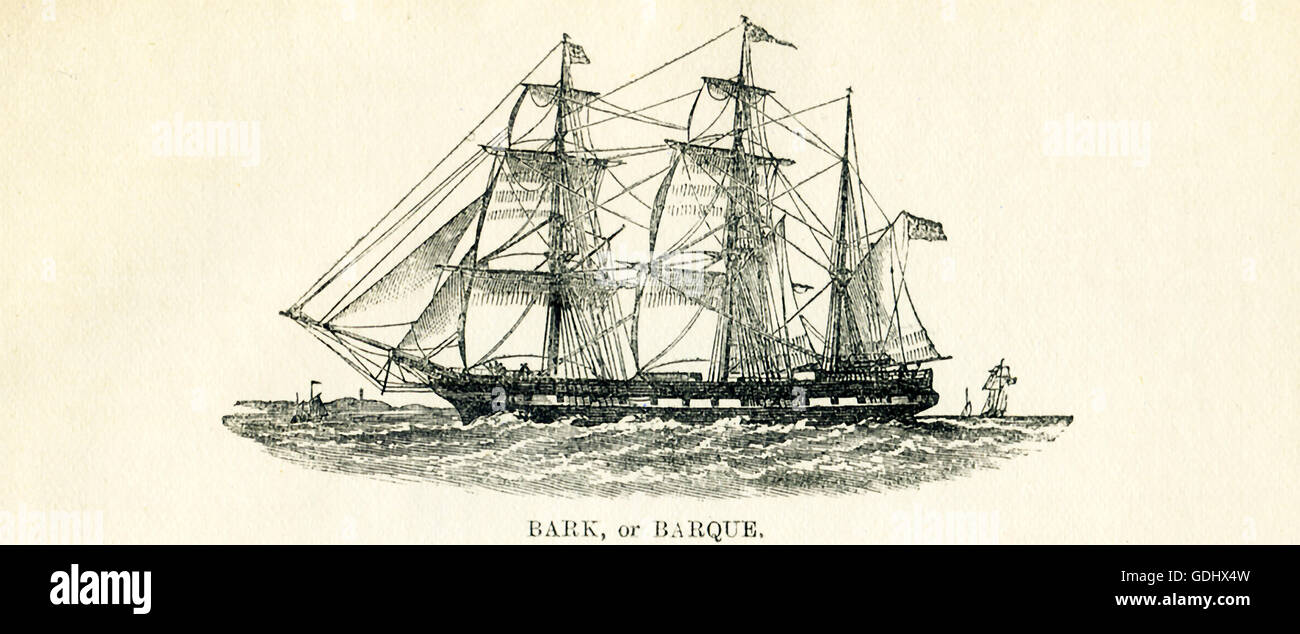 The vessel pictured in this 19th-century drawing is a bark (also spelled barque). Stock Photohttps://www.alamy.com/image-license-details/?v=1https://www.alamy.com/stock-photo-the-vessel-pictured-in-this-19th-century-drawing-is-a-bark-also-spelled-111646441.html
The vessel pictured in this 19th-century drawing is a bark (also spelled barque). Stock Photohttps://www.alamy.com/image-license-details/?v=1https://www.alamy.com/stock-photo-the-vessel-pictured-in-this-19th-century-drawing-is-a-bark-also-spelled-111646441.htmlRFGDHX4W–The vessel pictured in this 19th-century drawing is a bark (also spelled barque).
 China of the Qing period. Vintage illustration of the Chinese trading ship. 1805 These ships venture as far as Manilla, Japan, and even Batavia, which is the most distant port they visit; and many of them are from eight hundred to a thousand tons burthen. In these voyages the mariners take the moderate season of the year, and though well acquainted with the use of the compass, generally keep near the coast. The stern of this ship falls in with an angle; other vessels are formed with a cavity, in which the rudder is defended from the violence of the sea; yet this contrivance certainly subjects Stock Photohttps://www.alamy.com/image-license-details/?v=1https://www.alamy.com/china-of-the-qing-period-vintage-illustration-of-the-chinese-trading-ship-1805-these-ships-venture-as-far-as-manilla-japan-and-even-batavia-which-is-the-most-distant-port-they-visit-and-many-of-them-are-from-eight-hundred-to-a-thousand-tons-burthen-in-these-voyages-the-mariners-take-the-moderate-season-of-the-year-and-though-well-acquainted-with-the-use-of-the-compass-generally-keep-near-the-coast-the-stern-of-this-ship-falls-in-with-an-angle-other-vessels-are-formed-with-a-cavity-in-which-the-rudder-is-defended-from-the-violence-of-the-sea-yet-this-contrivance-certainly-subjects-image623198981.html
China of the Qing period. Vintage illustration of the Chinese trading ship. 1805 These ships venture as far as Manilla, Japan, and even Batavia, which is the most distant port they visit; and many of them are from eight hundred to a thousand tons burthen. In these voyages the mariners take the moderate season of the year, and though well acquainted with the use of the compass, generally keep near the coast. The stern of this ship falls in with an angle; other vessels are formed with a cavity, in which the rudder is defended from the violence of the sea; yet this contrivance certainly subjects Stock Photohttps://www.alamy.com/image-license-details/?v=1https://www.alamy.com/china-of-the-qing-period-vintage-illustration-of-the-chinese-trading-ship-1805-these-ships-venture-as-far-as-manilla-japan-and-even-batavia-which-is-the-most-distant-port-they-visit-and-many-of-them-are-from-eight-hundred-to-a-thousand-tons-burthen-in-these-voyages-the-mariners-take-the-moderate-season-of-the-year-and-though-well-acquainted-with-the-use-of-the-compass-generally-keep-near-the-coast-the-stern-of-this-ship-falls-in-with-an-angle-other-vessels-are-formed-with-a-cavity-in-which-the-rudder-is-defended-from-the-violence-of-the-sea-yet-this-contrivance-certainly-subjects-image623198981.htmlRM2Y5W4JD–China of the Qing period. Vintage illustration of the Chinese trading ship. 1805 These ships venture as far as Manilla, Japan, and even Batavia, which is the most distant port they visit; and many of them are from eight hundred to a thousand tons burthen. In these voyages the mariners take the moderate season of the year, and though well acquainted with the use of the compass, generally keep near the coast. The stern of this ship falls in with an angle; other vessels are formed with a cavity, in which the rudder is defended from the violence of the sea; yet this contrivance certainly subjects
![[ 1850s Japan - Cherry Blossom and Boats ] — Cherry blossom and sailing vessels on the Sumidagawa River in Edo (current Tokyo), 1856 (Ansei 3). In the back, Mount Tsukuba can be seen. This woodblock print is image 35 in One Hundred Famous Views of Edo (名所江戸百景, Meisho Edo Hyakkei), a series created by ukiyoe artist Utagawa Hiroshige (歌川広重, 1797–1858). It is one of 42 spring scenes in the series. Title: Suijin Shrine and Massaki on the Sumida River (隅田川水神の森真崎, Sumidagawa Suijin no mori Massaki) 19th century vintage Ukiyoe woodblock print. Stock Photo [ 1850s Japan - Cherry Blossom and Boats ] — Cherry blossom and sailing vessels on the Sumidagawa River in Edo (current Tokyo), 1856 (Ansei 3). In the back, Mount Tsukuba can be seen. This woodblock print is image 35 in One Hundred Famous Views of Edo (名所江戸百景, Meisho Edo Hyakkei), a series created by ukiyoe artist Utagawa Hiroshige (歌川広重, 1797–1858). It is one of 42 spring scenes in the series. Title: Suijin Shrine and Massaki on the Sumida River (隅田川水神の森真崎, Sumidagawa Suijin no mori Massaki) 19th century vintage Ukiyoe woodblock print. Stock Photo](https://c8.alamy.com/comp/2BMFPJ3/1850s-japan-cherry-blossom-and-boats-cherry-blossom-and-sailing-vessels-on-the-sumidagawa-river-in-edo-current-tokyo-1856-ansei-3-in-the-back-mount-tsukuba-can-be-seen-this-woodblock-print-is-image-35-in-one-hundred-famous-views-of-edo-meisho-edo-hyakkei-a-series-created-by-ukiyoe-artist-utagawa-hiroshige-17971858-it-is-one-of-42-spring-scenes-in-the-series-title-suijin-shrine-and-massaki-on-the-sumida-river-sumidagawa-suijin-no-mori-massaki-19th-century-vintage-ukiyoe-woodblock-print-2BMFPJ3.jpg) [ 1850s Japan - Cherry Blossom and Boats ] — Cherry blossom and sailing vessels on the Sumidagawa River in Edo (current Tokyo), 1856 (Ansei 3). In the back, Mount Tsukuba can be seen. This woodblock print is image 35 in One Hundred Famous Views of Edo (名所江戸百景, Meisho Edo Hyakkei), a series created by ukiyoe artist Utagawa Hiroshige (歌川広重, 1797–1858). It is one of 42 spring scenes in the series. Title: Suijin Shrine and Massaki on the Sumida River (隅田川水神の森真崎, Sumidagawa Suijin no mori Massaki) 19th century vintage Ukiyoe woodblock print. Stock Photohttps://www.alamy.com/image-license-details/?v=1https://www.alamy.com/1850s-japan-cherry-blossom-and-boats-cherry-blossom-and-sailing-vessels-on-the-sumidagawa-river-in-edo-current-tokyo-1856-ansei-3-in-the-back-mount-tsukuba-can-be-seen-this-woodblock-print-is-image-35-in-one-hundred-famous-views-of-edo-meisho-edo-hyakkei-a-series-created-by-ukiyoe-artist-utagawa-hiroshige-17971858-it-is-one-of-42-spring-scenes-in-the-series-title-suijin-shrine-and-massaki-on-the-sumida-river-sumidagawa-suijin-no-mori-massaki-19th-century-vintage-ukiyoe-woodblock-print-image356847515.html
[ 1850s Japan - Cherry Blossom and Boats ] — Cherry blossom and sailing vessels on the Sumidagawa River in Edo (current Tokyo), 1856 (Ansei 3). In the back, Mount Tsukuba can be seen. This woodblock print is image 35 in One Hundred Famous Views of Edo (名所江戸百景, Meisho Edo Hyakkei), a series created by ukiyoe artist Utagawa Hiroshige (歌川広重, 1797–1858). It is one of 42 spring scenes in the series. Title: Suijin Shrine and Massaki on the Sumida River (隅田川水神の森真崎, Sumidagawa Suijin no mori Massaki) 19th century vintage Ukiyoe woodblock print. Stock Photohttps://www.alamy.com/image-license-details/?v=1https://www.alamy.com/1850s-japan-cherry-blossom-and-boats-cherry-blossom-and-sailing-vessels-on-the-sumidagawa-river-in-edo-current-tokyo-1856-ansei-3-in-the-back-mount-tsukuba-can-be-seen-this-woodblock-print-is-image-35-in-one-hundred-famous-views-of-edo-meisho-edo-hyakkei-a-series-created-by-ukiyoe-artist-utagawa-hiroshige-17971858-it-is-one-of-42-spring-scenes-in-the-series-title-suijin-shrine-and-massaki-on-the-sumida-river-sumidagawa-suijin-no-mori-massaki-19th-century-vintage-ukiyoe-woodblock-print-image356847515.htmlRM2BMFPJ3–[ 1850s Japan - Cherry Blossom and Boats ] — Cherry blossom and sailing vessels on the Sumidagawa River in Edo (current Tokyo), 1856 (Ansei 3). In the back, Mount Tsukuba can be seen. This woodblock print is image 35 in One Hundred Famous Views of Edo (名所江戸百景, Meisho Edo Hyakkei), a series created by ukiyoe artist Utagawa Hiroshige (歌川広重, 1797–1858). It is one of 42 spring scenes in the series. Title: Suijin Shrine and Massaki on the Sumida River (隅田川水神の森真崎, Sumidagawa Suijin no mori Massaki) 19th century vintage Ukiyoe woodblock print.
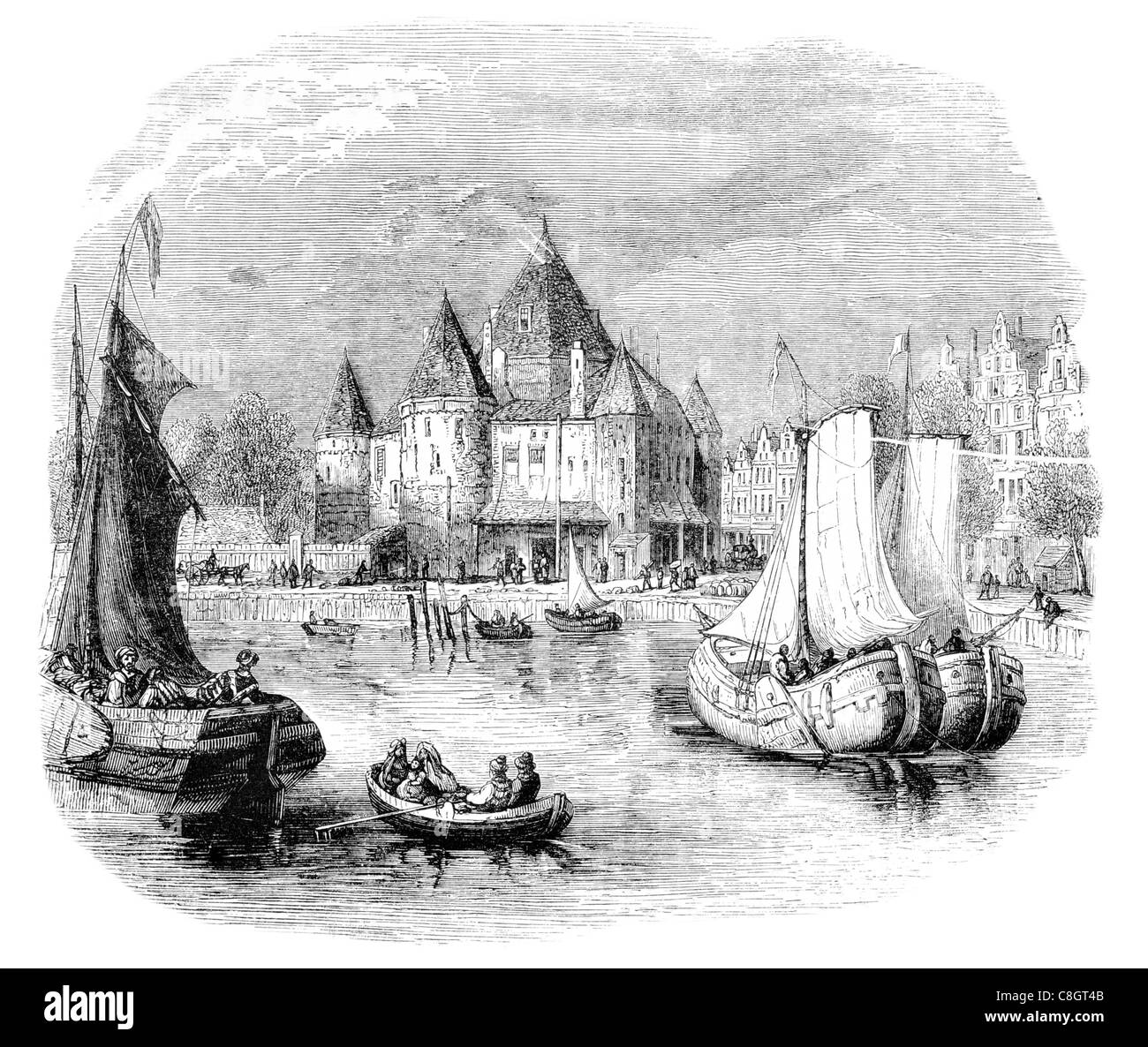 Dutch vessels Amsterdam fishing sailor fisherman sail sailing sailor ship ships shipping marine vessel cargo goods seas sea Stock Photohttps://www.alamy.com/image-license-details/?v=1https://www.alamy.com/stock-photo-dutch-vessels-amsterdam-fishing-sailor-fisherman-sail-sailing-sailor-39708155.html
Dutch vessels Amsterdam fishing sailor fisherman sail sailing sailor ship ships shipping marine vessel cargo goods seas sea Stock Photohttps://www.alamy.com/image-license-details/?v=1https://www.alamy.com/stock-photo-dutch-vessels-amsterdam-fishing-sailor-fisherman-sail-sailing-sailor-39708155.htmlRMC8GT4B–Dutch vessels Amsterdam fishing sailor fisherman sail sailing sailor ship ships shipping marine vessel cargo goods seas sea
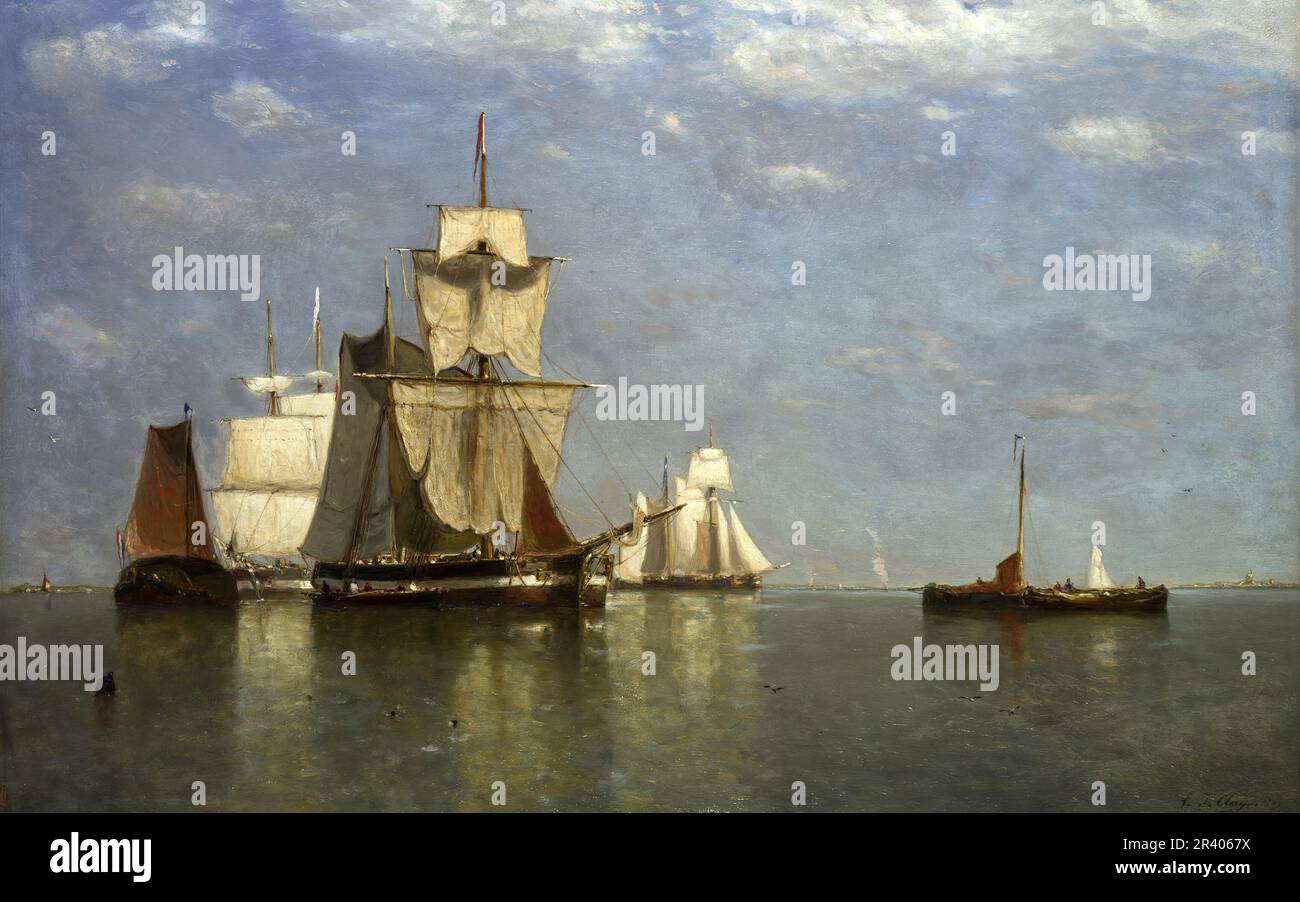 Full title: Ships lying off Flushing Artist: Paul Jean Clays Date made: 1869 Stock Photohttps://www.alamy.com/image-license-details/?v=1https://www.alamy.com/full-title-ships-lying-off-flushing-artist-paul-jean-clays-date-made-1869-image553195326.html
Full title: Ships lying off Flushing Artist: Paul Jean Clays Date made: 1869 Stock Photohttps://www.alamy.com/image-license-details/?v=1https://www.alamy.com/full-title-ships-lying-off-flushing-artist-paul-jean-clays-date-made-1869-image553195326.htmlRF2R4067X–Full title: Ships lying off Flushing Artist: Paul Jean Clays Date made: 1869
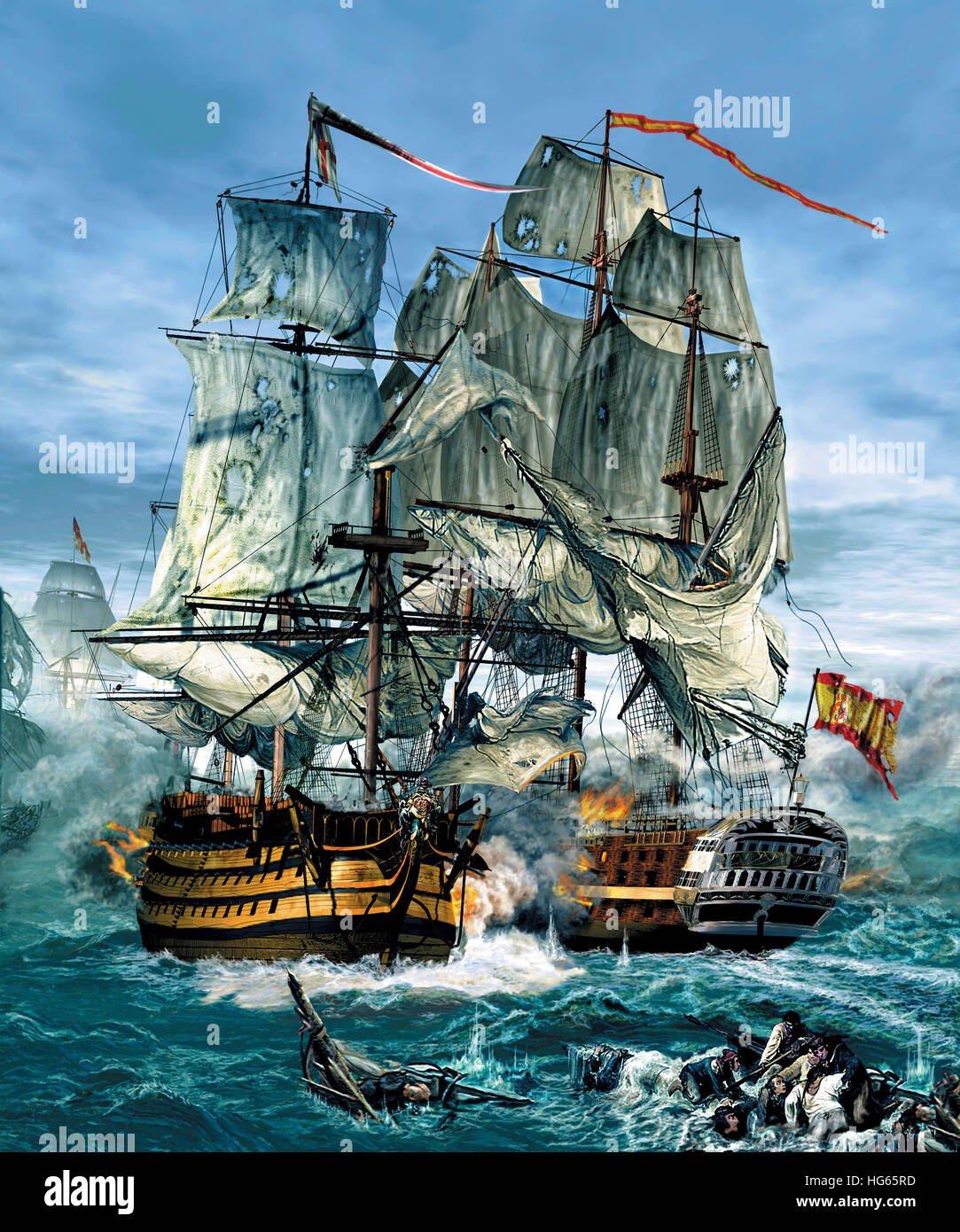 Naval warfare was dominated by sailing ships from the 16th to the mid 19th century. Stock Photohttps://www.alamy.com/image-license-details/?v=1https://www.alamy.com/stock-photo-naval-warfare-was-dominated-by-sailing-ships-from-the-16th-to-the-130443361.html
Naval warfare was dominated by sailing ships from the 16th to the mid 19th century. Stock Photohttps://www.alamy.com/image-license-details/?v=1https://www.alamy.com/stock-photo-naval-warfare-was-dominated-by-sailing-ships-from-the-16th-to-the-130443361.htmlRMHG65RD–Naval warfare was dominated by sailing ships from the 16th to the mid 19th century.
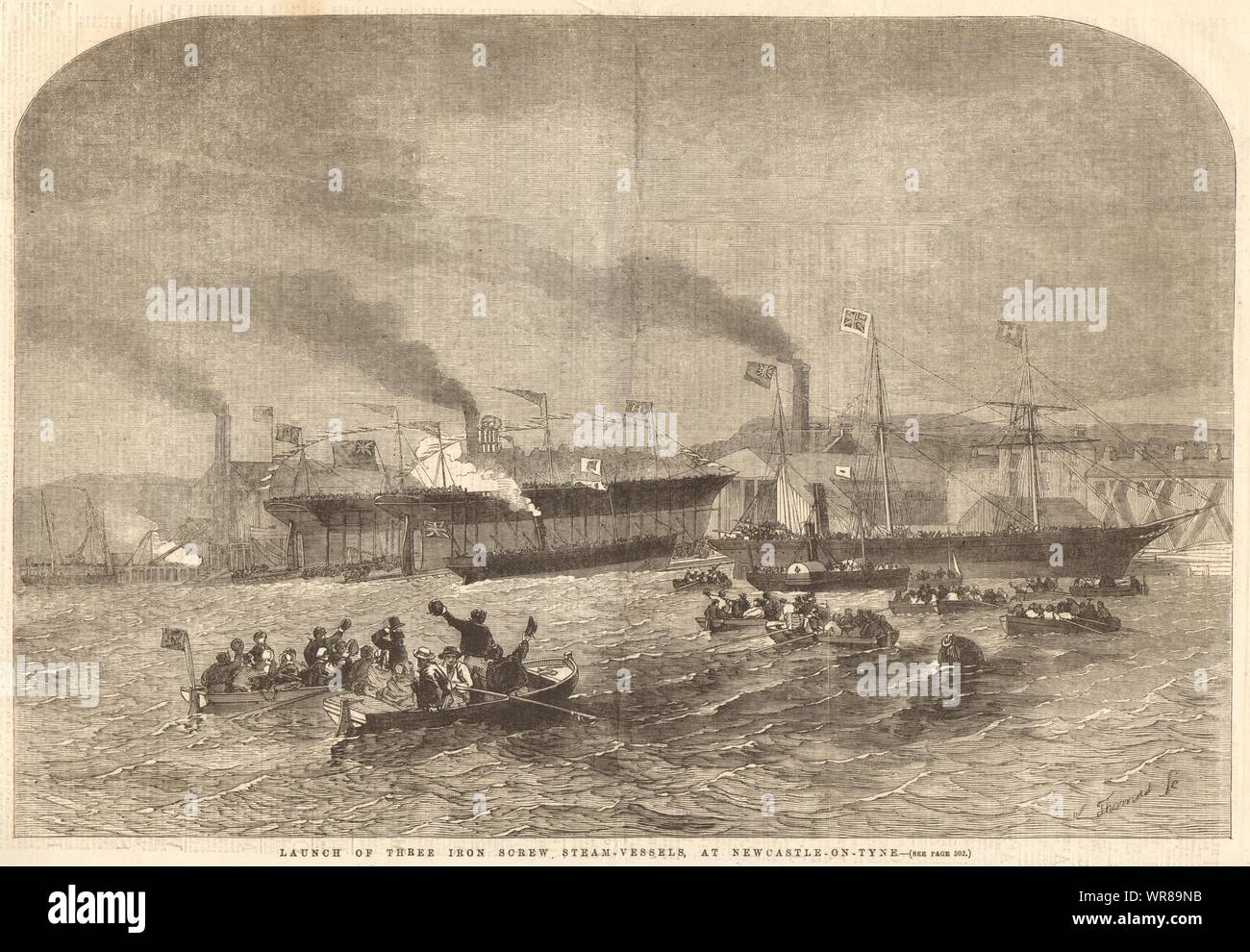 Launch of three iron screw steam-vessels, at Newcastle-on-Tyne. Ships 1856 Stock Photohttps://www.alamy.com/image-license-details/?v=1https://www.alamy.com/launch-of-three-iron-screw-steam-vessels-at-newcastle-on-tyne-ships-1856-image272475879.html
Launch of three iron screw steam-vessels, at Newcastle-on-Tyne. Ships 1856 Stock Photohttps://www.alamy.com/image-license-details/?v=1https://www.alamy.com/launch-of-three-iron-screw-steam-vessels-at-newcastle-on-tyne-ships-1856-image272475879.htmlRFWR89NB–Launch of three iron screw steam-vessels, at Newcastle-on-Tyne. Ships 1856
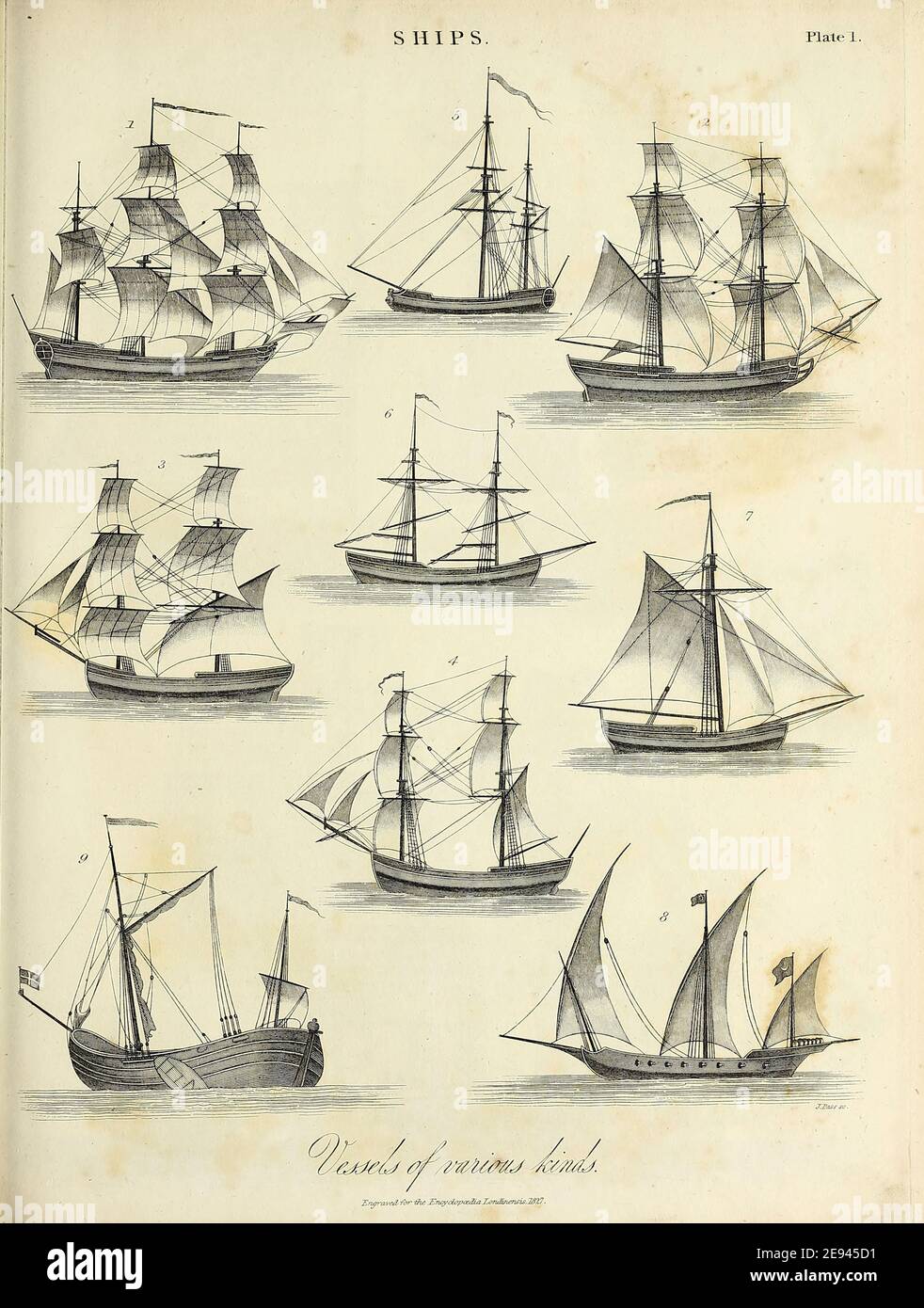 Ships Vessels of various kind Copperplate engraving From the Encyclopaedia Londinensis or, Universal dictionary of arts, sciences, and literature; Volume XXIII; Edited by Wilkes, John. Published in London in 1828 Stock Photohttps://www.alamy.com/image-license-details/?v=1https://www.alamy.com/ships-vessels-of-various-kind-copperplate-engraving-from-the-encyclopaedia-londinensis-or-universal-dictionary-of-arts-sciences-and-literature-volume-xxiii-edited-by-wilkes-john-published-in-london-in-1828-image401462461.html
Ships Vessels of various kind Copperplate engraving From the Encyclopaedia Londinensis or, Universal dictionary of arts, sciences, and literature; Volume XXIII; Edited by Wilkes, John. Published in London in 1828 Stock Photohttps://www.alamy.com/image-license-details/?v=1https://www.alamy.com/ships-vessels-of-various-kind-copperplate-engraving-from-the-encyclopaedia-londinensis-or-universal-dictionary-of-arts-sciences-and-literature-volume-xxiii-edited-by-wilkes-john-published-in-london-in-1828-image401462461.htmlRF2E945D1–Ships Vessels of various kind Copperplate engraving From the Encyclopaedia Londinensis or, Universal dictionary of arts, sciences, and literature; Volume XXIII; Edited by Wilkes, John. Published in London in 1828
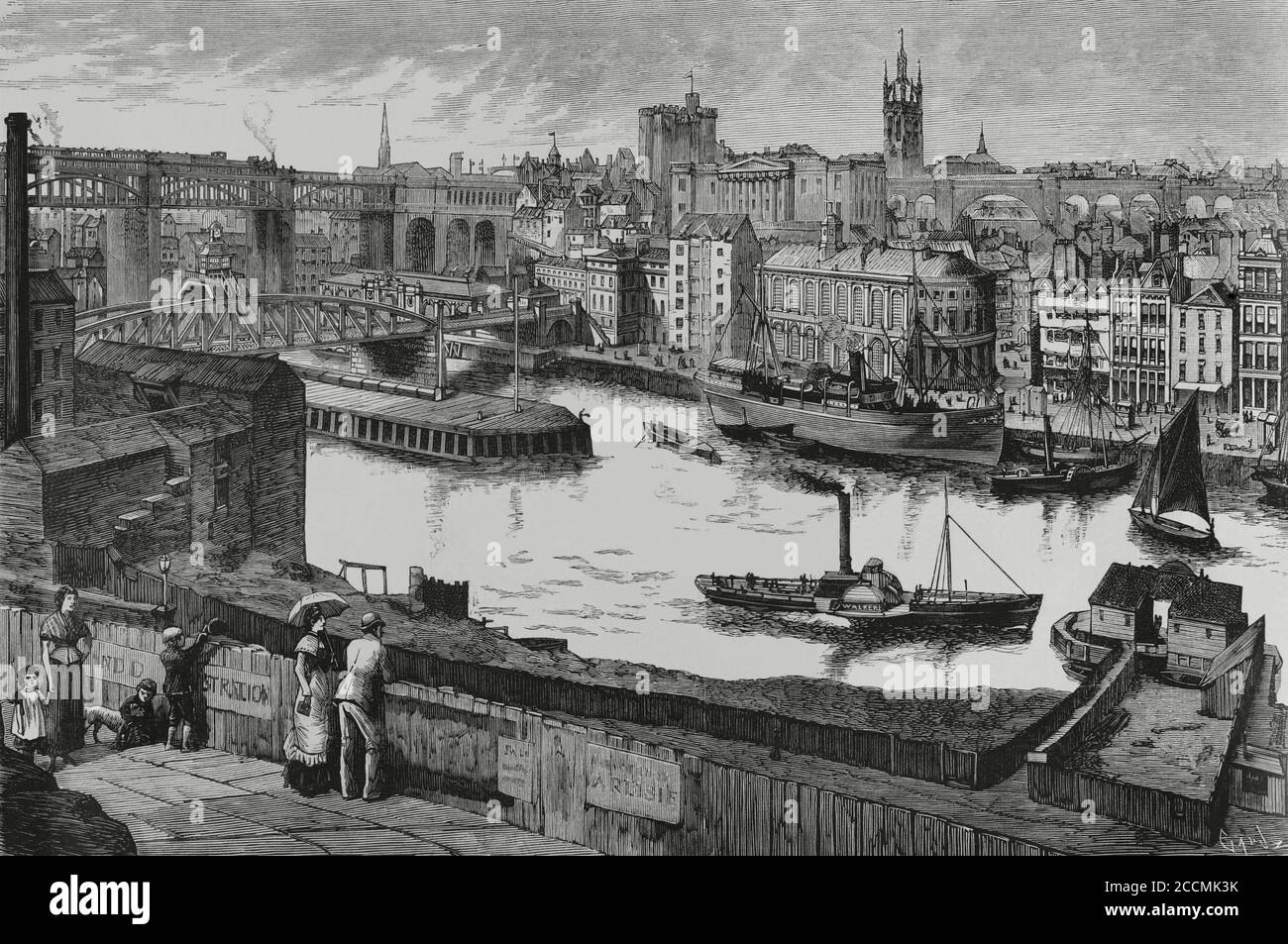 United Kingdom, England, Newcastle. View of the city on the banks of the river Tyne. Important commercial and manufacturing center. Engraving by Tomas Carlos Capuz (1834-1899). La Ilustracion Española y Americana, 1881. Stock Photohttps://www.alamy.com/image-license-details/?v=1https://www.alamy.com/united-kingdom-england-newcastle-view-of-the-city-on-the-banks-of-the-river-tyne-important-commercial-and-manufacturing-center-engraving-by-tomas-carlos-capuz-1834-1899-la-ilustracion-espaola-y-americana-1881-image369247639.html
United Kingdom, England, Newcastle. View of the city on the banks of the river Tyne. Important commercial and manufacturing center. Engraving by Tomas Carlos Capuz (1834-1899). La Ilustracion Española y Americana, 1881. Stock Photohttps://www.alamy.com/image-license-details/?v=1https://www.alamy.com/united-kingdom-england-newcastle-view-of-the-city-on-the-banks-of-the-river-tyne-important-commercial-and-manufacturing-center-engraving-by-tomas-carlos-capuz-1834-1899-la-ilustracion-espaola-y-americana-1881-image369247639.htmlRM2CCMK3K–United Kingdom, England, Newcastle. View of the city on the banks of the river Tyne. Important commercial and manufacturing center. Engraving by Tomas Carlos Capuz (1834-1899). La Ilustracion Española y Americana, 1881.
 Engraving the 'North Star' towed by steam-frigate Stromboli to search for the lost Arctic expedition of Sir John Franklin Stock Photohttps://www.alamy.com/image-license-details/?v=1https://www.alamy.com/stock-photo-engraving-the-north-star-towed-by-steam-frigate-stromboli-to-search-32868145.html
Engraving the 'North Star' towed by steam-frigate Stromboli to search for the lost Arctic expedition of Sir John Franklin Stock Photohttps://www.alamy.com/image-license-details/?v=1https://www.alamy.com/stock-photo-engraving-the-north-star-towed-by-steam-frigate-stromboli-to-search-32868145.htmlRMBWD7J9–Engraving the 'North Star' towed by steam-frigate Stromboli to search for the lost Arctic expedition of Sir John Franklin
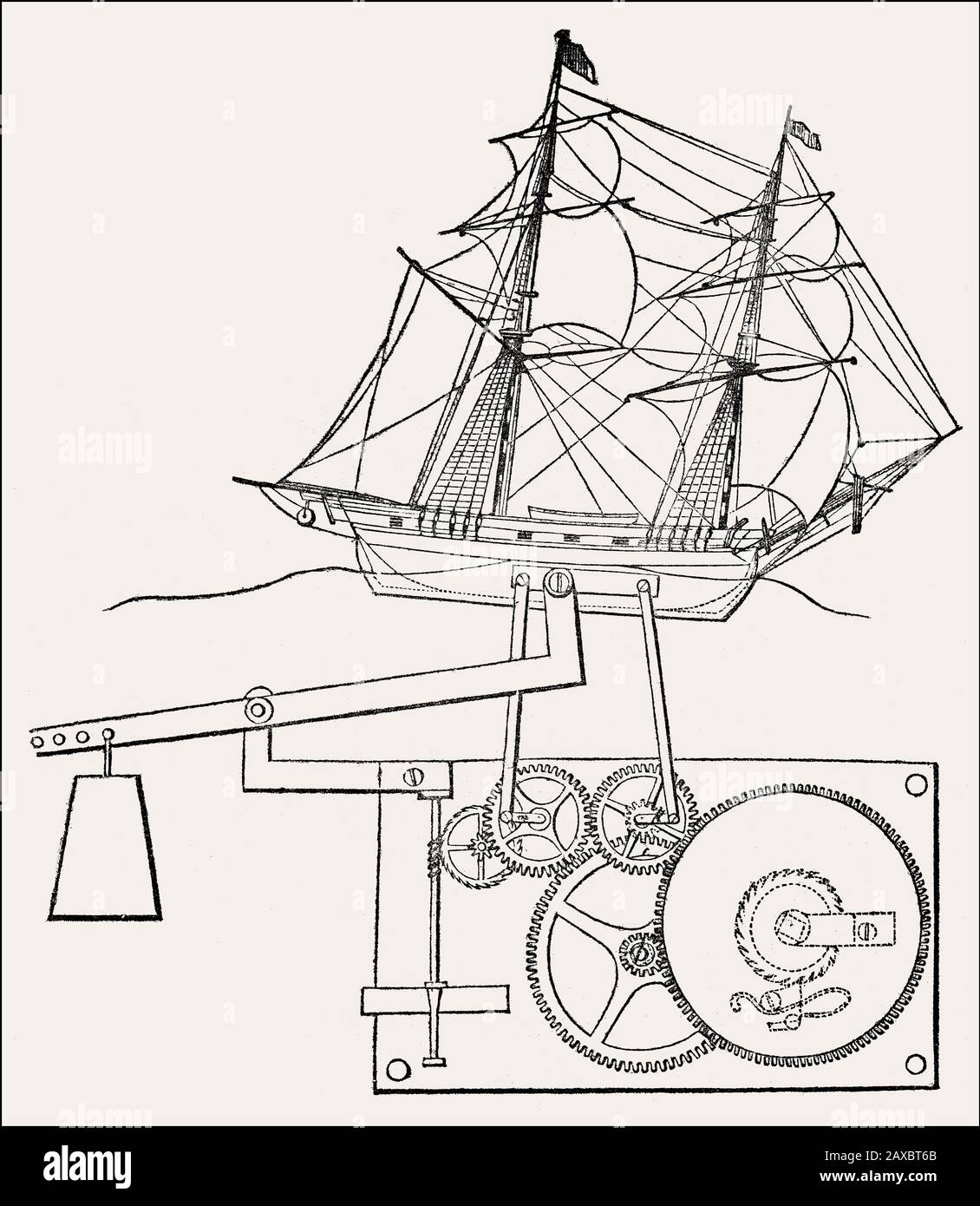 Ship stabilizer, 19th century Stock Photohttps://www.alamy.com/image-license-details/?v=1https://www.alamy.com/ship-stabilizer-19th-century-image343238515.html
Ship stabilizer, 19th century Stock Photohttps://www.alamy.com/image-license-details/?v=1https://www.alamy.com/ship-stabilizer-19th-century-image343238515.htmlRM2AXBT6B–Ship stabilizer, 19th century
 Egypt. Suez Canal. View of the entrance to Port Said (on the Mediterranean shore). Engraving by Rico, 1882. Stock Photohttps://www.alamy.com/image-license-details/?v=1https://www.alamy.com/egypt-suez-canal-view-of-the-entrance-to-port-said-on-the-mediterranean-shore-engraving-by-rico-1882-image469988692.html
Egypt. Suez Canal. View of the entrance to Port Said (on the Mediterranean shore). Engraving by Rico, 1882. Stock Photohttps://www.alamy.com/image-license-details/?v=1https://www.alamy.com/egypt-suez-canal-view-of-the-entrance-to-port-said-on-the-mediterranean-shore-engraving-by-rico-1882-image469988692.htmlRM2J8HRAC–Egypt. Suez Canal. View of the entrance to Port Said (on the Mediterranean shore). Engraving by Rico, 1882.
 Canadian Pacific Steamship Line 1884 This oldest poster from 1884 showcases a steamship at sea, illustrating the ruggedness and industrial prowess of early Canadian Pacific vessels. The text highlights the names of specific ships and the destinations they service, along with promises of luxury features like electric lights. The style is very much of its time, with detailed maritime artwork and ornate typography that was common in the late 19th century. Stock Photohttps://www.alamy.com/image-license-details/?v=1https://www.alamy.com/canadian-pacific-steamship-line-1884-this-oldest-poster-from-1884-showcases-a-steamship-at-sea-illustrating-the-ruggedness-and-industrial-prowess-of-early-canadian-pacific-vessels-the-text-highlights-the-names-of-specific-ships-and-the-destinations-they-service-along-with-promises-of-luxury-features-like-electric-lights-the-style-is-very-much-of-its-time-with-detailed-maritime-artwork-and-ornate-typography-that-was-common-in-the-late-19th-century-image593189933.html
Canadian Pacific Steamship Line 1884 This oldest poster from 1884 showcases a steamship at sea, illustrating the ruggedness and industrial prowess of early Canadian Pacific vessels. The text highlights the names of specific ships and the destinations they service, along with promises of luxury features like electric lights. The style is very much of its time, with detailed maritime artwork and ornate typography that was common in the late 19th century. Stock Photohttps://www.alamy.com/image-license-details/?v=1https://www.alamy.com/canadian-pacific-steamship-line-1884-this-oldest-poster-from-1884-showcases-a-steamship-at-sea-illustrating-the-ruggedness-and-industrial-prowess-of-early-canadian-pacific-vessels-the-text-highlights-the-names-of-specific-ships-and-the-destinations-they-service-along-with-promises-of-luxury-features-like-electric-lights-the-style-is-very-much-of-its-time-with-detailed-maritime-artwork-and-ornate-typography-that-was-common-in-the-late-19th-century-image593189933.htmlRM2WD23PN–Canadian Pacific Steamship Line 1884 This oldest poster from 1884 showcases a steamship at sea, illustrating the ruggedness and industrial prowess of early Canadian Pacific vessels. The text highlights the names of specific ships and the destinations they service, along with promises of luxury features like electric lights. The style is very much of its time, with detailed maritime artwork and ornate typography that was common in the late 19th century.
 Arrival of the Great Stamship of NY, monday 23rd April 1828. Oil on canvas, 1810. By Joseph Waltre (1783-1856). Stock Photohttps://www.alamy.com/image-license-details/?v=1https://www.alamy.com/arrival-of-the-great-stamship-of-ny-monday-23rd-april-1828-oil-on-canvas-1810-by-joseph-waltre-1783-1856-image237518149.html
Arrival of the Great Stamship of NY, monday 23rd April 1828. Oil on canvas, 1810. By Joseph Waltre (1783-1856). Stock Photohttps://www.alamy.com/image-license-details/?v=1https://www.alamy.com/arrival-of-the-great-stamship-of-ny-monday-23rd-april-1828-oil-on-canvas-1810-by-joseph-waltre-1783-1856-image237518149.htmlRMRPBTR1–Arrival of the Great Stamship of NY, monday 23rd April 1828. Oil on canvas, 1810. By Joseph Waltre (1783-1856).
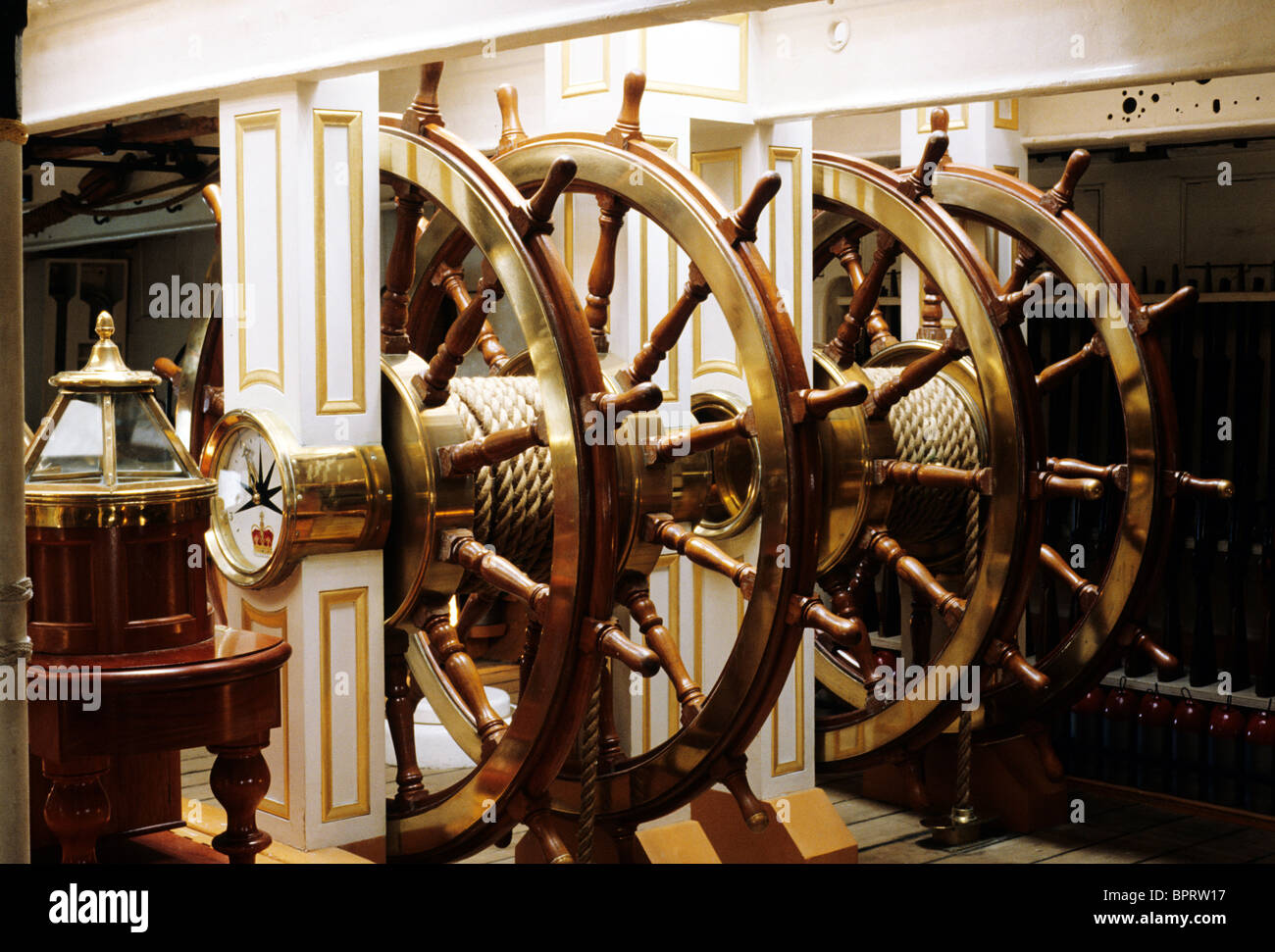 Portsmouth, HMS Warrior, Wheel House, Steering Room English British Victorian 19th century war ships warships Hampshire England Stock Photohttps://www.alamy.com/image-license-details/?v=1https://www.alamy.com/stock-photo-portsmouth-hms-warrior-wheel-house-steering-room-english-british-victorian-31257331.html
Portsmouth, HMS Warrior, Wheel House, Steering Room English British Victorian 19th century war ships warships Hampshire England Stock Photohttps://www.alamy.com/image-license-details/?v=1https://www.alamy.com/stock-photo-portsmouth-hms-warrior-wheel-house-steering-room-english-british-victorian-31257331.htmlRMBPRW17–Portsmouth, HMS Warrior, Wheel House, Steering Room English British Victorian 19th century war ships warships Hampshire England
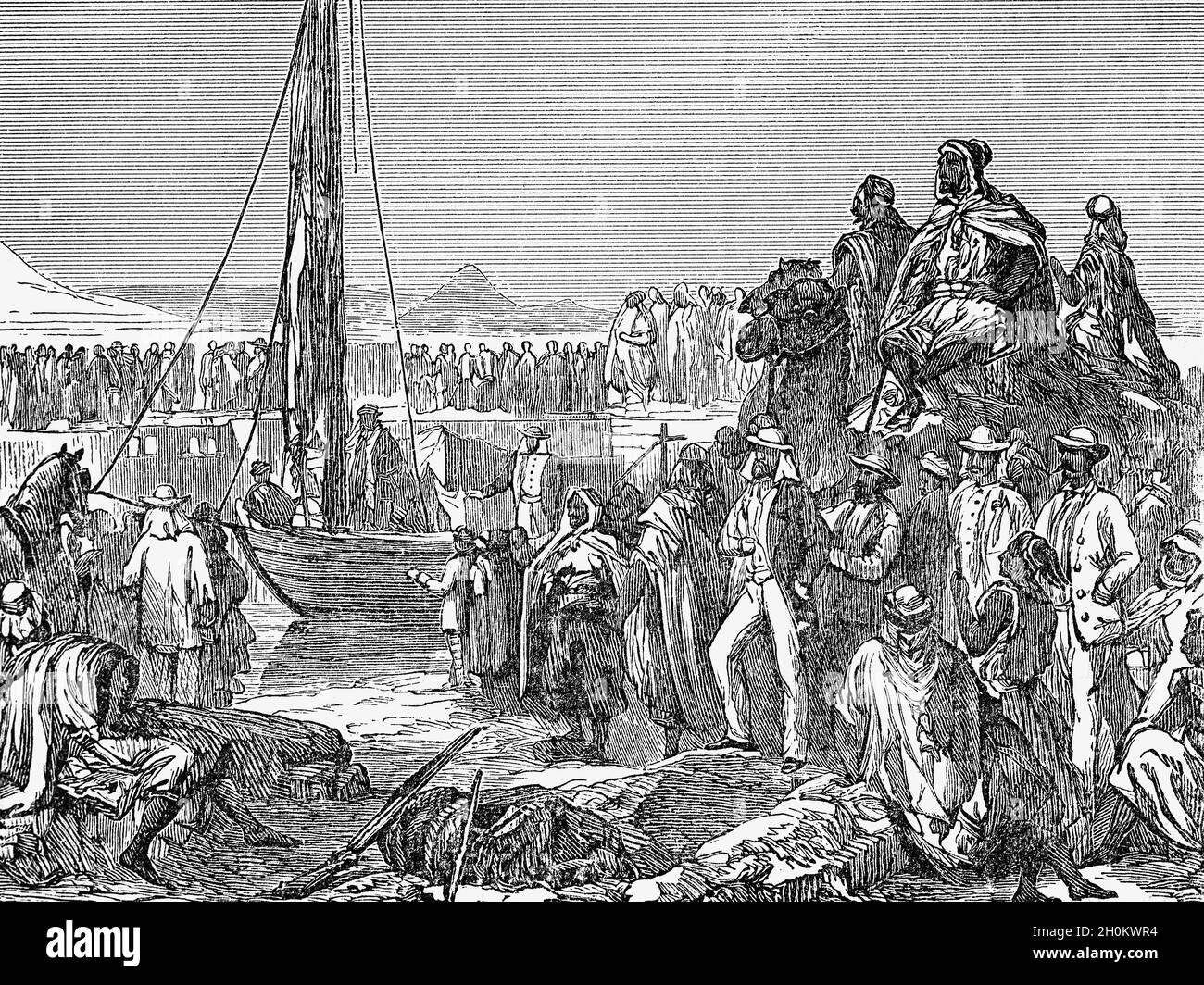 A late 19th Century illustration of the opening of the Suez Canal under French control in November 1869. The canal passes through the Isthmus of Suez offering vessels a direct route between the North Atlantic and northern Indian oceans via the Mediterranean Sea and the Red Sea, avoiding the South Atlantic and southern Indian oceans and reducing the journey distance from the Arabian Sea to London by approximately 8,900 kilometres (5,500 miles). The canal opened with an audience of royalty and a procession of ships on the morning of 17 November. Stock Photohttps://www.alamy.com/image-license-details/?v=1https://www.alamy.com/a-late-19th-century-illustration-of-the-opening-of-the-suez-canal-under-french-control-in-november-1869-the-canal-passes-through-the-isthmus-of-suez-offering-vessels-a-direct-route-between-the-north-atlantic-and-northern-indian-oceans-via-the-mediterranean-sea-and-the-red-sea-avoiding-the-south-atlantic-and-southern-indian-oceans-and-reducing-the-journey-distance-from-the-arabian-sea-to-london-by-approximately-8900-kilometres-5500-miles-the-canal-opened-with-an-audience-of-royalty-and-a-procession-of-ships-on-the-morning-of-17-november-image447906904.html
A late 19th Century illustration of the opening of the Suez Canal under French control in November 1869. The canal passes through the Isthmus of Suez offering vessels a direct route between the North Atlantic and northern Indian oceans via the Mediterranean Sea and the Red Sea, avoiding the South Atlantic and southern Indian oceans and reducing the journey distance from the Arabian Sea to London by approximately 8,900 kilometres (5,500 miles). The canal opened with an audience of royalty and a procession of ships on the morning of 17 November. Stock Photohttps://www.alamy.com/image-license-details/?v=1https://www.alamy.com/a-late-19th-century-illustration-of-the-opening-of-the-suez-canal-under-french-control-in-november-1869-the-canal-passes-through-the-isthmus-of-suez-offering-vessels-a-direct-route-between-the-north-atlantic-and-northern-indian-oceans-via-the-mediterranean-sea-and-the-red-sea-avoiding-the-south-atlantic-and-southern-indian-oceans-and-reducing-the-journey-distance-from-the-arabian-sea-to-london-by-approximately-8900-kilometres-5500-miles-the-canal-opened-with-an-audience-of-royalty-and-a-procession-of-ships-on-the-morning-of-17-november-image447906904.htmlRM2H0KWR4–A late 19th Century illustration of the opening of the Suez Canal under French control in November 1869. The canal passes through the Isthmus of Suez offering vessels a direct route between the North Atlantic and northern Indian oceans via the Mediterranean Sea and the Red Sea, avoiding the South Atlantic and southern Indian oceans and reducing the journey distance from the Arabian Sea to London by approximately 8,900 kilometres (5,500 miles). The canal opened with an audience of royalty and a procession of ships on the morning of 17 November.
![The Custom-House and inner harbour, Colombo, Ceylon [now Sri Lanka], 1864. Engraving from a photograph by Messrs. Slinn and Co. 'The European capital of Ceylon is not, indeed, a place of much maritime traffic, its port affording shelter to none but light native vessels, while the larger ships which anchor in the offing are exposed to disasters from the violence of the monsoons. It was to the vicinity of the cinnamon-gardens that Colombo owed its selection by the Portuguese in the sixteenth century, and by the Dutch, whose Government was there established at a later date. Coffee, which has now Stock Photo The Custom-House and inner harbour, Colombo, Ceylon [now Sri Lanka], 1864. Engraving from a photograph by Messrs. Slinn and Co. 'The European capital of Ceylon is not, indeed, a place of much maritime traffic, its port affording shelter to none but light native vessels, while the larger ships which anchor in the offing are exposed to disasters from the violence of the monsoons. It was to the vicinity of the cinnamon-gardens that Colombo owed its selection by the Portuguese in the sixteenth century, and by the Dutch, whose Government was there established at a later date. Coffee, which has now Stock Photo](https://c8.alamy.com/comp/2WRGY84/the-custom-house-and-inner-harbour-colombo-ceylon-now-sri-lanka-1864-engraving-from-a-photograph-by-messrs-slinn-and-co-the-european-capital-of-ceylon-is-not-indeed-a-place-of-much-maritime-traffic-its-port-affording-shelter-to-none-but-light-native-vessels-while-the-larger-ships-which-anchor-in-the-offing-are-exposed-to-disasters-from-the-violence-of-the-monsoons-it-was-to-the-vicinity-of-the-cinnamon-gardens-that-colombo-owed-its-selection-by-the-portuguese-in-the-sixteenth-century-and-by-the-dutch-whose-government-was-there-established-at-a-later-date-coffee-which-has-now-2WRGY84.jpg) The Custom-House and inner harbour, Colombo, Ceylon [now Sri Lanka], 1864. Engraving from a photograph by Messrs. Slinn and Co. 'The European capital of Ceylon is not, indeed, a place of much maritime traffic, its port affording shelter to none but light native vessels, while the larger ships which anchor in the offing are exposed to disasters from the violence of the monsoons. It was to the vicinity of the cinnamon-gardens that Colombo owed its selection by the Portuguese in the sixteenth century, and by the Dutch, whose Government was there established at a later date. Coffee, which has now Stock Photohttps://www.alamy.com/image-license-details/?v=1https://www.alamy.com/the-custom-house-and-inner-harbour-colombo-ceylon-now-sri-lanka-1864-engraving-from-a-photograph-by-messrs-slinn-and-co-the-european-capital-of-ceylon-is-not-indeed-a-place-of-much-maritime-traffic-its-port-affording-shelter-to-none-but-light-native-vessels-while-the-larger-ships-which-anchor-in-the-offing-are-exposed-to-disasters-from-the-violence-of-the-monsoons-it-was-to-the-vicinity-of-the-cinnamon-gardens-that-colombo-owed-its-selection-by-the-portuguese-in-the-sixteenth-century-and-by-the-dutch-whose-government-was-there-established-at-a-later-date-coffee-which-has-now-image599662228.html
The Custom-House and inner harbour, Colombo, Ceylon [now Sri Lanka], 1864. Engraving from a photograph by Messrs. Slinn and Co. 'The European capital of Ceylon is not, indeed, a place of much maritime traffic, its port affording shelter to none but light native vessels, while the larger ships which anchor in the offing are exposed to disasters from the violence of the monsoons. It was to the vicinity of the cinnamon-gardens that Colombo owed its selection by the Portuguese in the sixteenth century, and by the Dutch, whose Government was there established at a later date. Coffee, which has now Stock Photohttps://www.alamy.com/image-license-details/?v=1https://www.alamy.com/the-custom-house-and-inner-harbour-colombo-ceylon-now-sri-lanka-1864-engraving-from-a-photograph-by-messrs-slinn-and-co-the-european-capital-of-ceylon-is-not-indeed-a-place-of-much-maritime-traffic-its-port-affording-shelter-to-none-but-light-native-vessels-while-the-larger-ships-which-anchor-in-the-offing-are-exposed-to-disasters-from-the-violence-of-the-monsoons-it-was-to-the-vicinity-of-the-cinnamon-gardens-that-colombo-owed-its-selection-by-the-portuguese-in-the-sixteenth-century-and-by-the-dutch-whose-government-was-there-established-at-a-later-date-coffee-which-has-now-image599662228.htmlRM2WRGY84–The Custom-House and inner harbour, Colombo, Ceylon [now Sri Lanka], 1864. Engraving from a photograph by Messrs. Slinn and Co. 'The European capital of Ceylon is not, indeed, a place of much maritime traffic, its port affording shelter to none but light native vessels, while the larger ships which anchor in the offing are exposed to disasters from the violence of the monsoons. It was to the vicinity of the cinnamon-gardens that Colombo owed its selection by the Portuguese in the sixteenth century, and by the Dutch, whose Government was there established at a later date. Coffee, which has now
 The Canal de l'Ourcq basin, with a length of 108 kilometers. It's the junction between the Canel de l'Ourcq and the River Seine. 19th century Stock Photohttps://www.alamy.com/image-license-details/?v=1https://www.alamy.com/stock-photo-the-canal-de-lourcq-basin-with-a-length-of-108-kilometers-its-the-145403677.html
The Canal de l'Ourcq basin, with a length of 108 kilometers. It's the junction between the Canel de l'Ourcq and the River Seine. 19th century Stock Photohttps://www.alamy.com/image-license-details/?v=1https://www.alamy.com/stock-photo-the-canal-de-lourcq-basin-with-a-length-of-108-kilometers-its-the-145403677.htmlRMJCFKTD–The Canal de l'Ourcq basin, with a length of 108 kilometers. It's the junction between the Canel de l'Ourcq and the River Seine. 19th century
 stamps, Samoa, mint, Germany, 1900, historic, historical, at the turn of the 19th / 20th century, German colony, colonies, from 1899 until 1914, South Sea, Southern Pacific, Pacific Ocean, merchant ship, merchant ships, cargo vessel, trading vessel, cargo vessels, trading vessels, colonial period, philately, 1900s, Additional-Rights-Clearences-Not Available Stock Photohttps://www.alamy.com/image-license-details/?v=1https://www.alamy.com/stock-photo-stamps-samoa-mint-germany-1900-historic-historical-at-the-turn-of-33571289.html
stamps, Samoa, mint, Germany, 1900, historic, historical, at the turn of the 19th / 20th century, German colony, colonies, from 1899 until 1914, South Sea, Southern Pacific, Pacific Ocean, merchant ship, merchant ships, cargo vessel, trading vessel, cargo vessels, trading vessels, colonial period, philately, 1900s, Additional-Rights-Clearences-Not Available Stock Photohttps://www.alamy.com/image-license-details/?v=1https://www.alamy.com/stock-photo-stamps-samoa-mint-germany-1900-historic-historical-at-the-turn-of-33571289.htmlRMBXH8EH–stamps, Samoa, mint, Germany, 1900, historic, historical, at the turn of the 19th / 20th century, German colony, colonies, from 1899 until 1914, South Sea, Southern Pacific, Pacific Ocean, merchant ship, merchant ships, cargo vessel, trading vessel, cargo vessels, trading vessels, colonial period, philately, 1900s, Additional-Rights-Clearences-Not Available
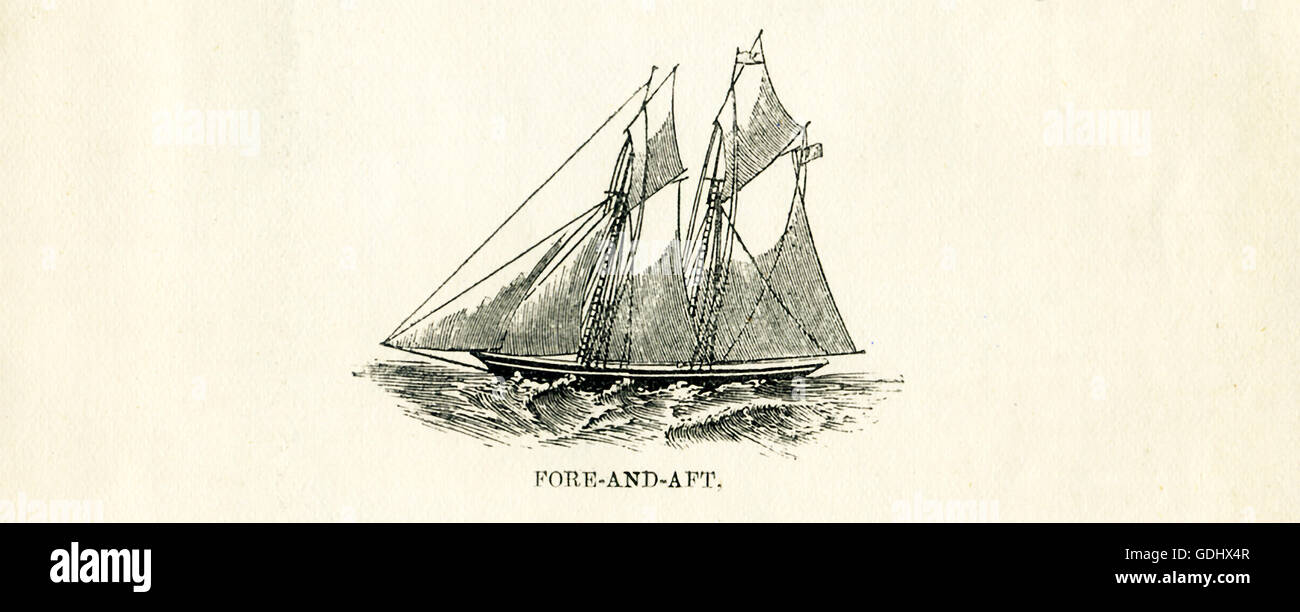 The vessel pictured in this 19th-century drawing is a schooner, specifically a fore-and-aft. Stock Photohttps://www.alamy.com/image-license-details/?v=1https://www.alamy.com/stock-photo-the-vessel-pictured-in-this-19th-century-drawing-is-a-schooner-specifically-111646439.html
The vessel pictured in this 19th-century drawing is a schooner, specifically a fore-and-aft. Stock Photohttps://www.alamy.com/image-license-details/?v=1https://www.alamy.com/stock-photo-the-vessel-pictured-in-this-19th-century-drawing-is-a-schooner-specifically-111646439.htmlRFGDHX4R–The vessel pictured in this 19th-century drawing is a schooner, specifically a fore-and-aft.